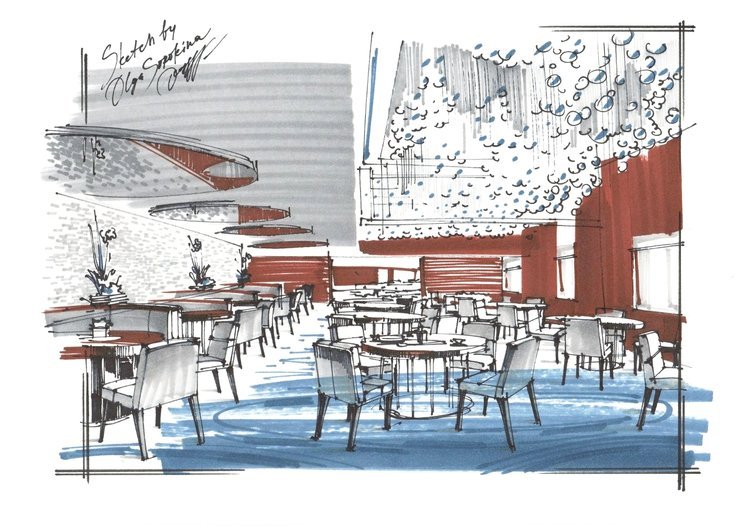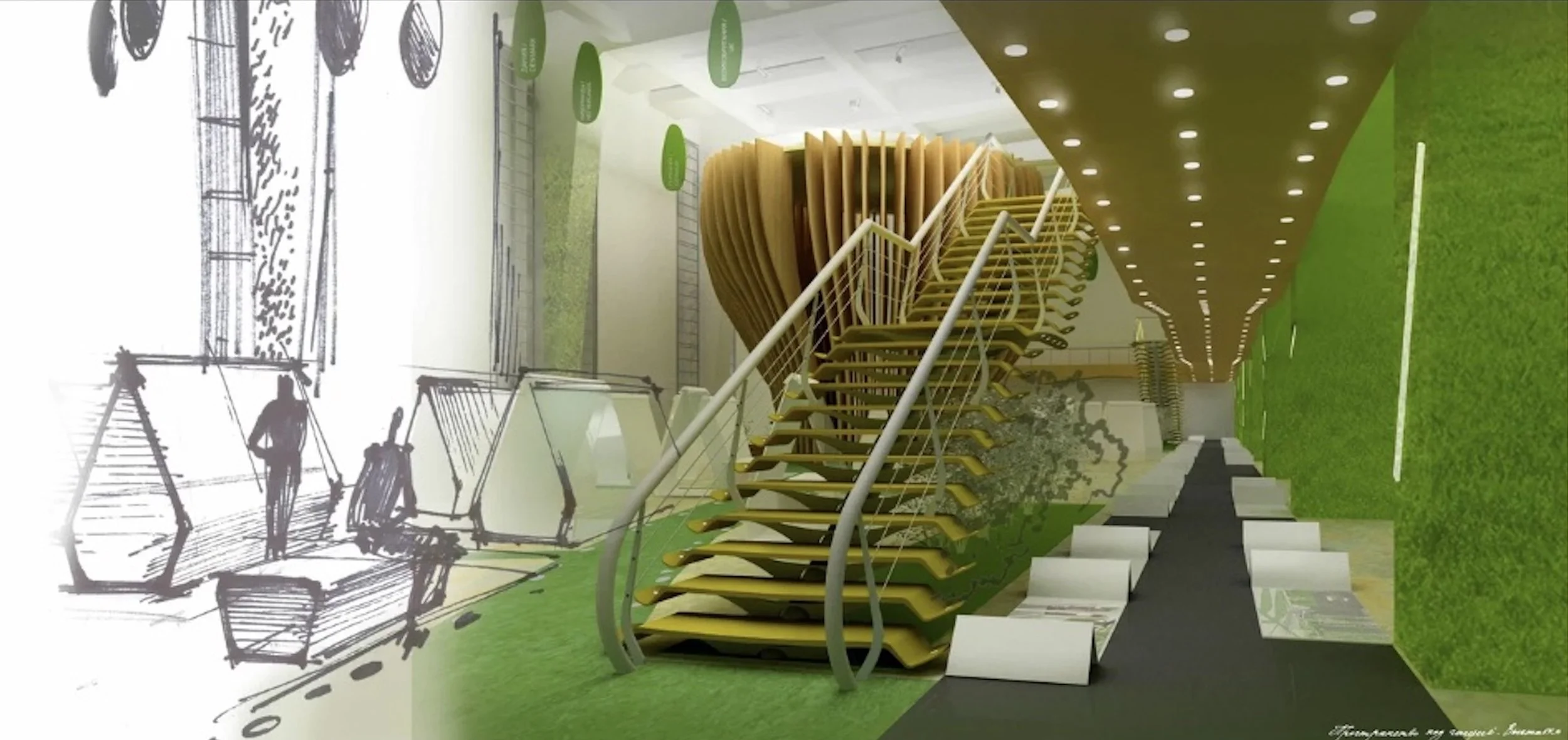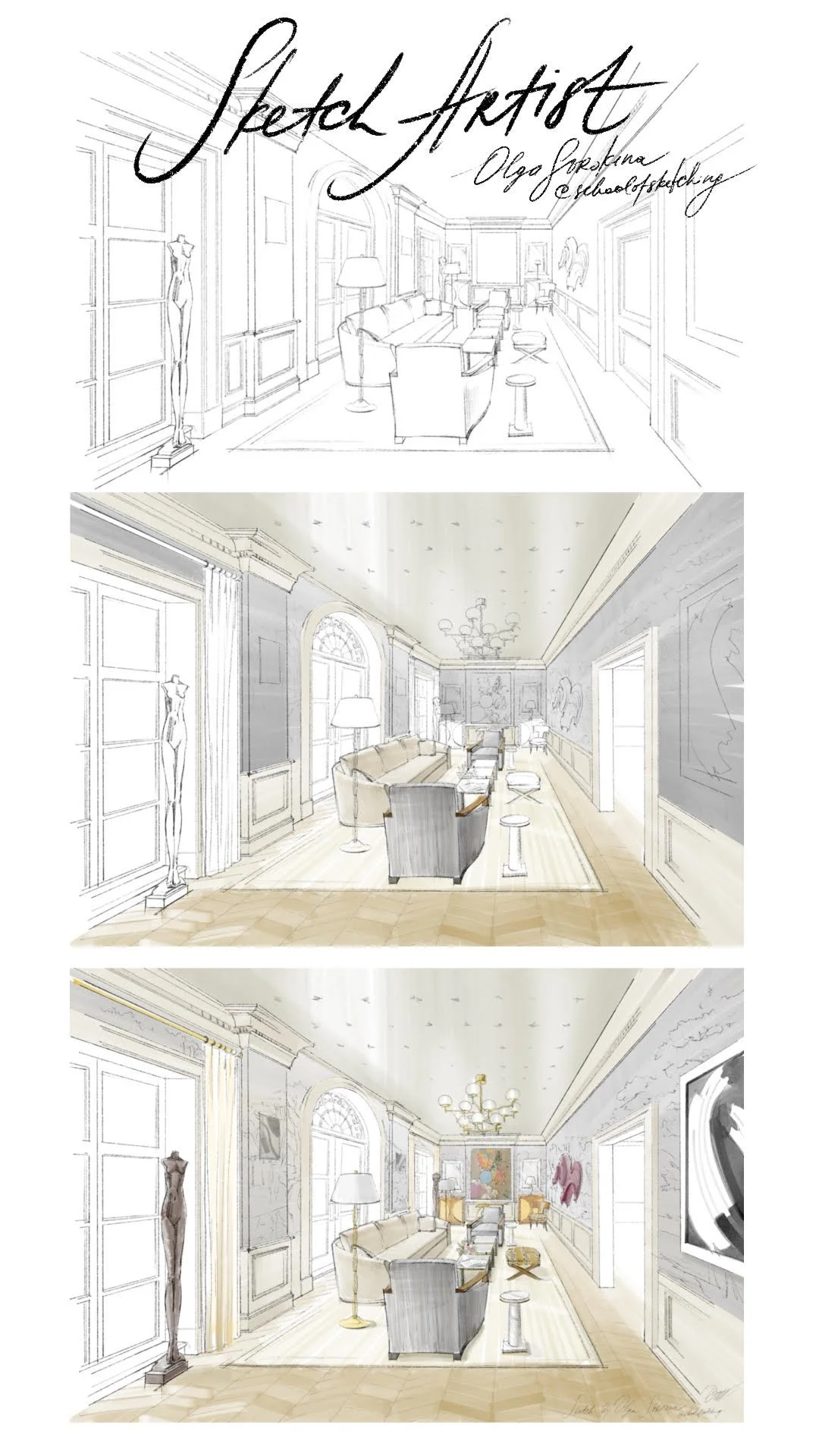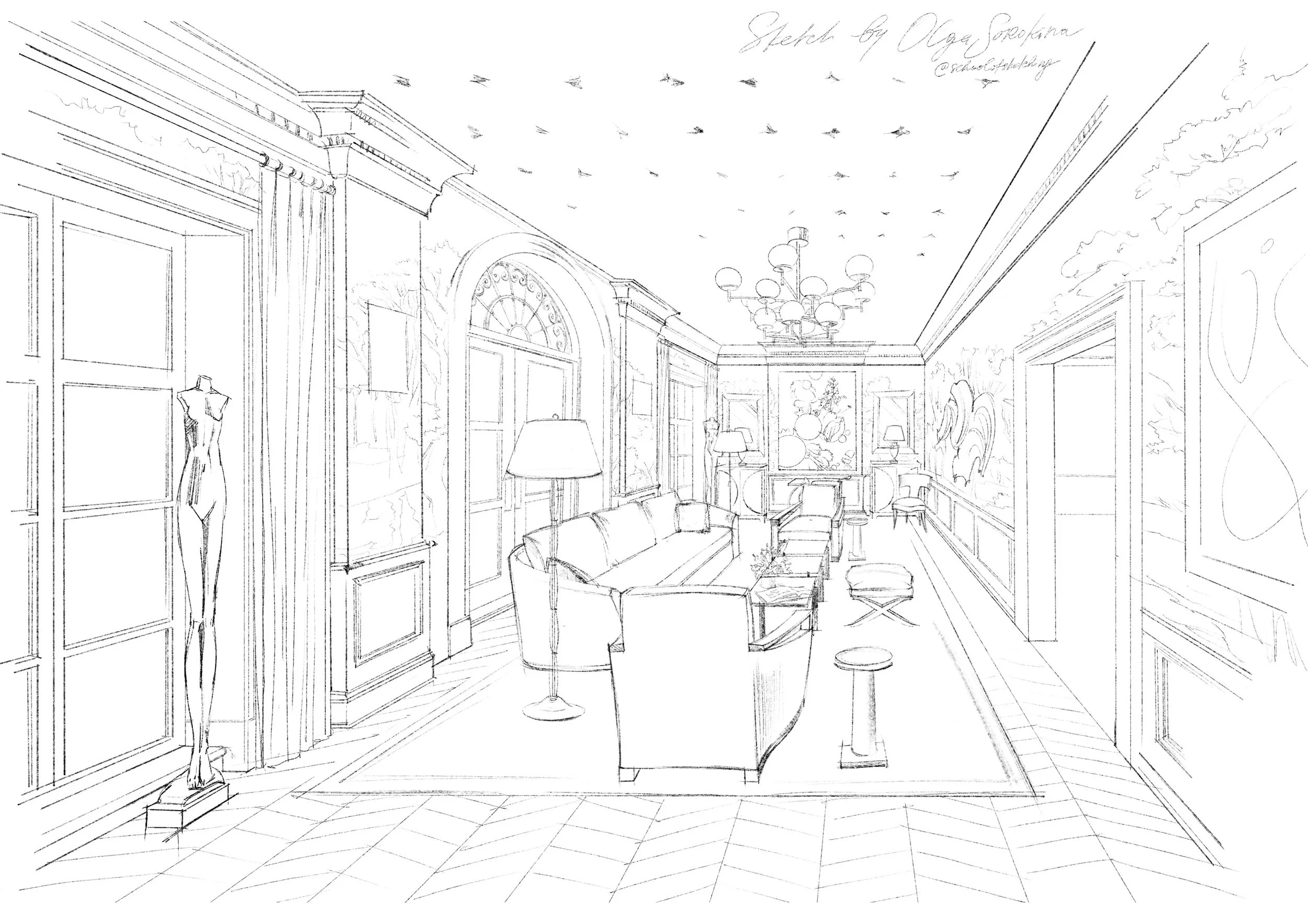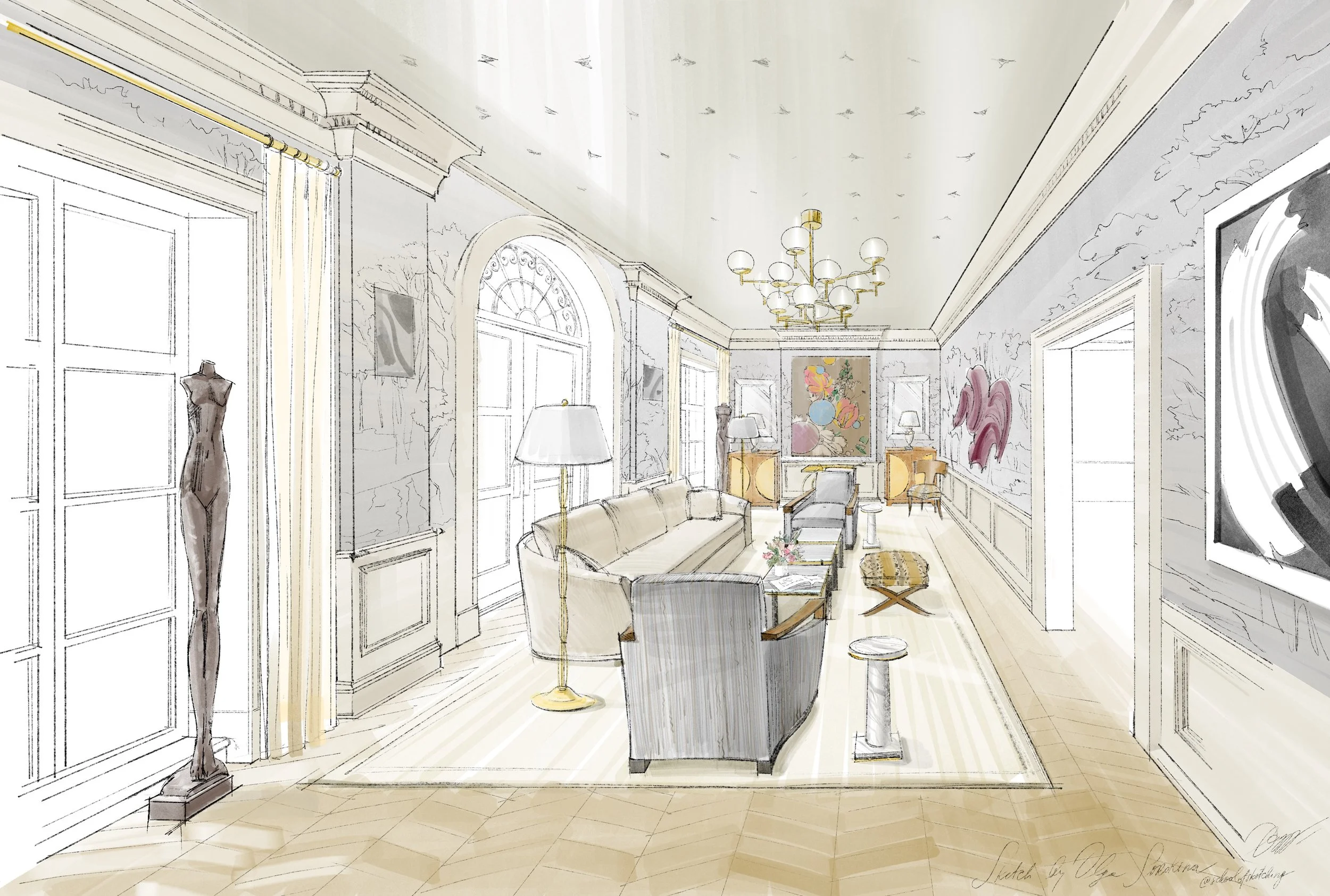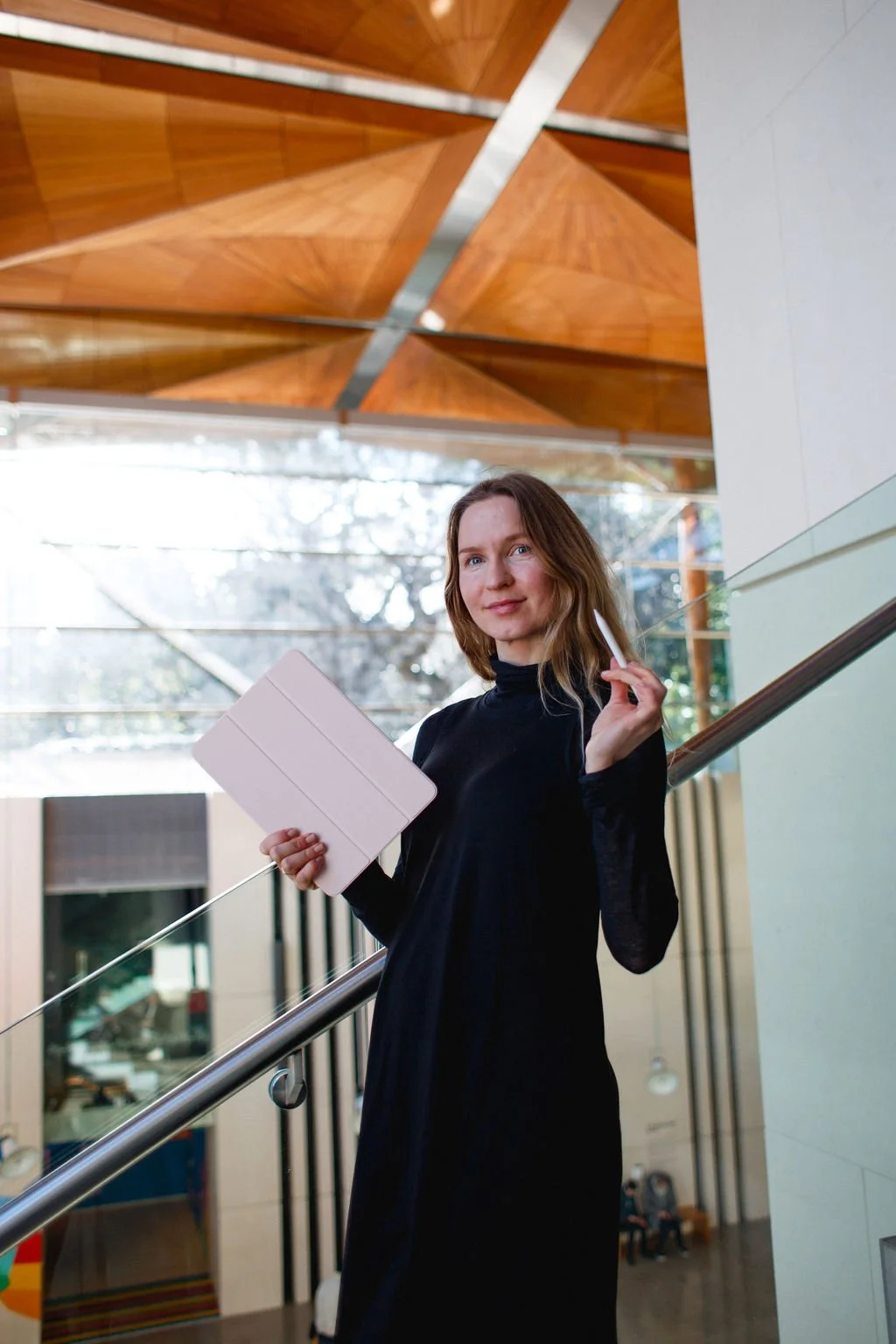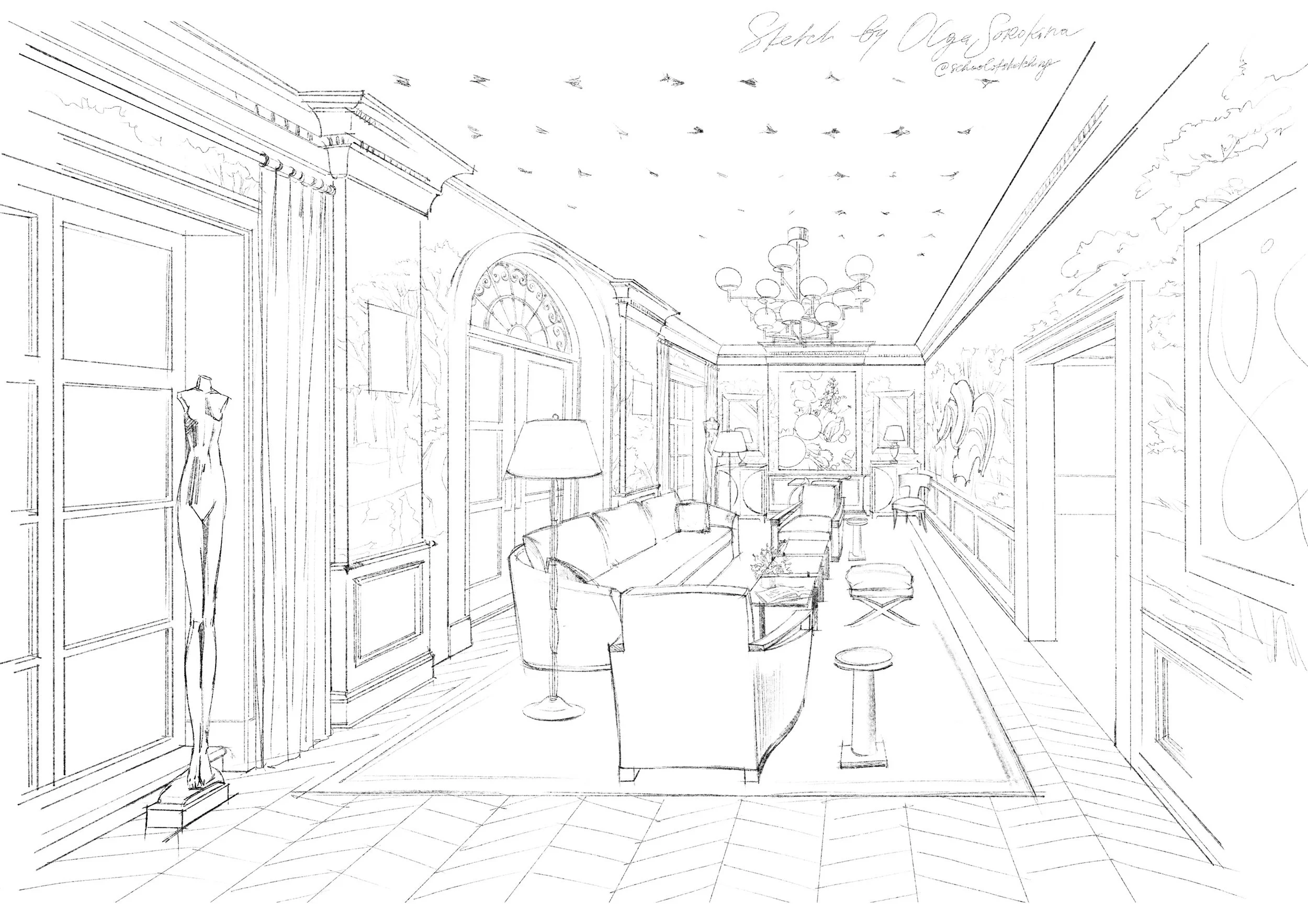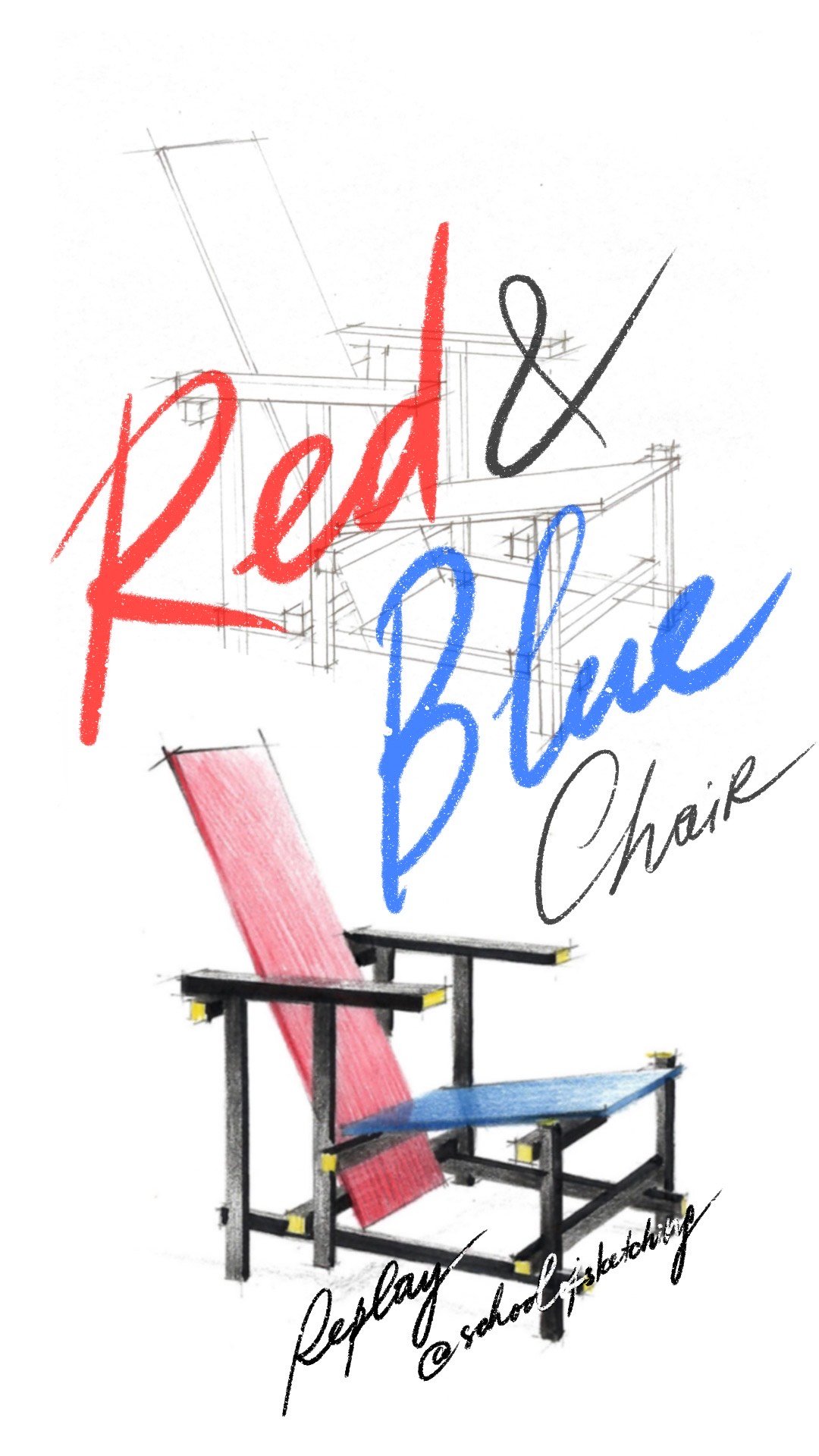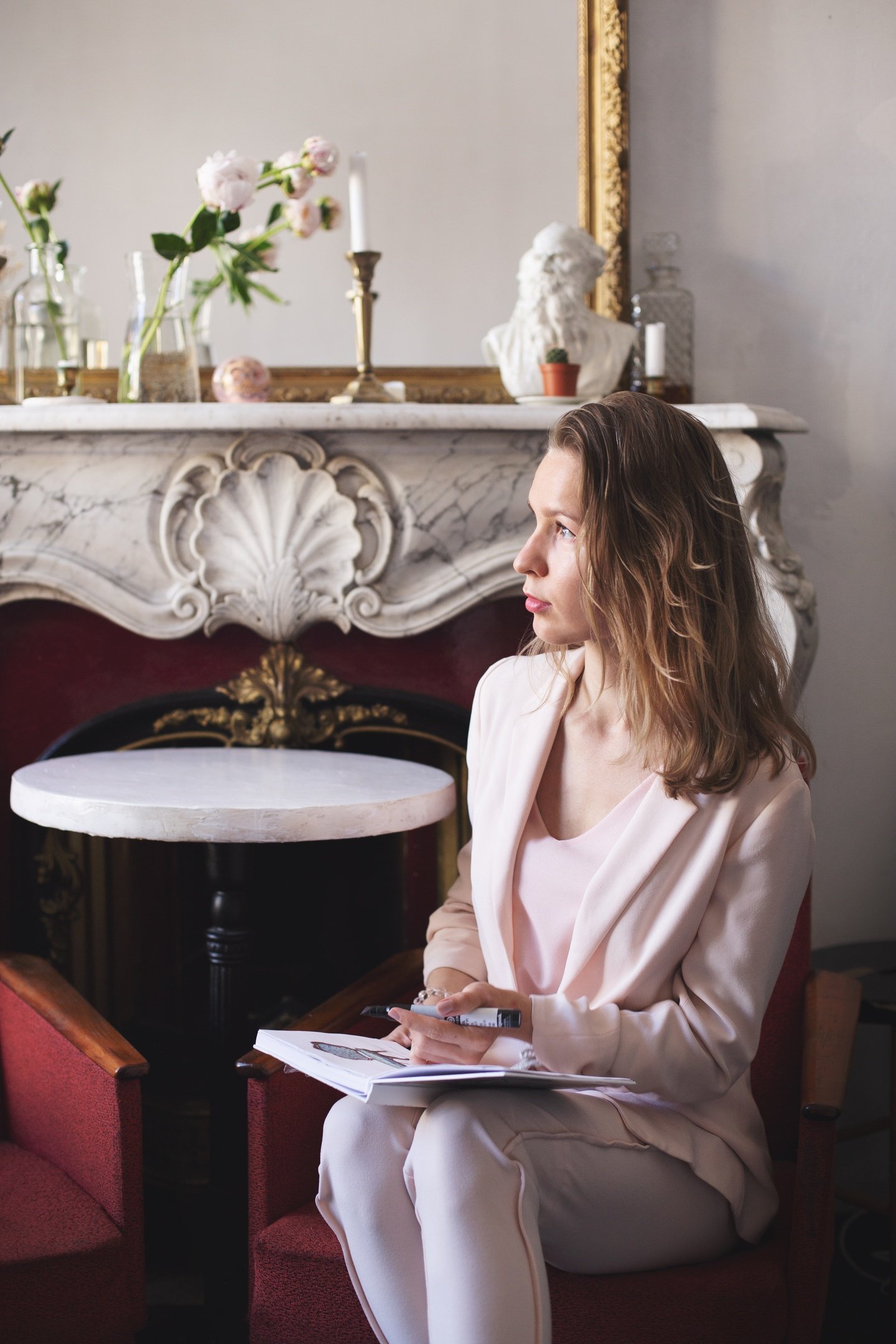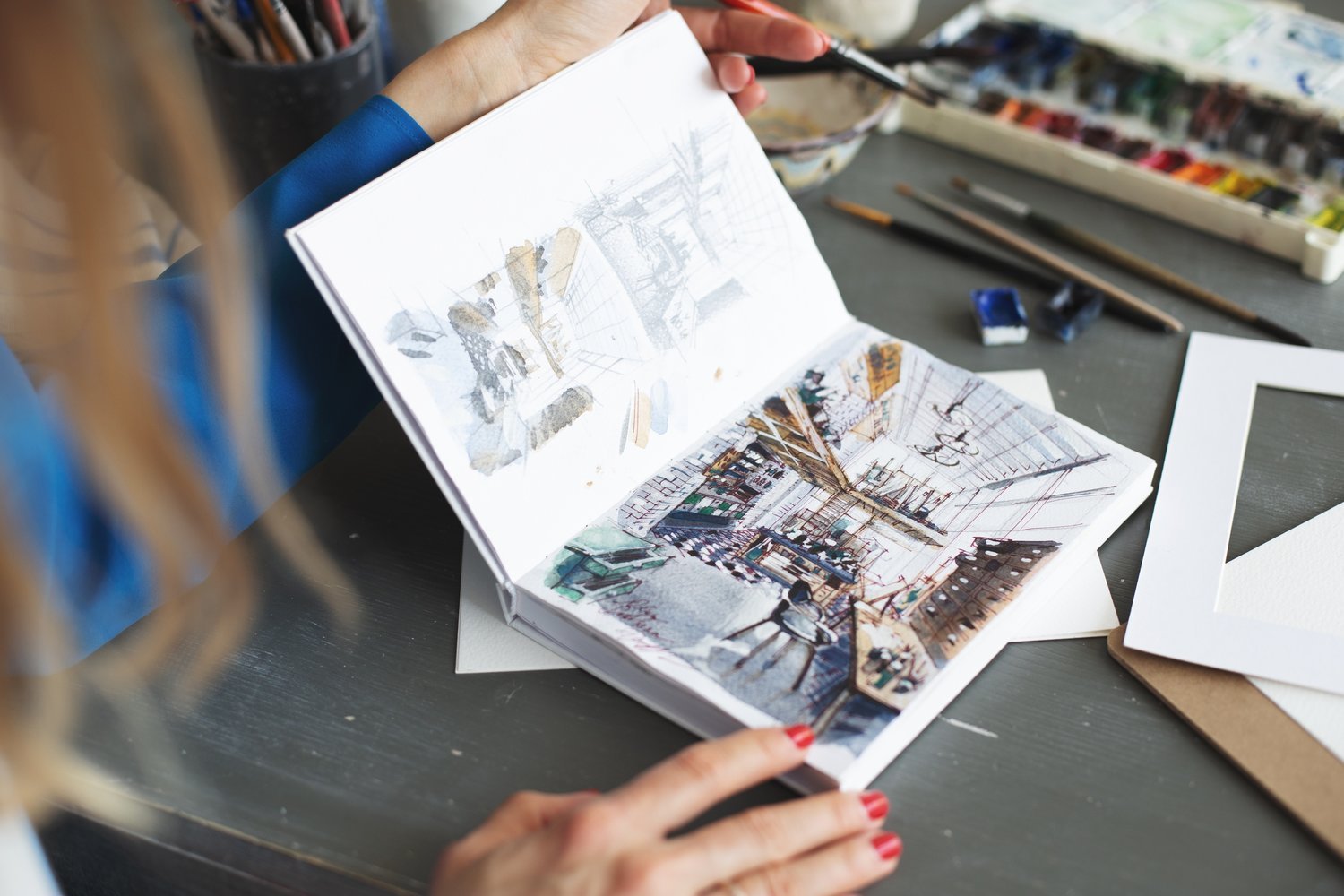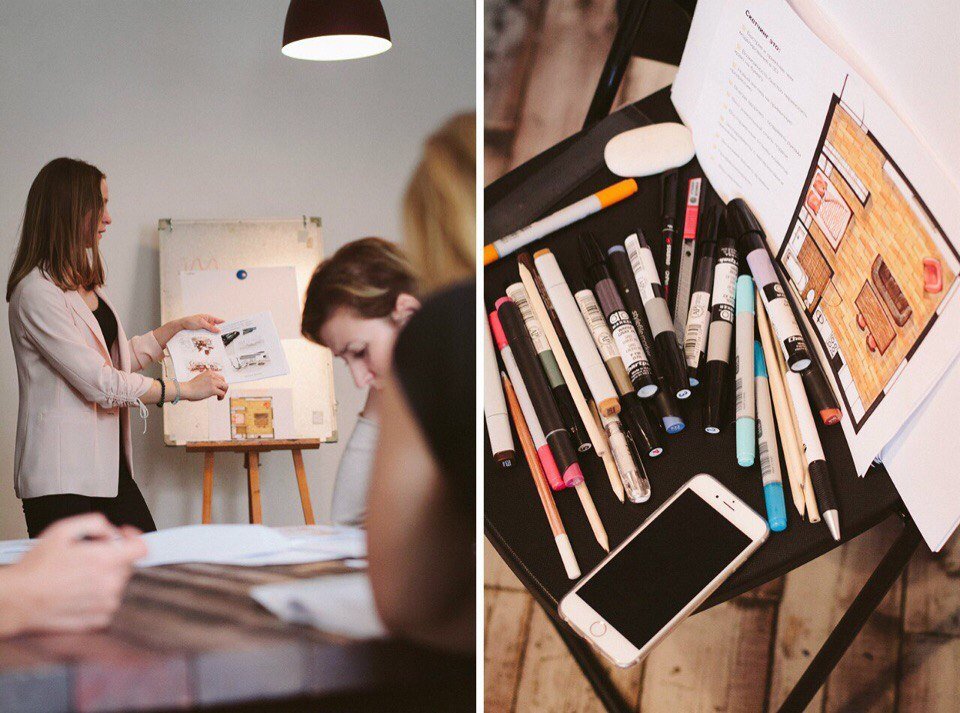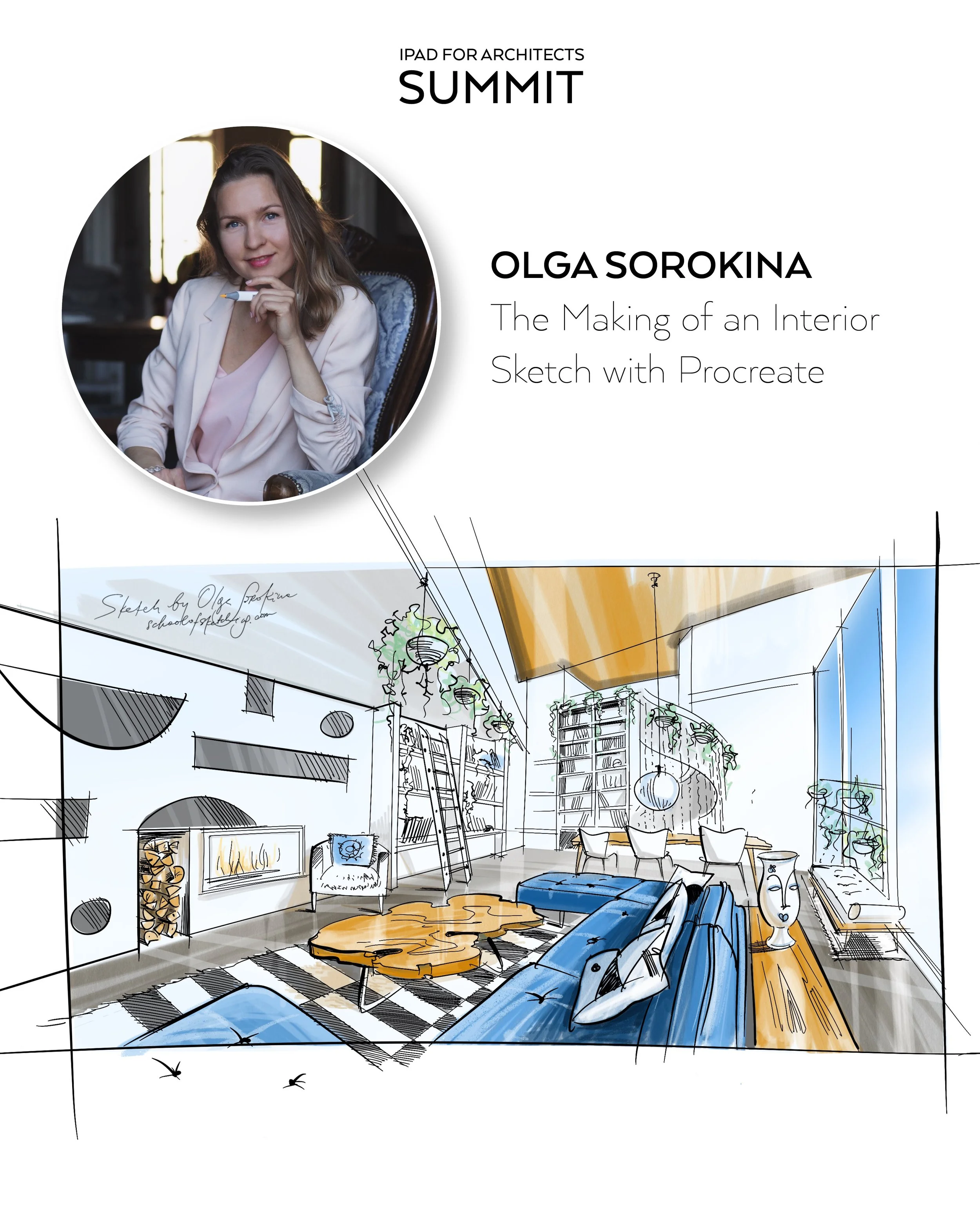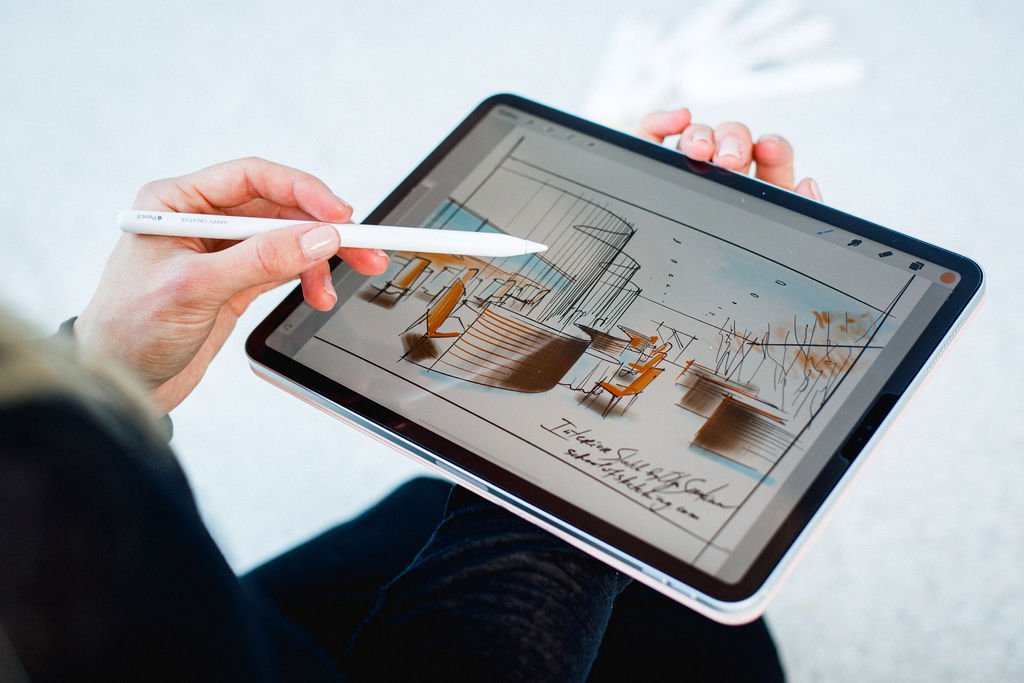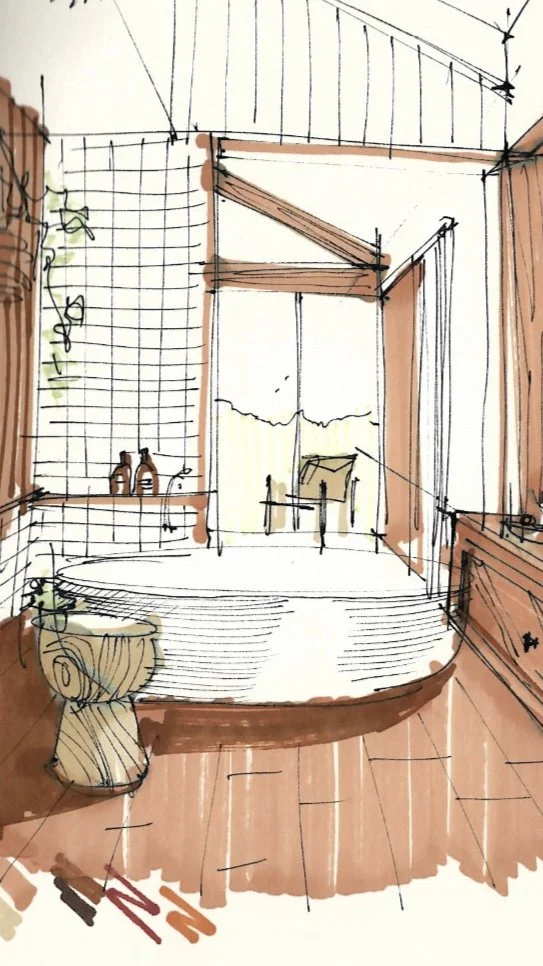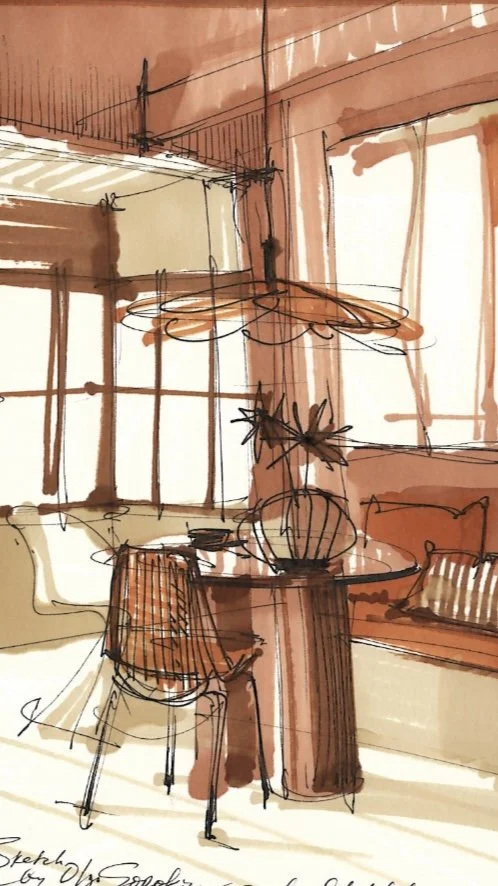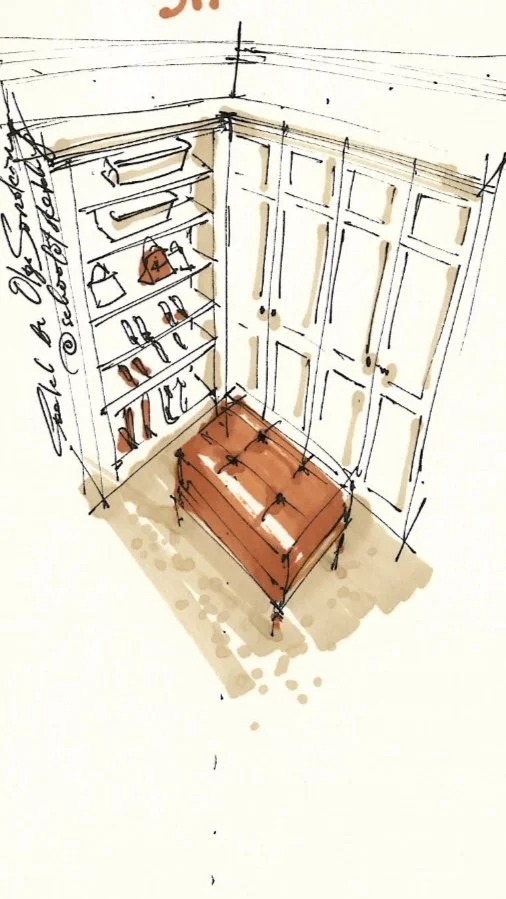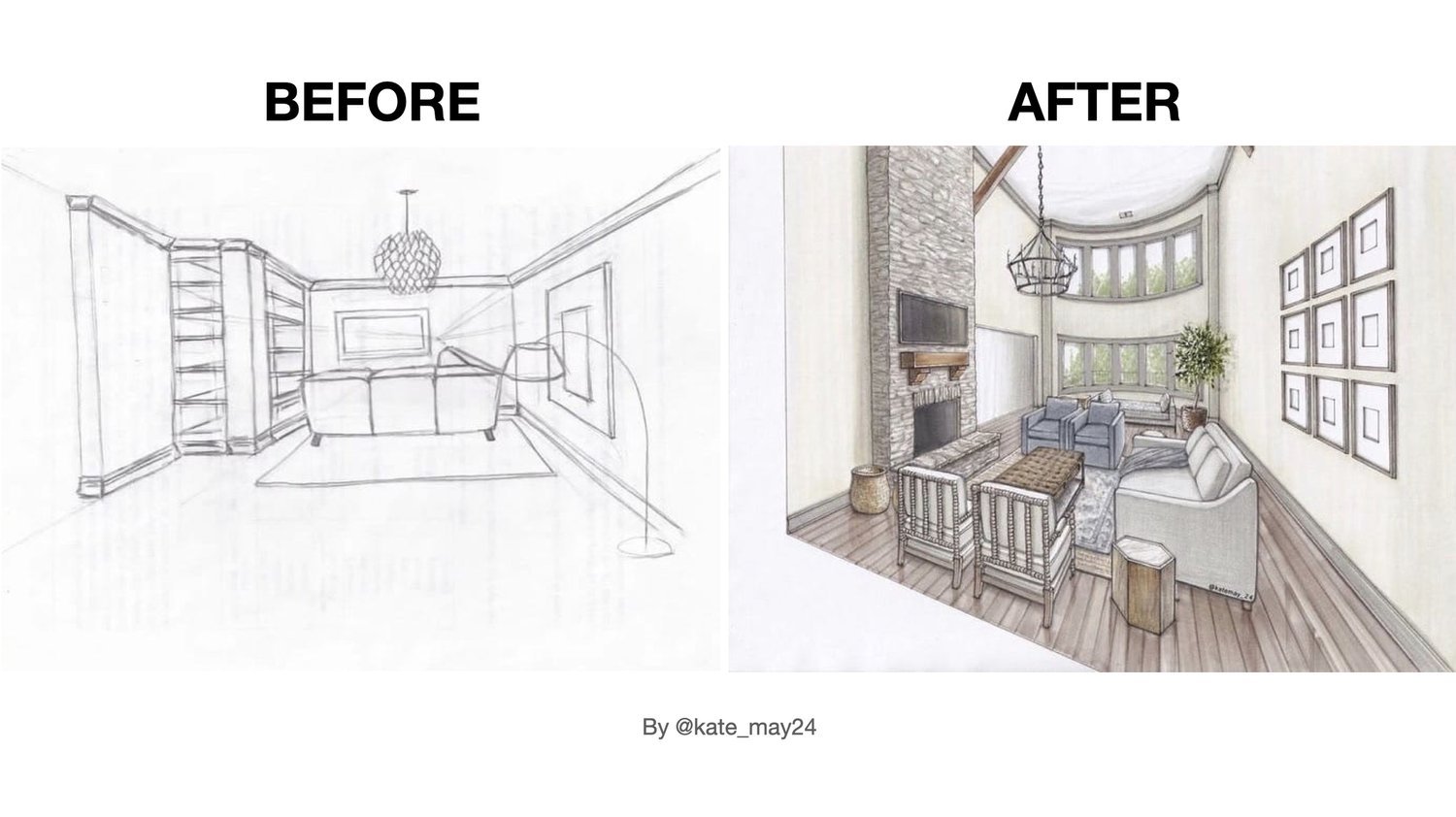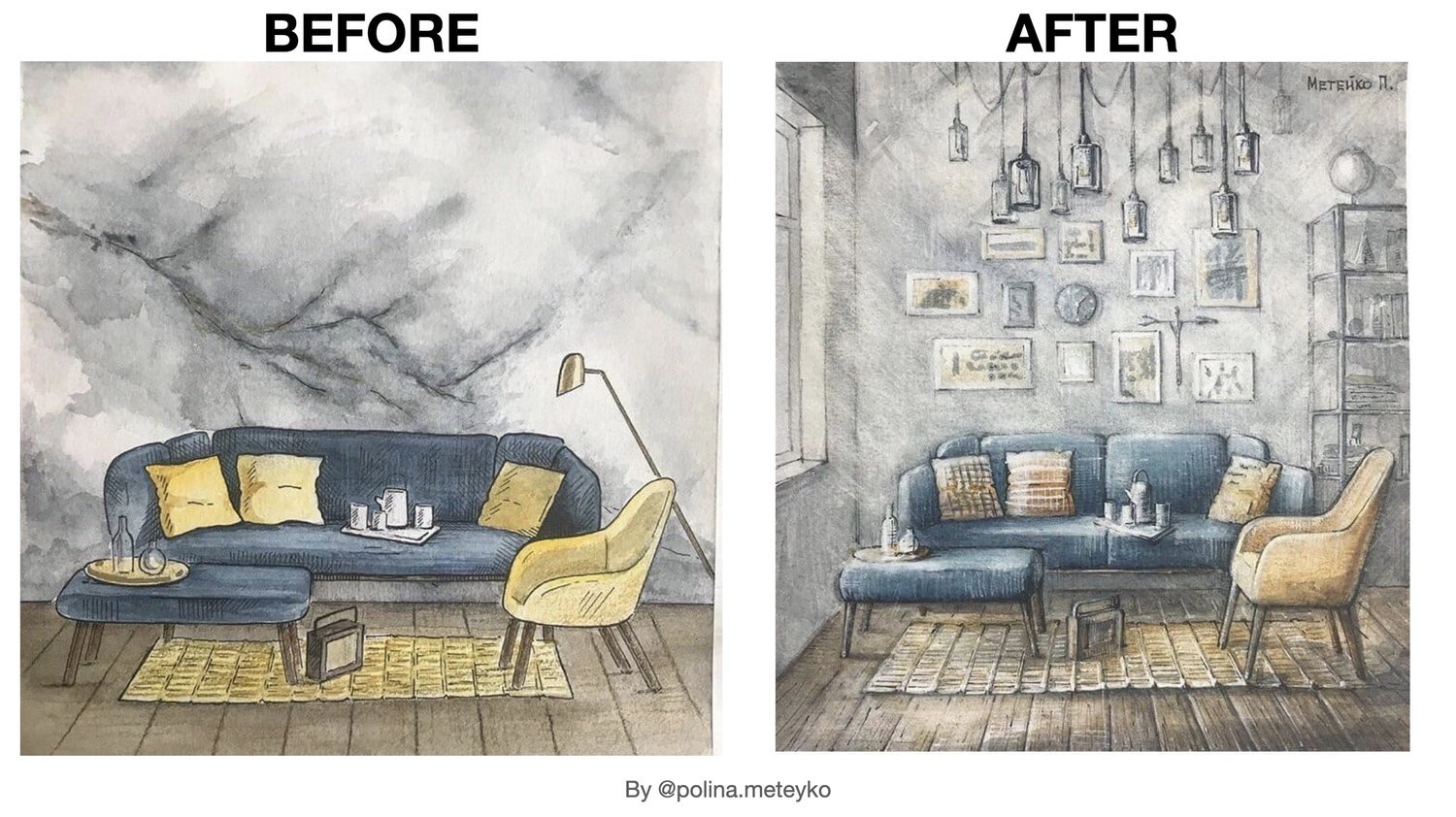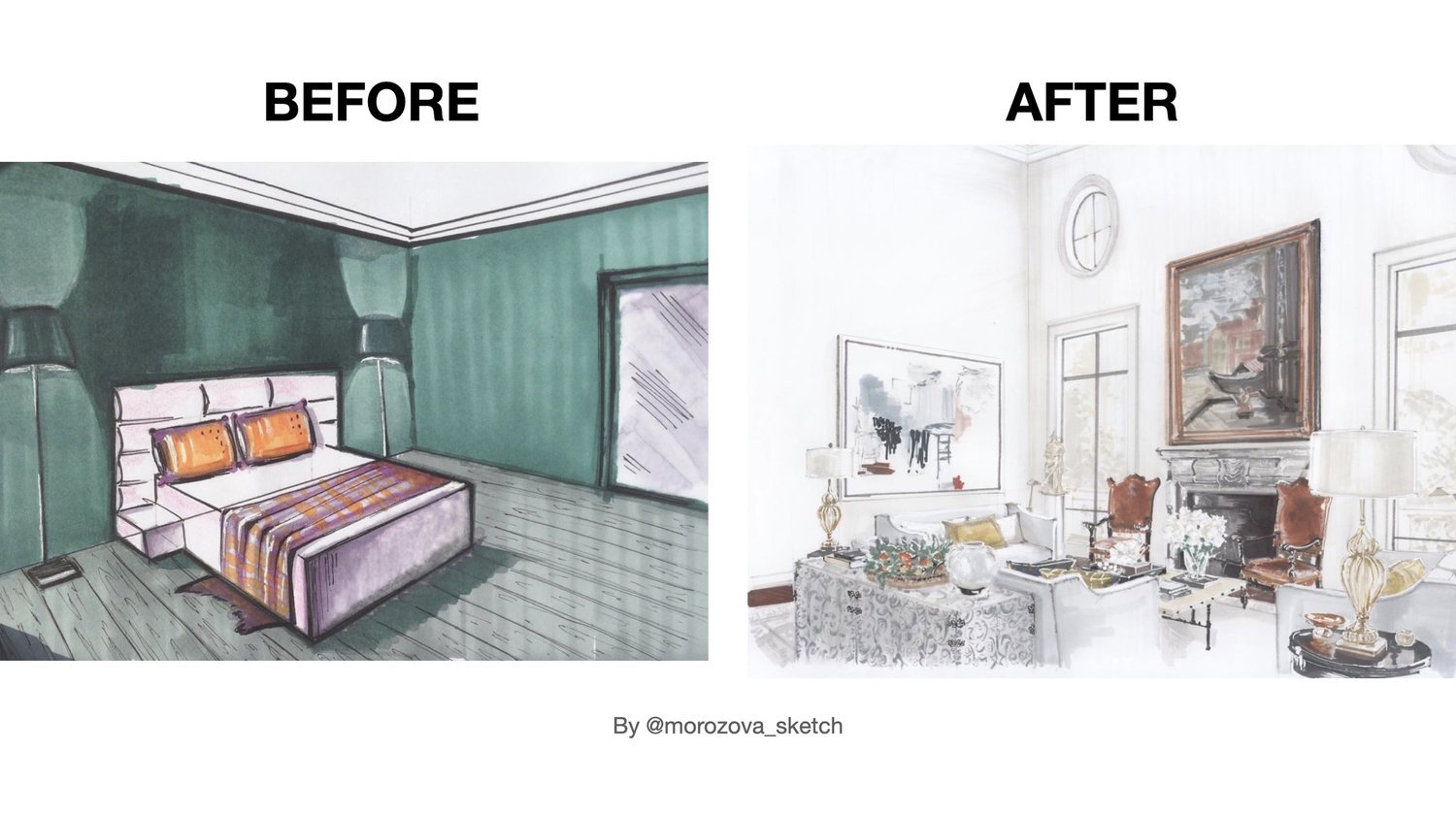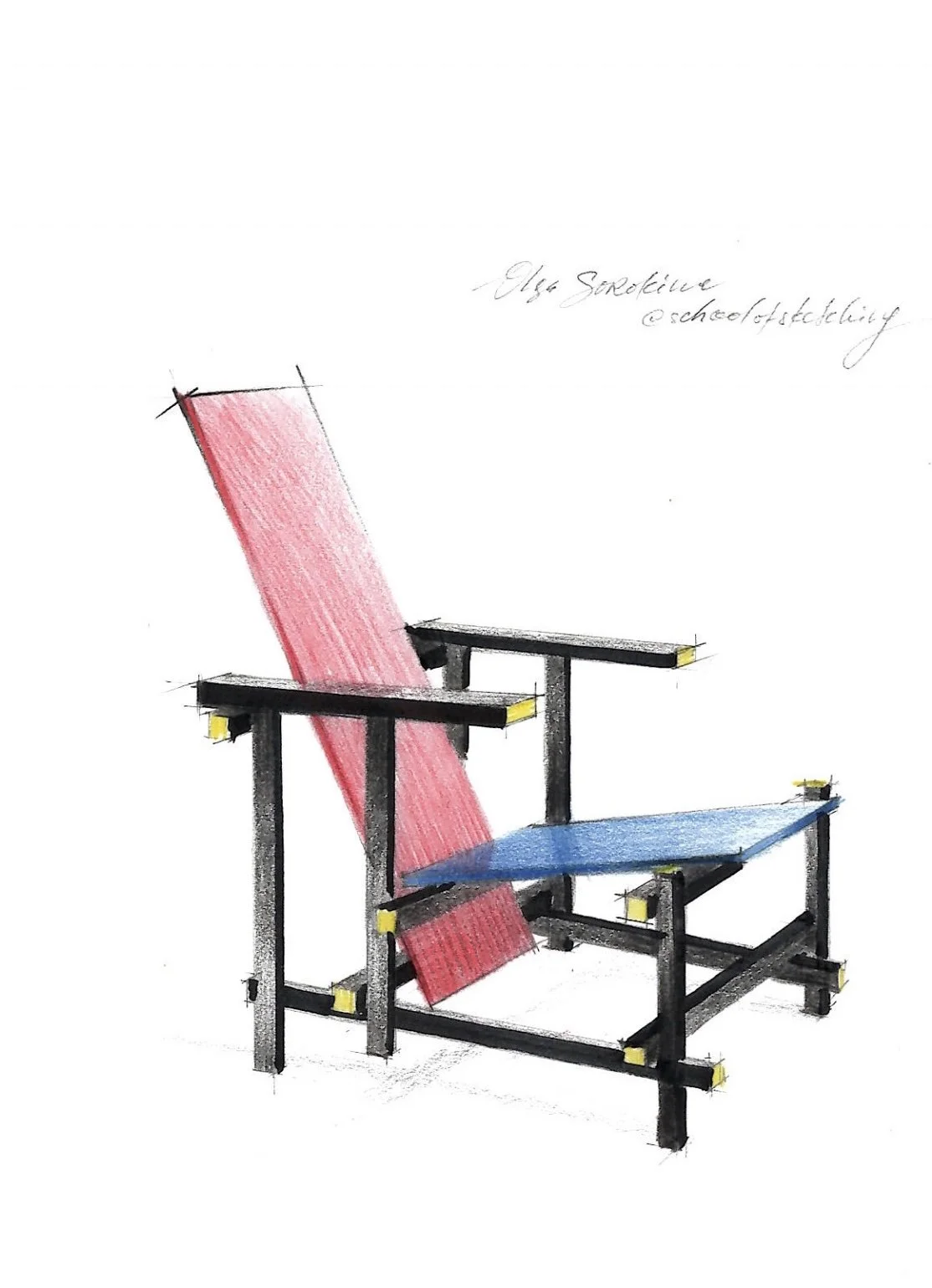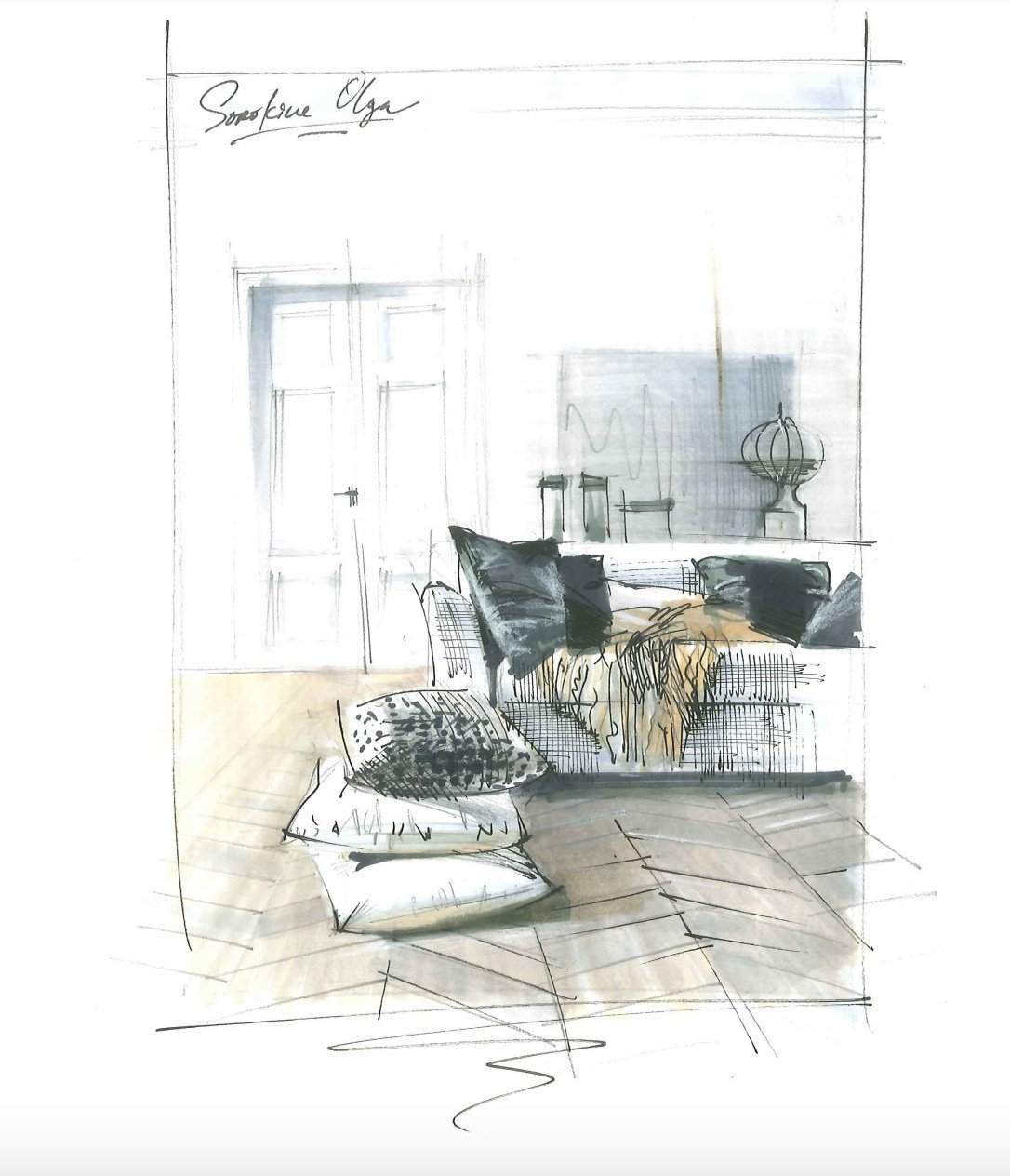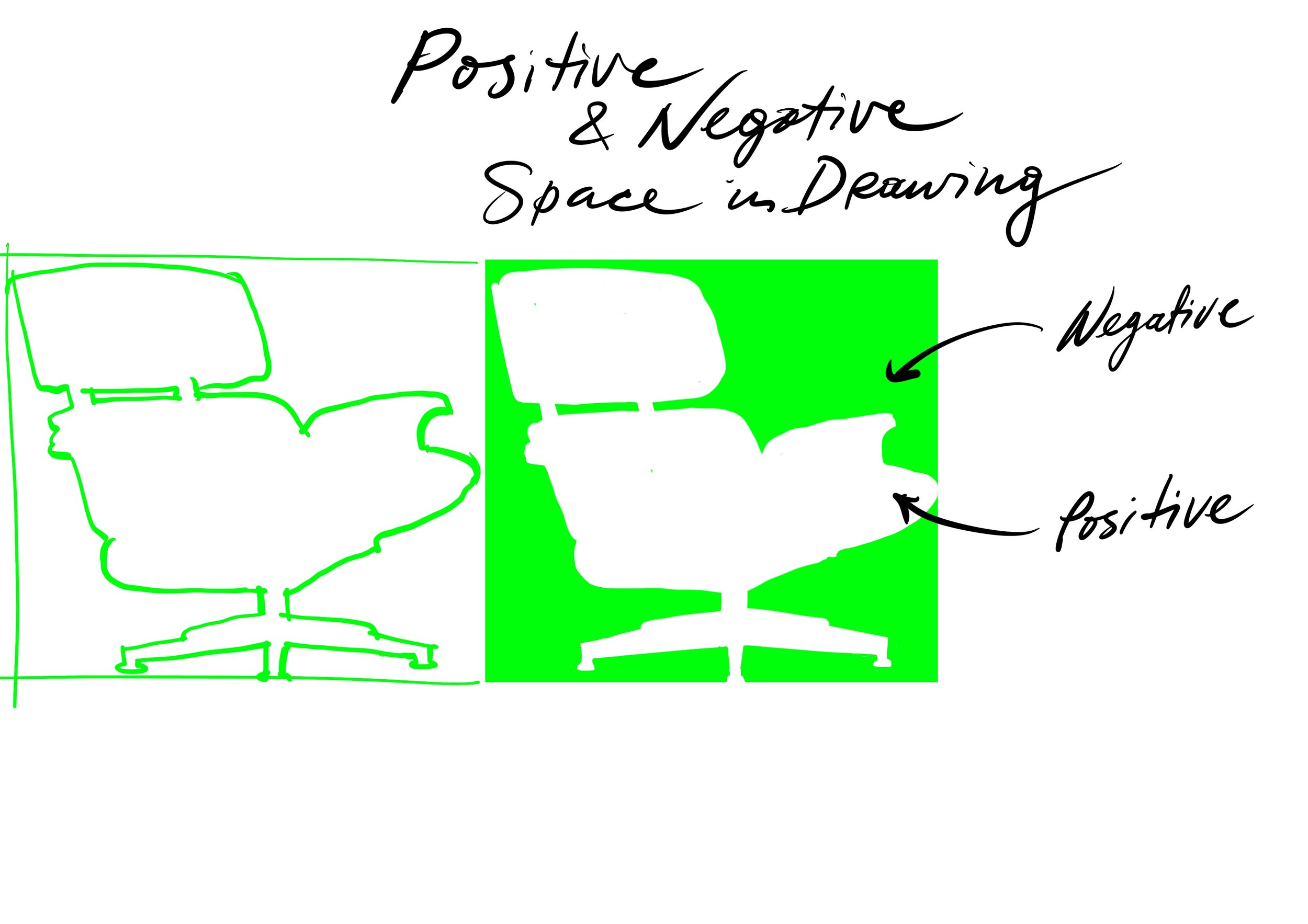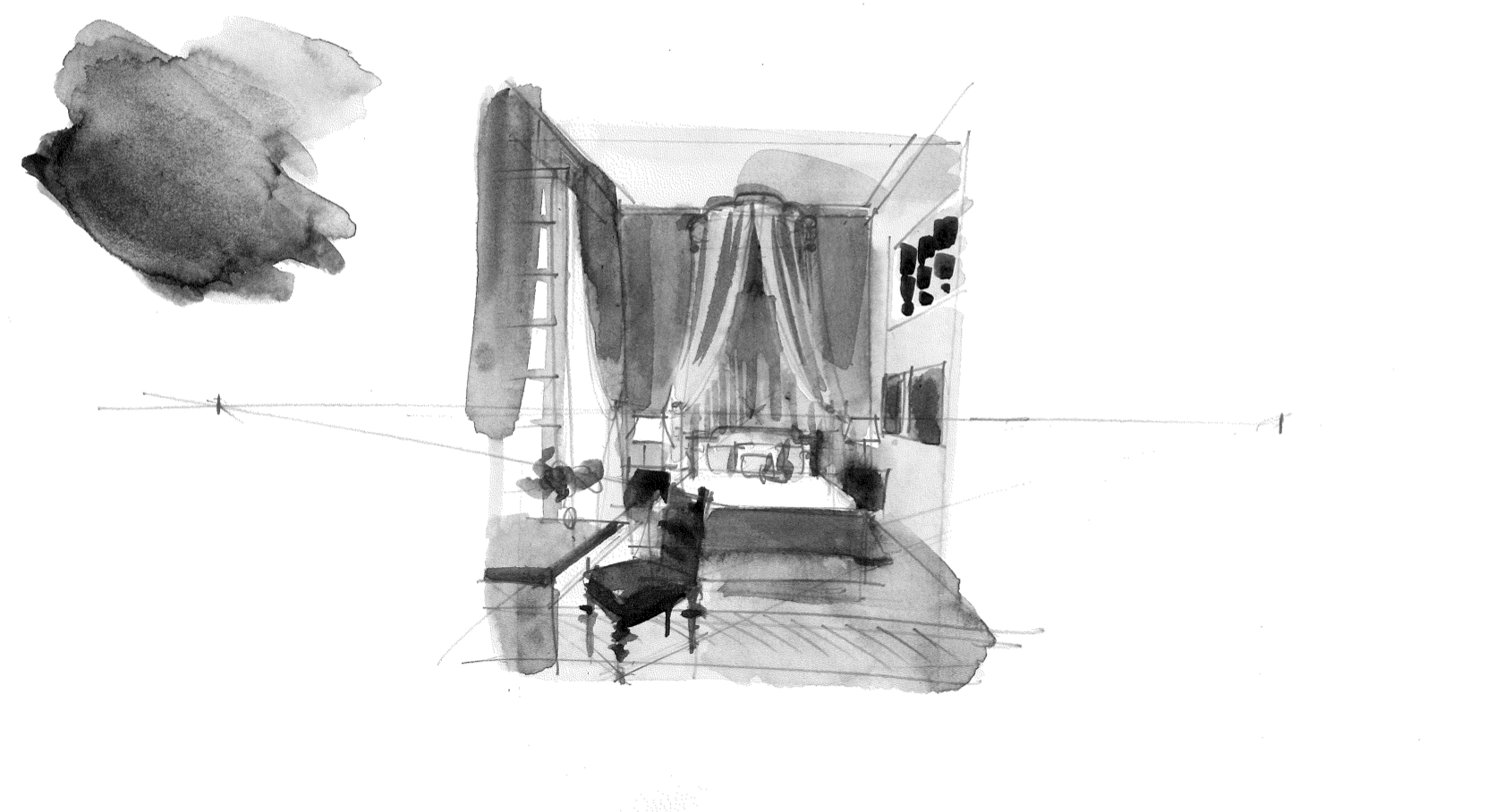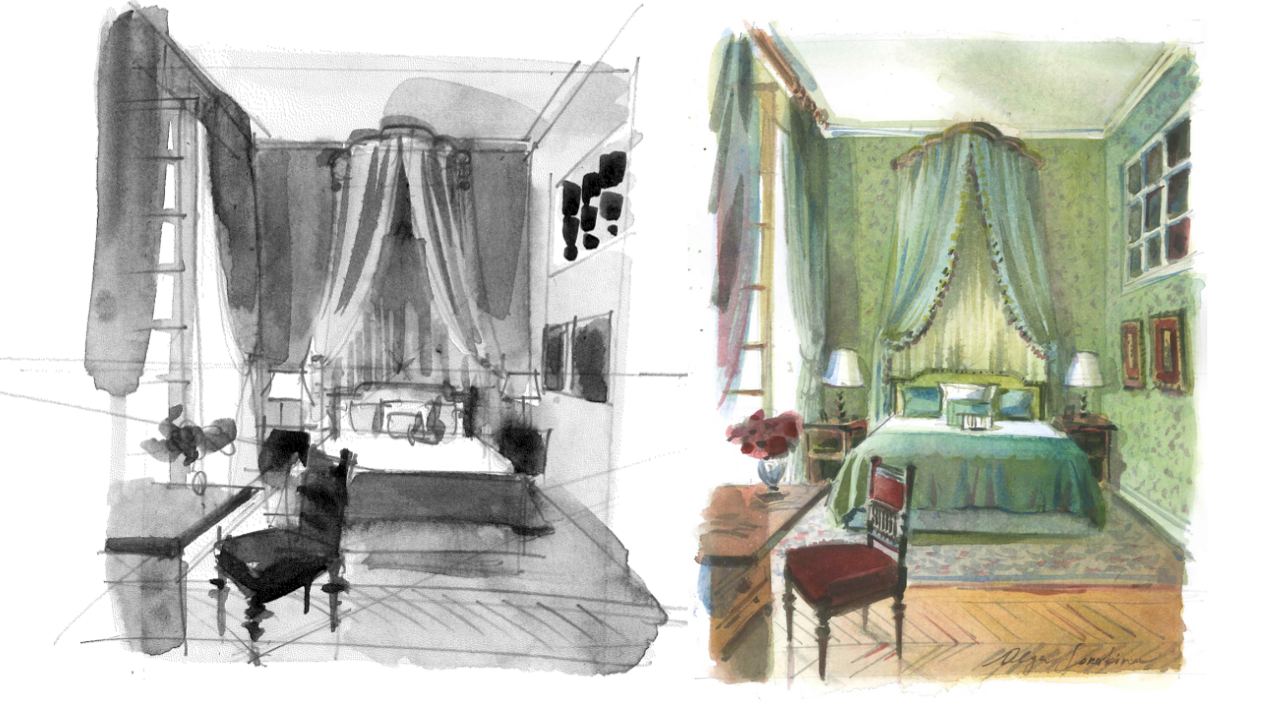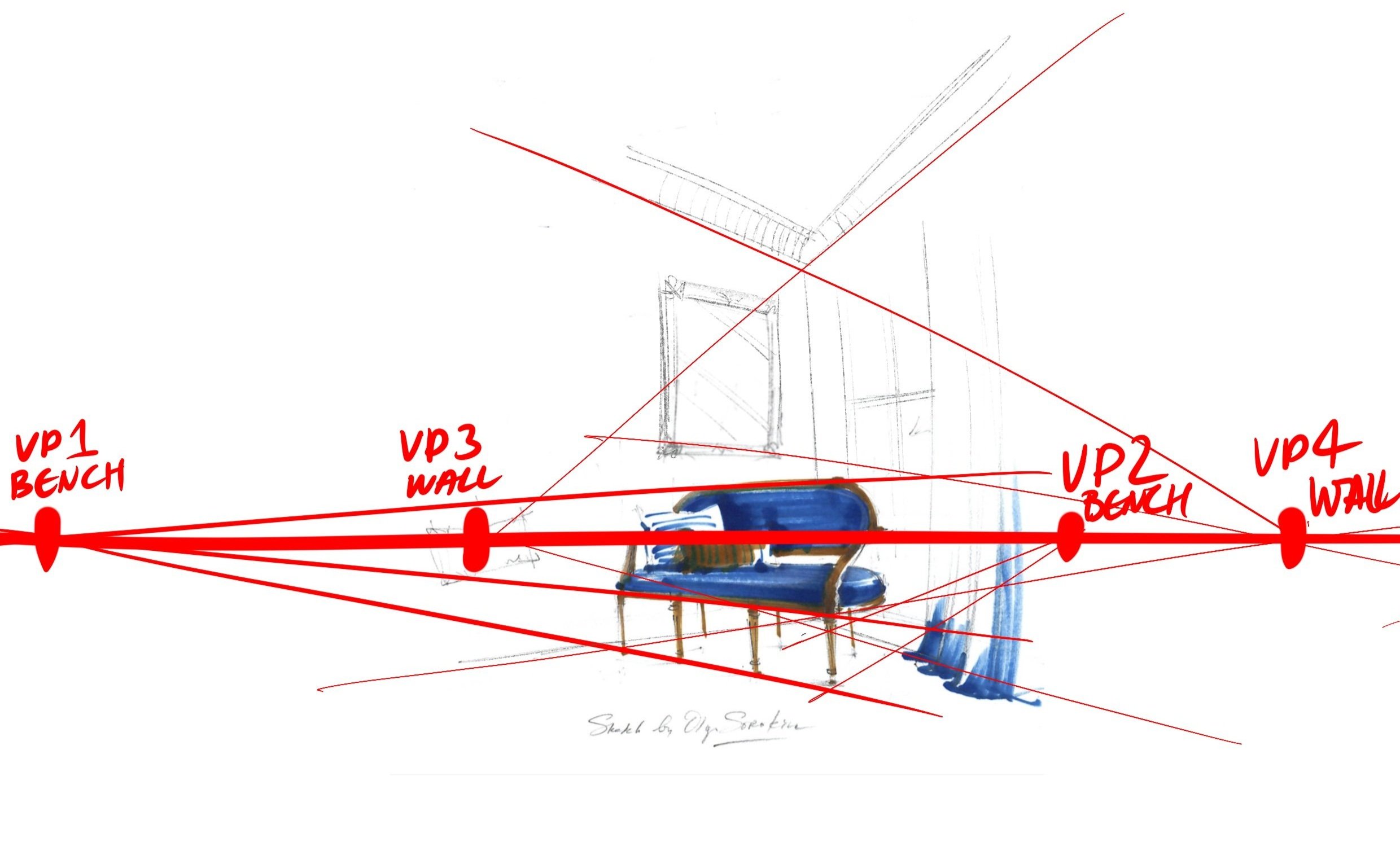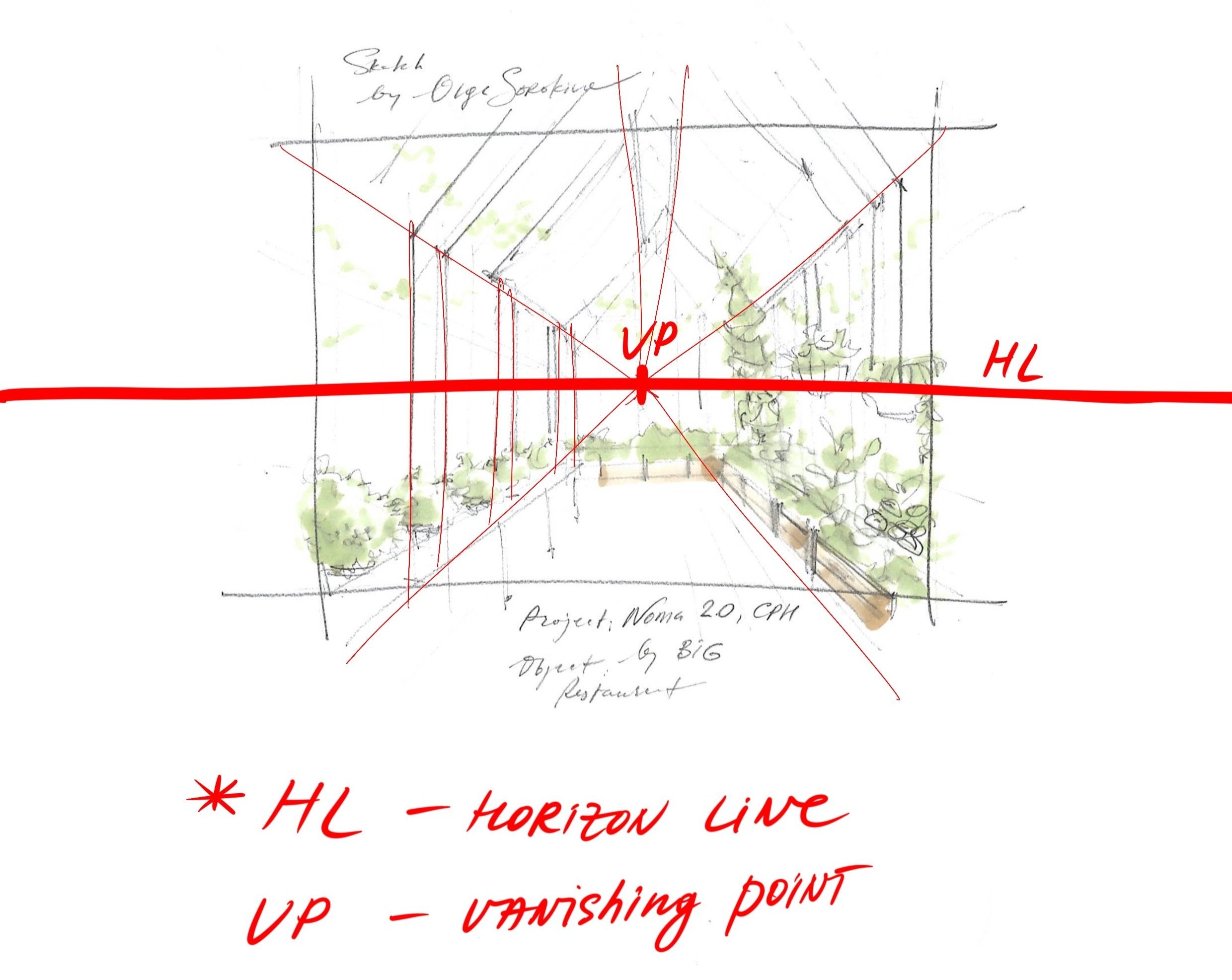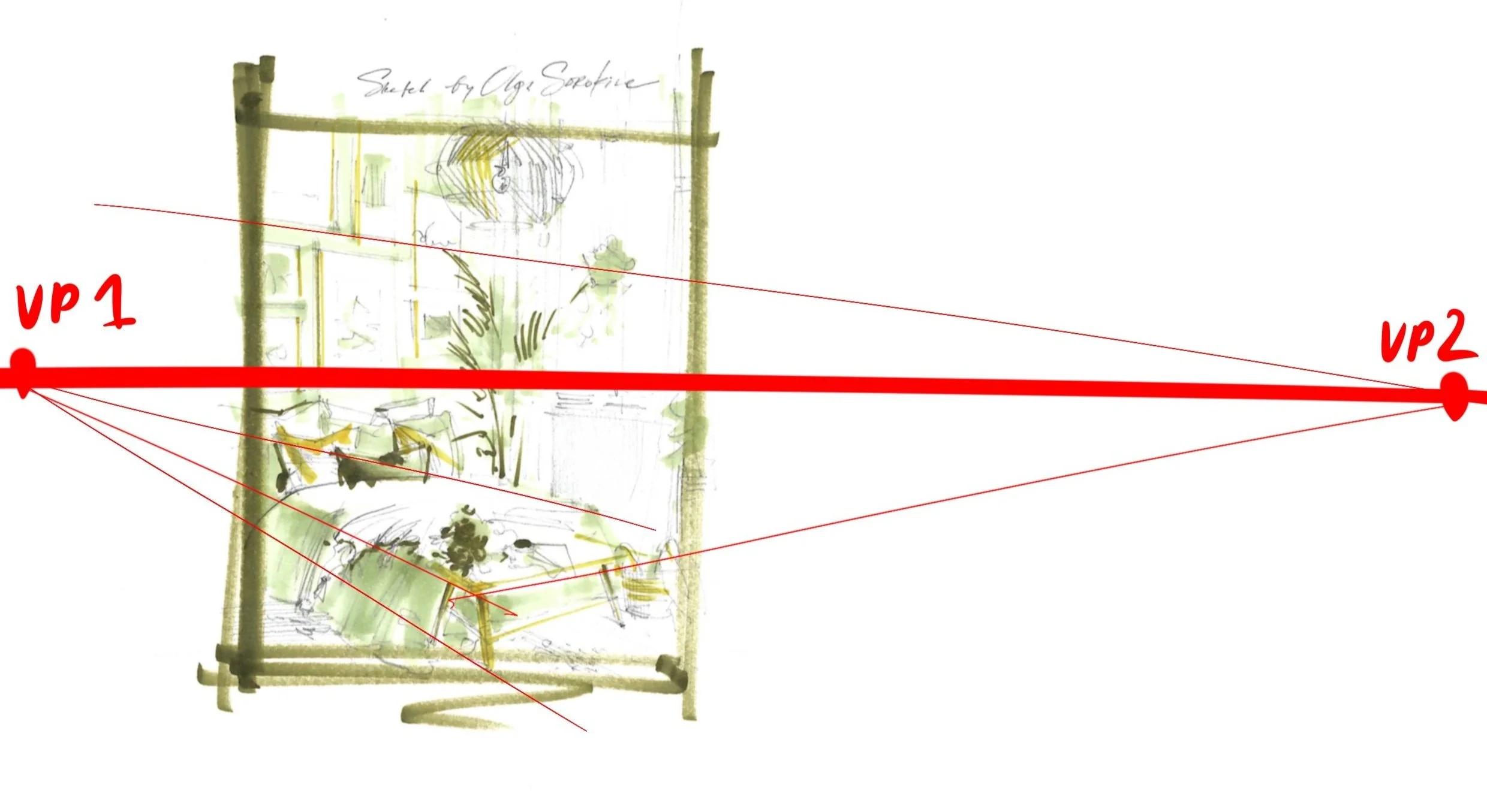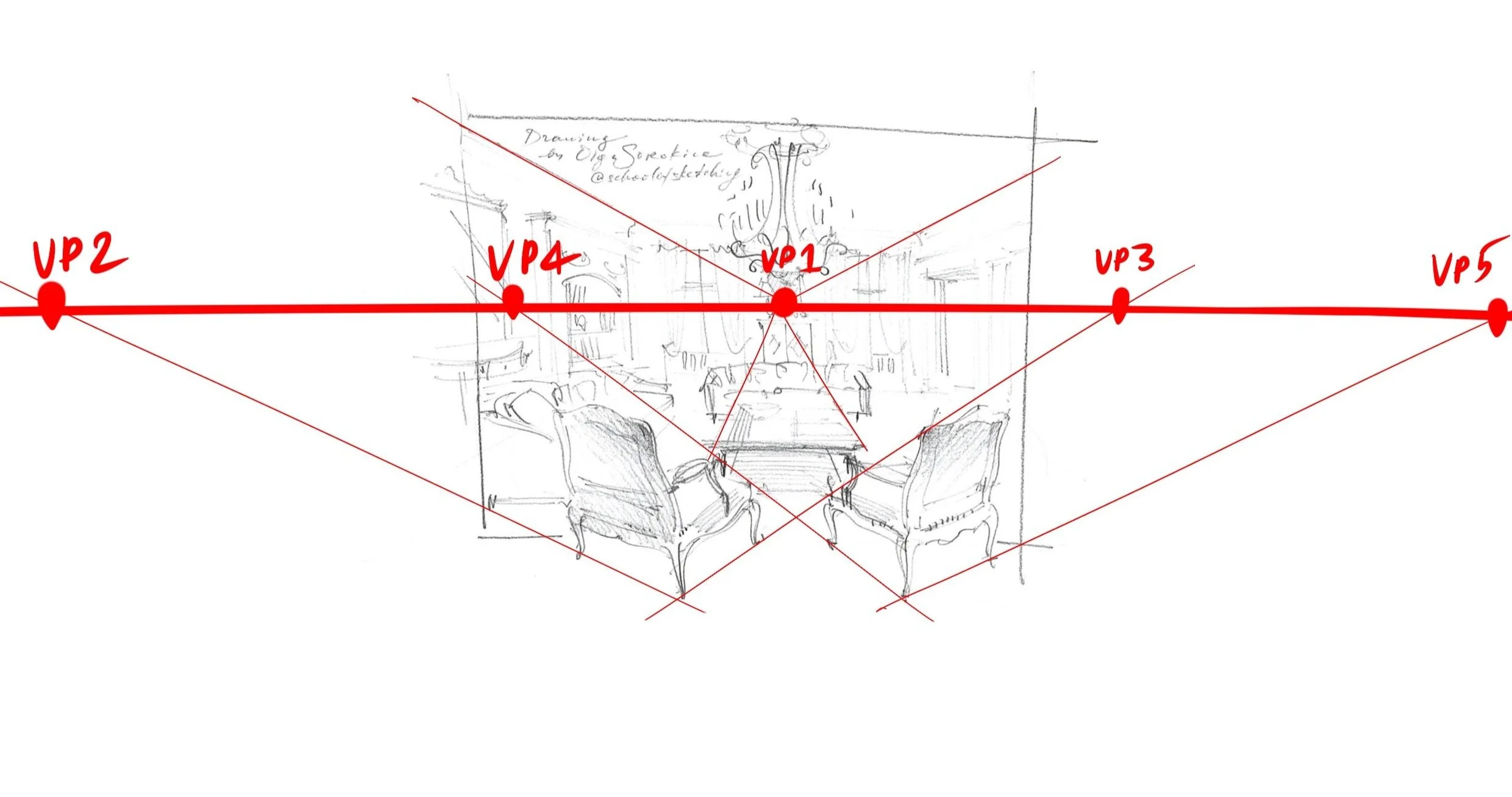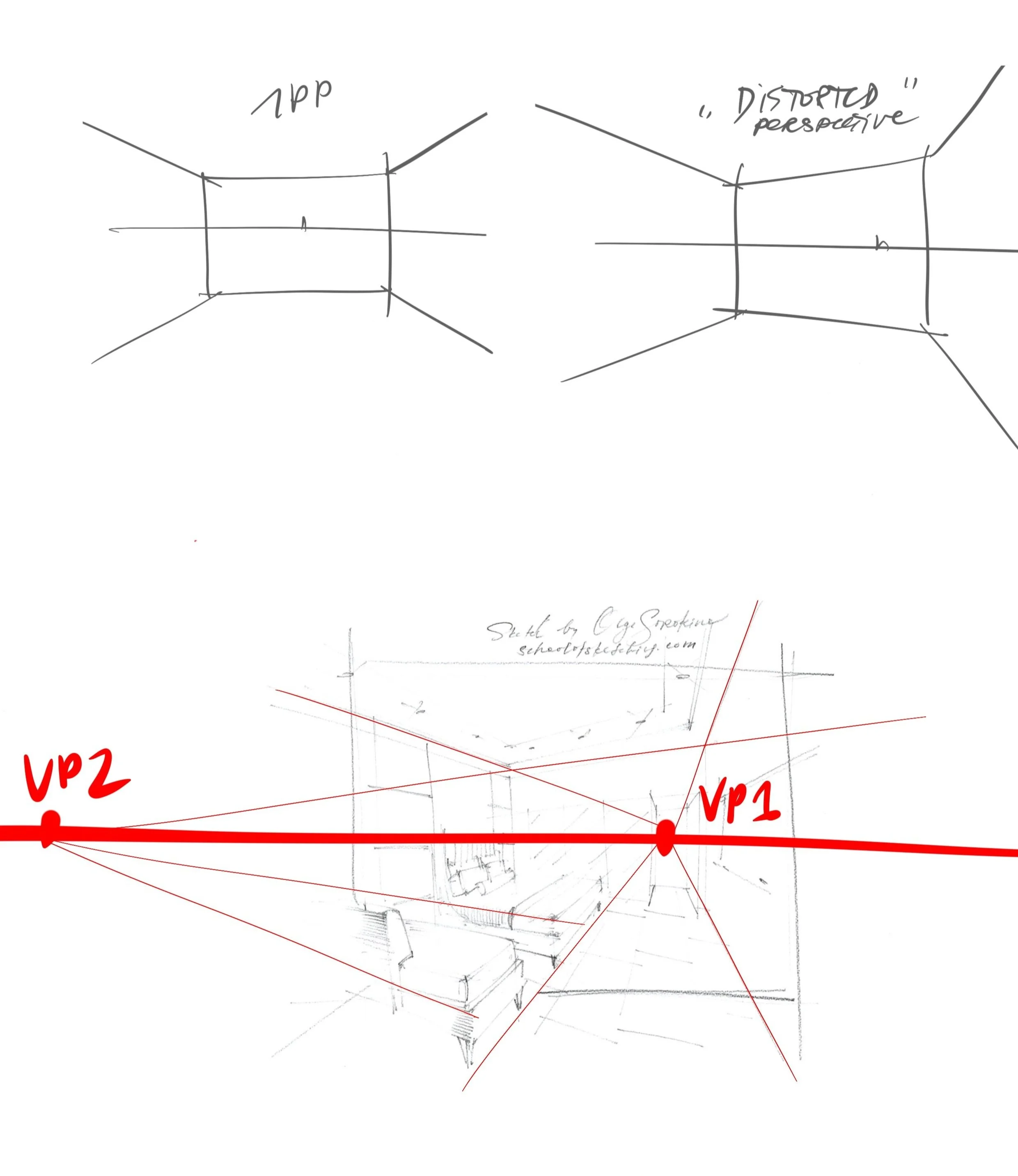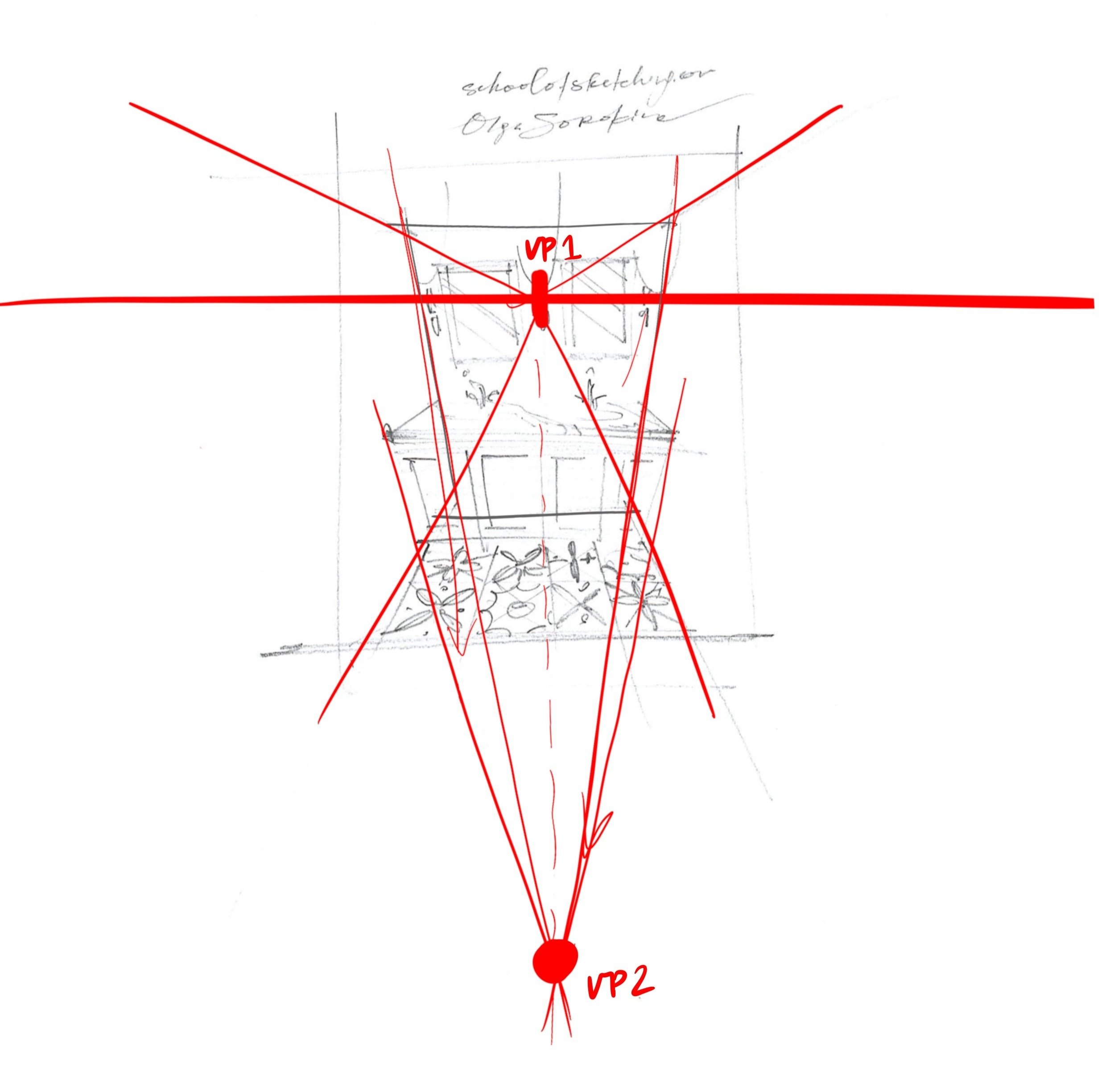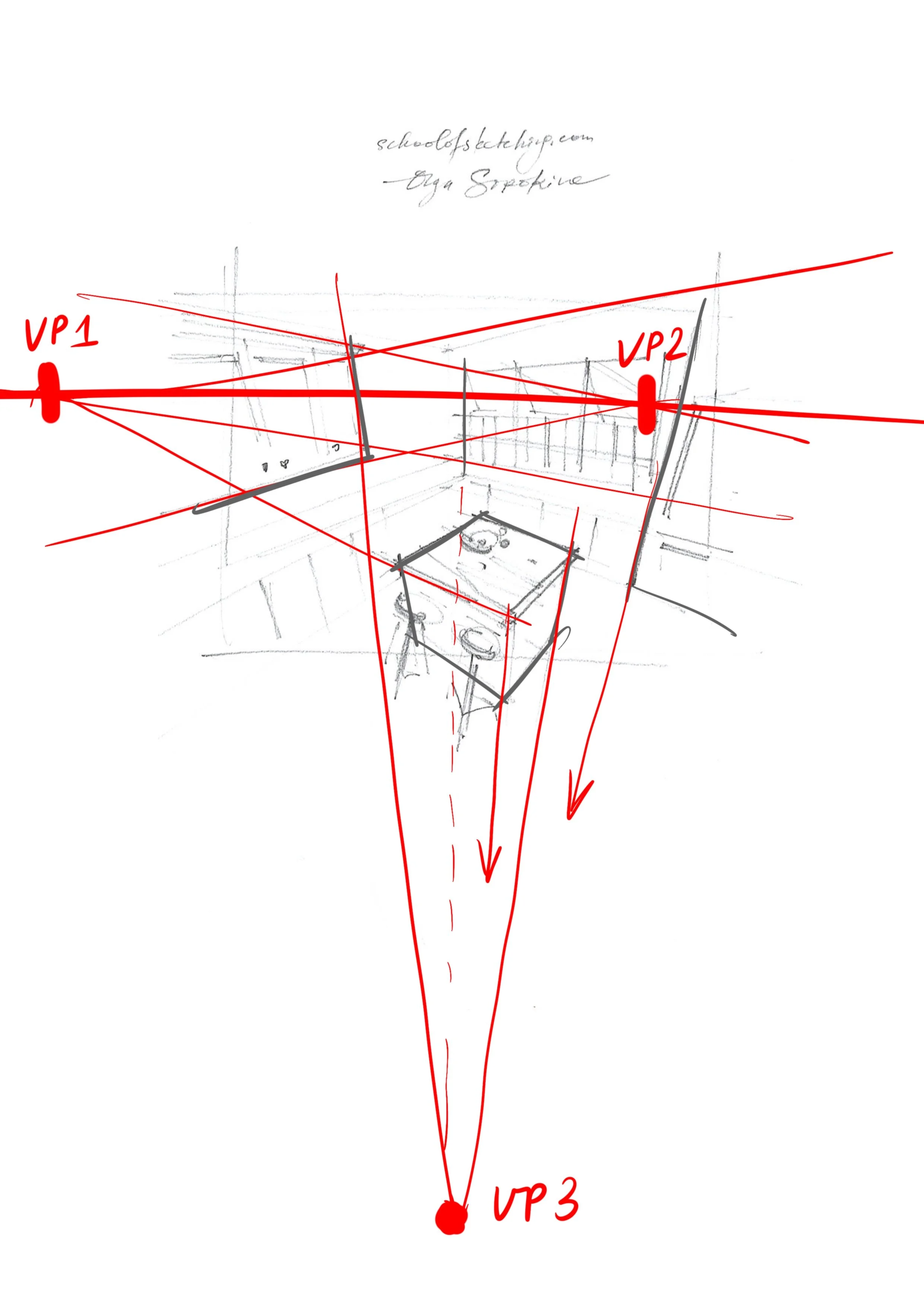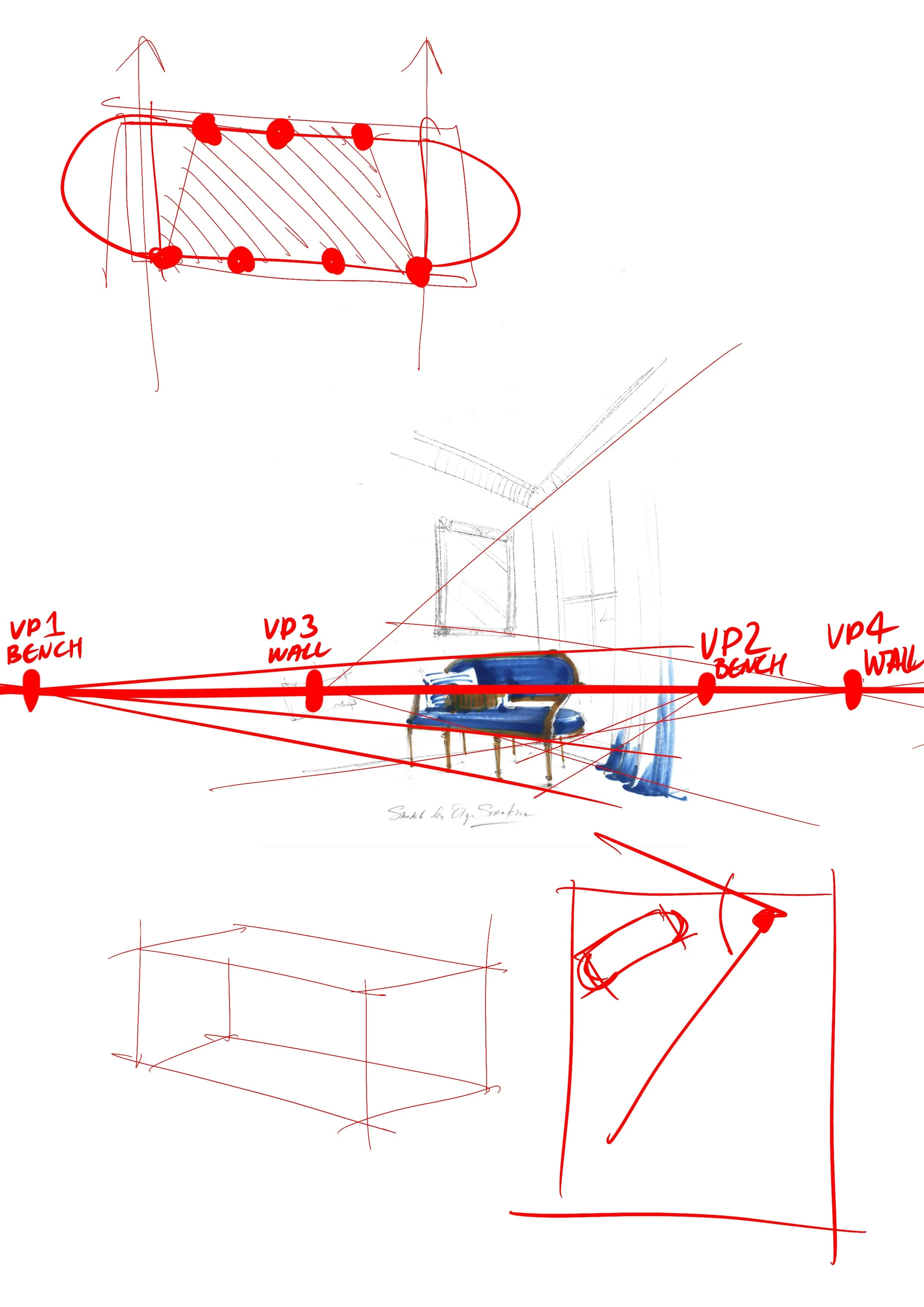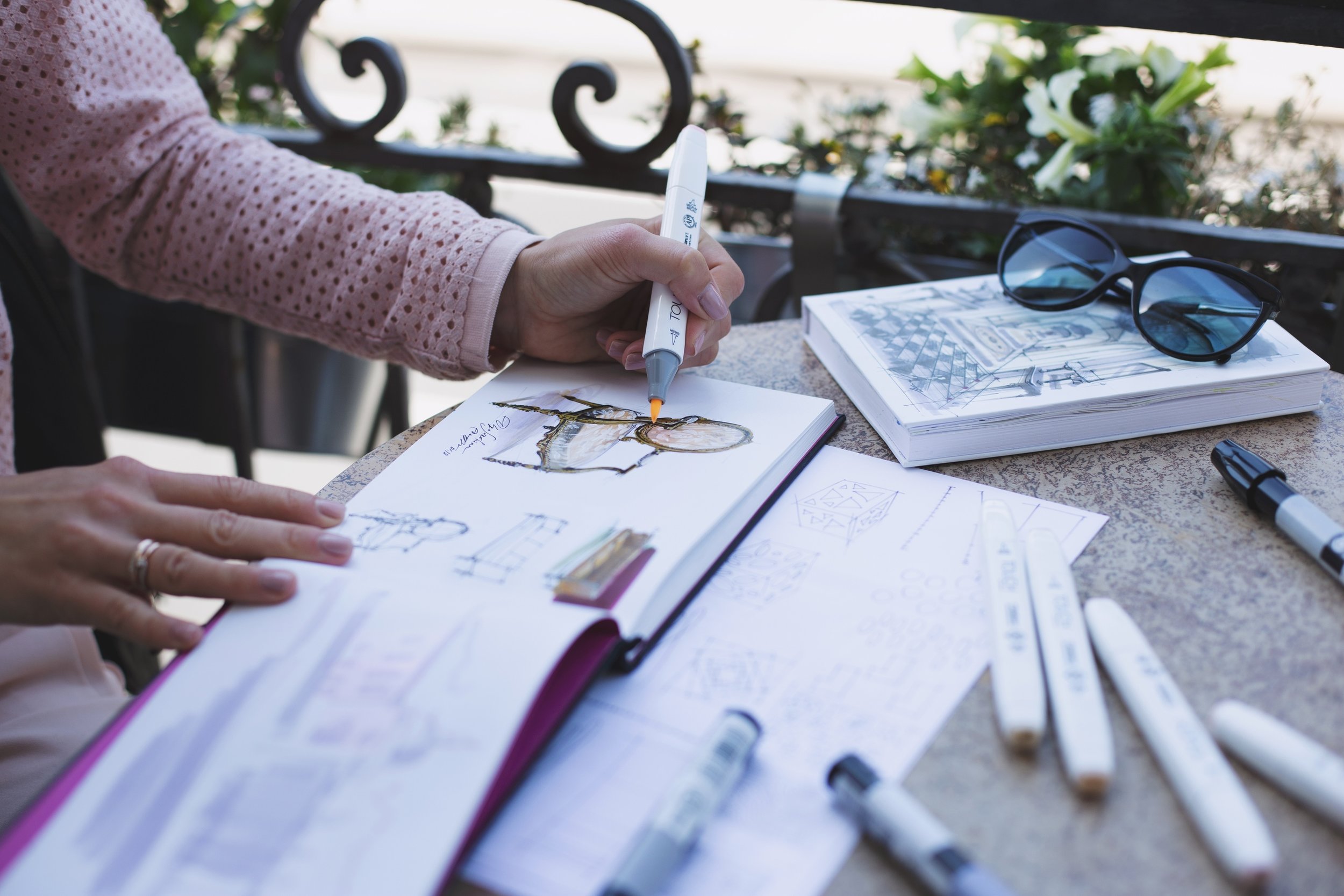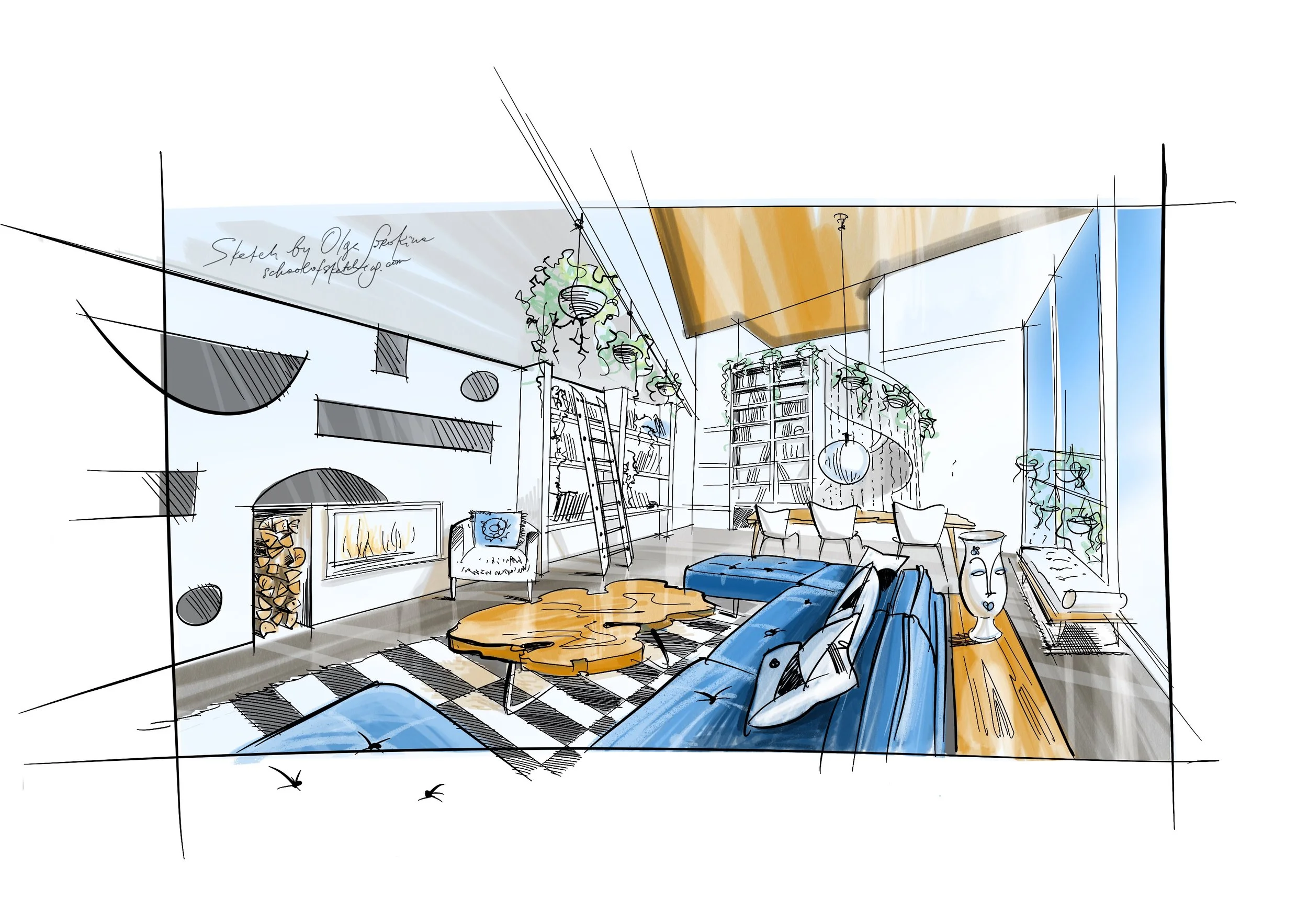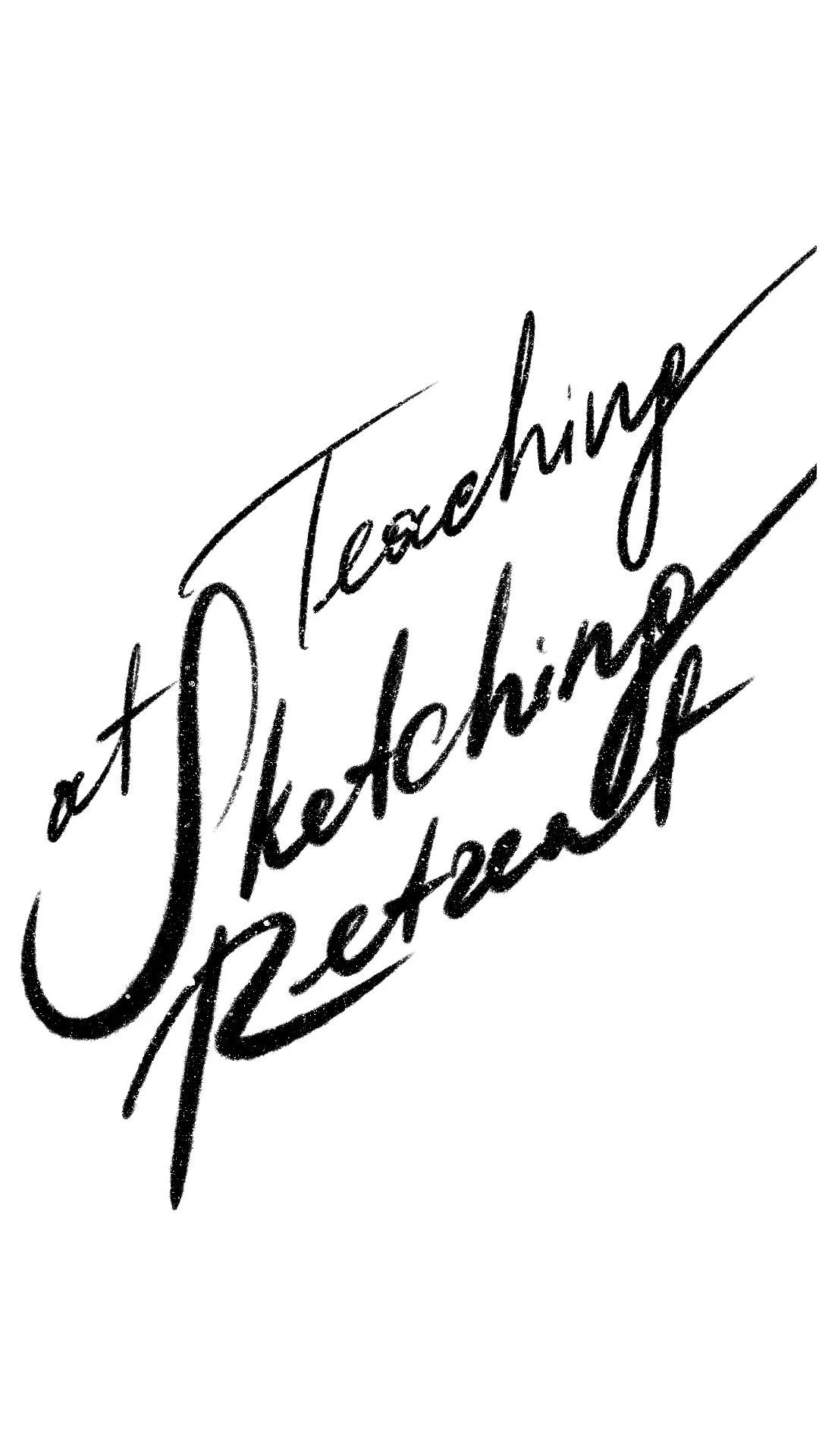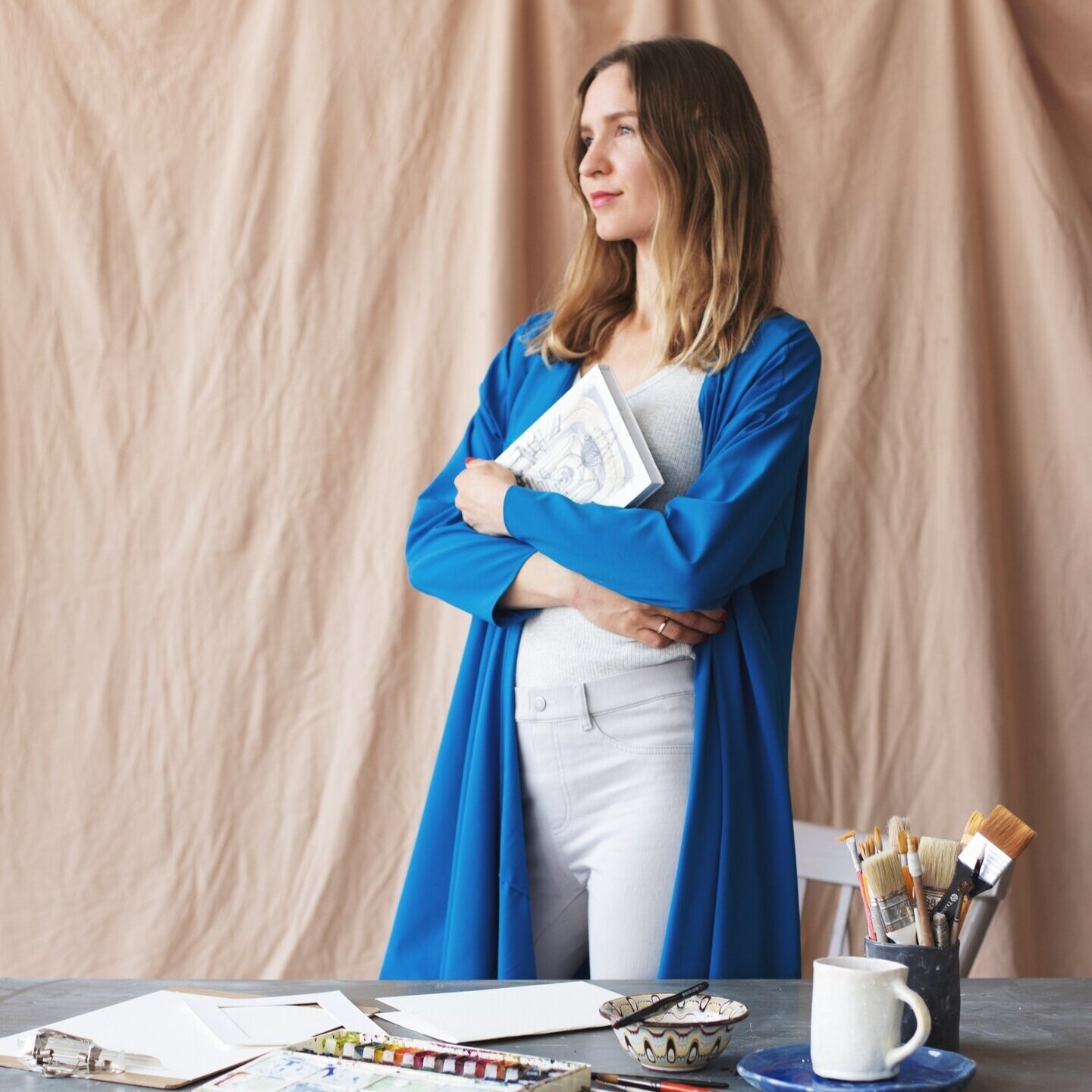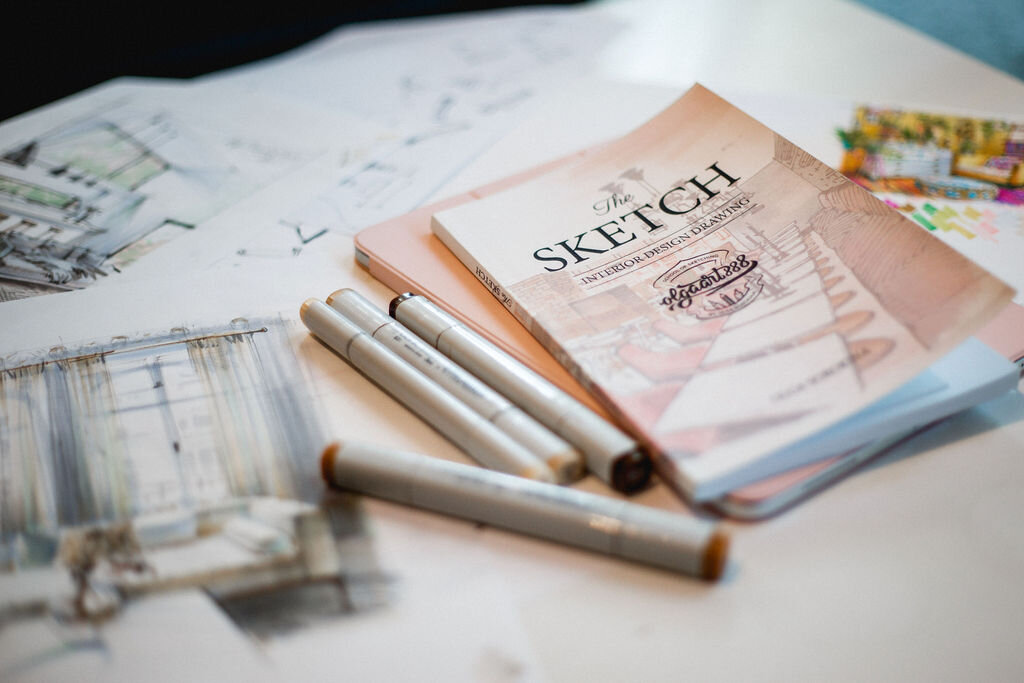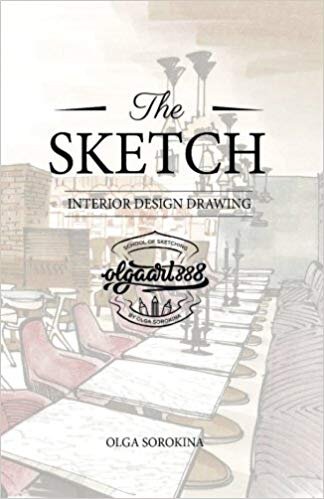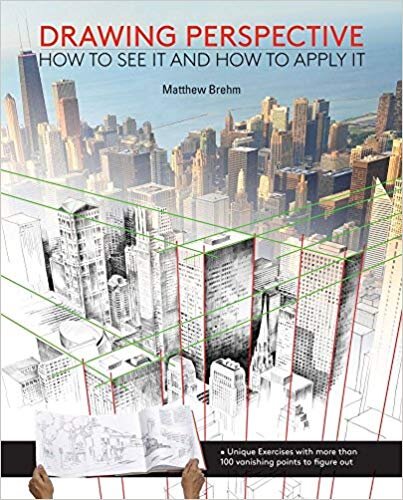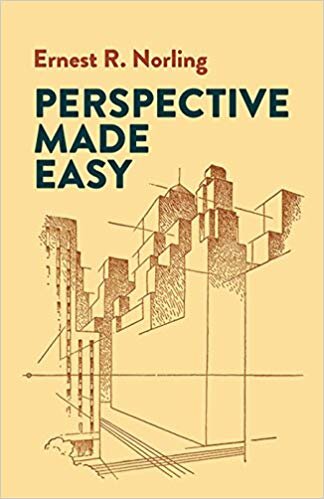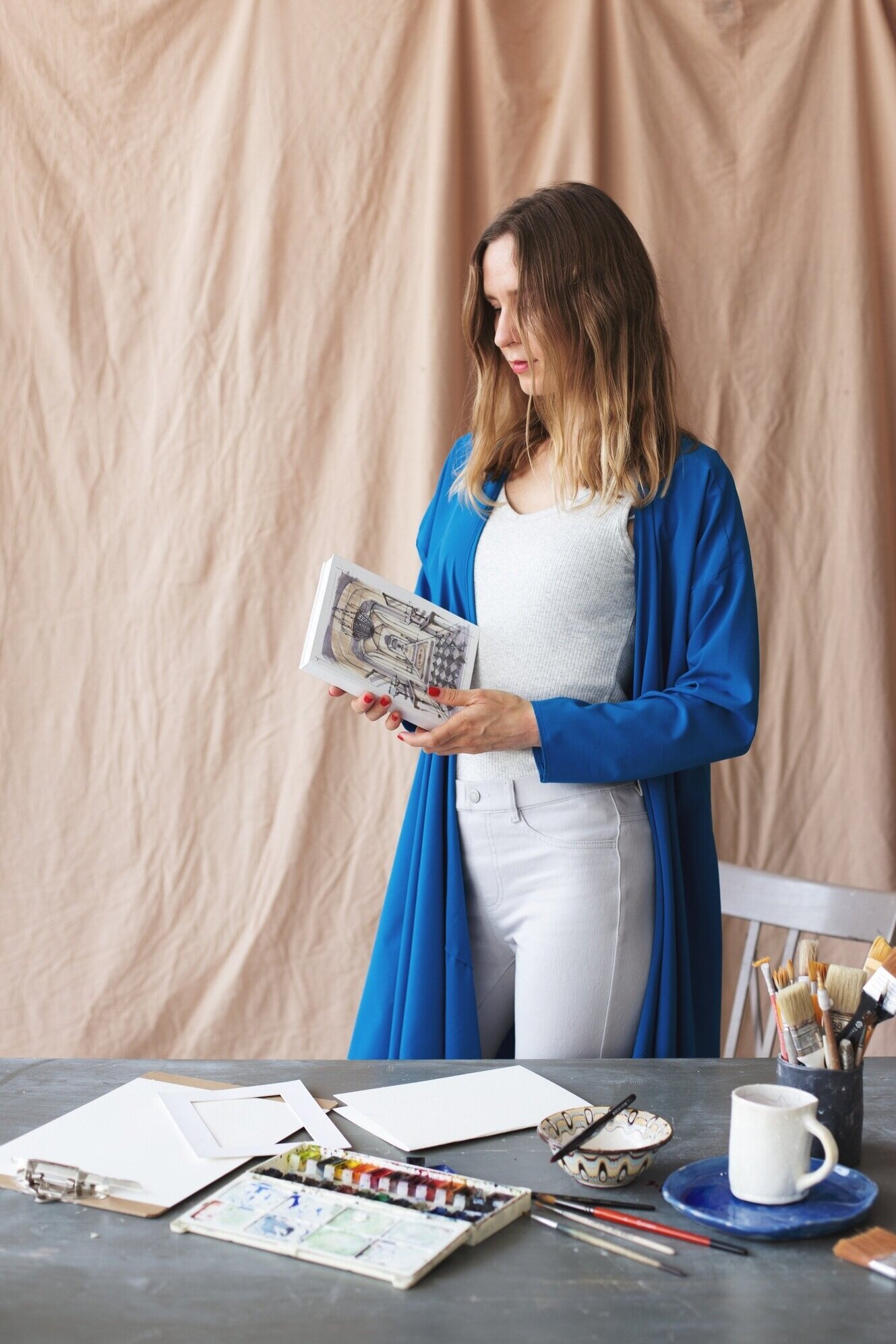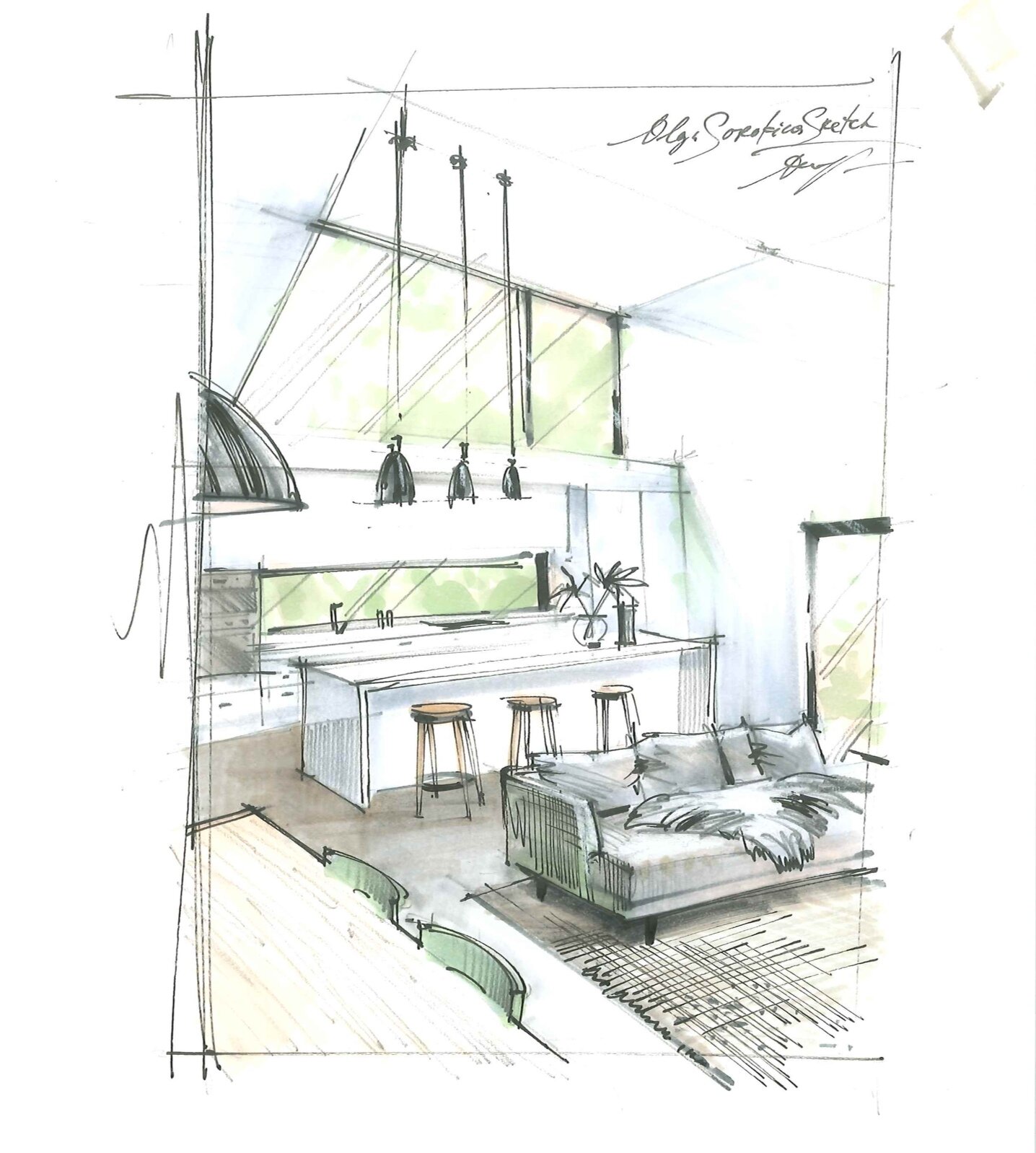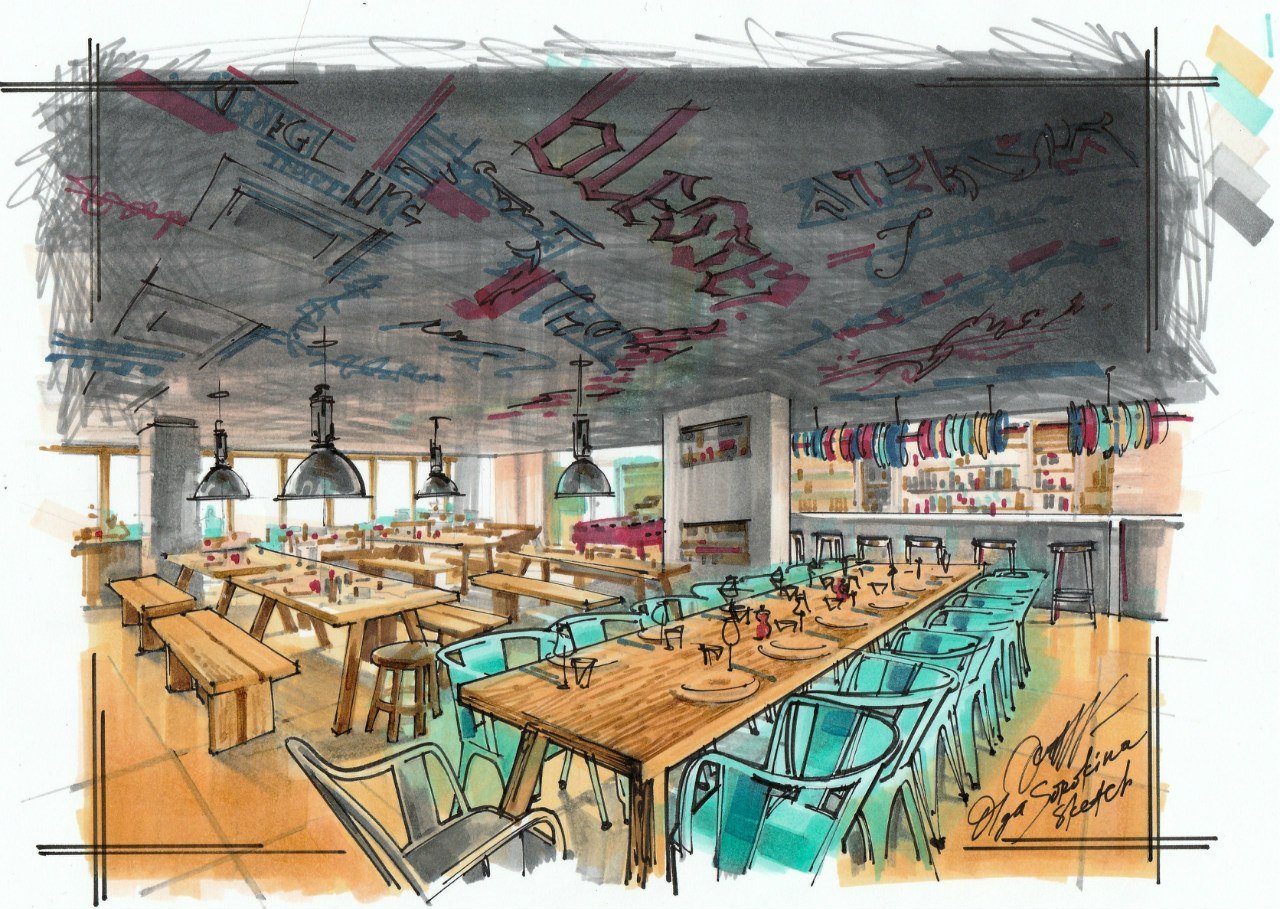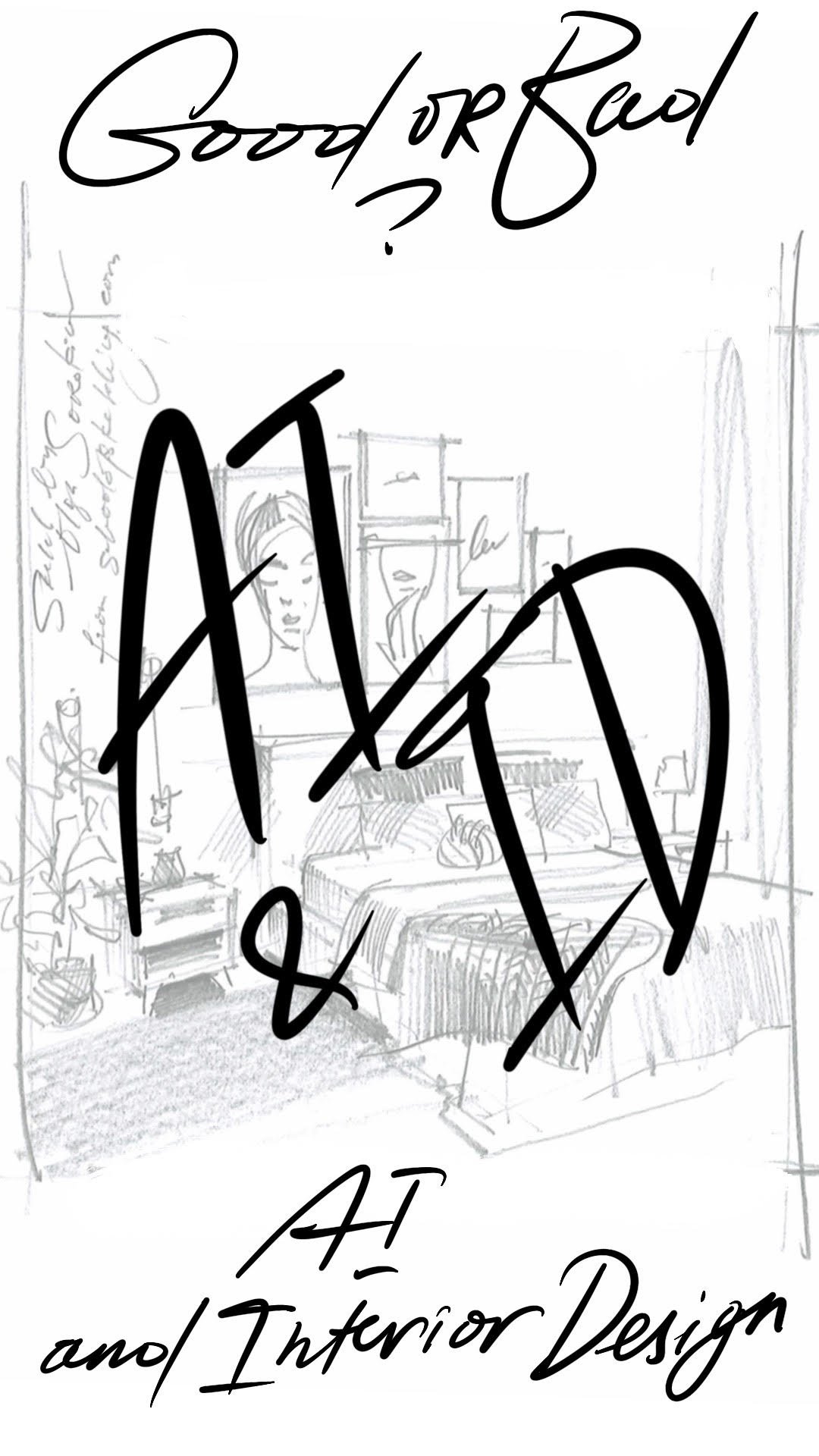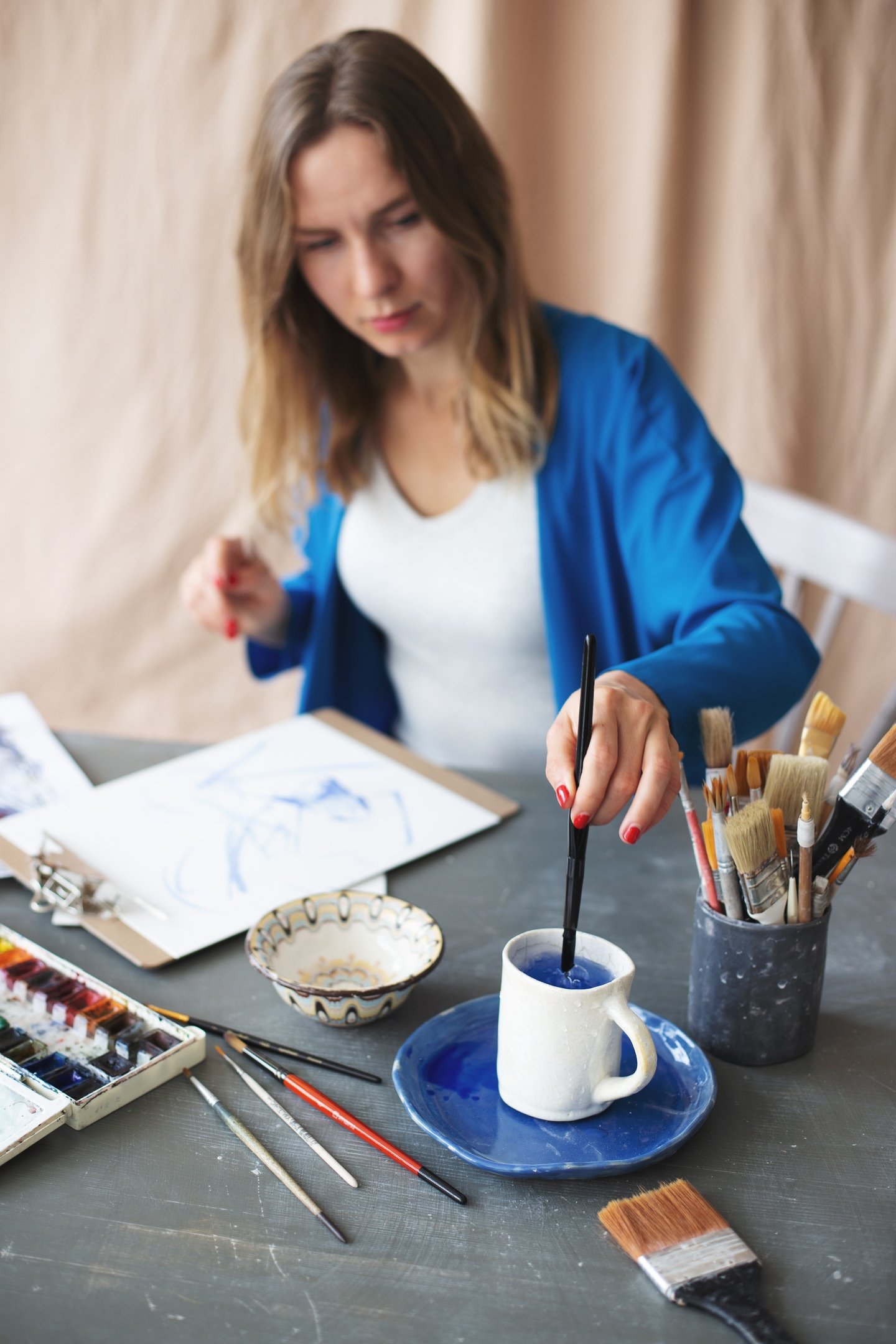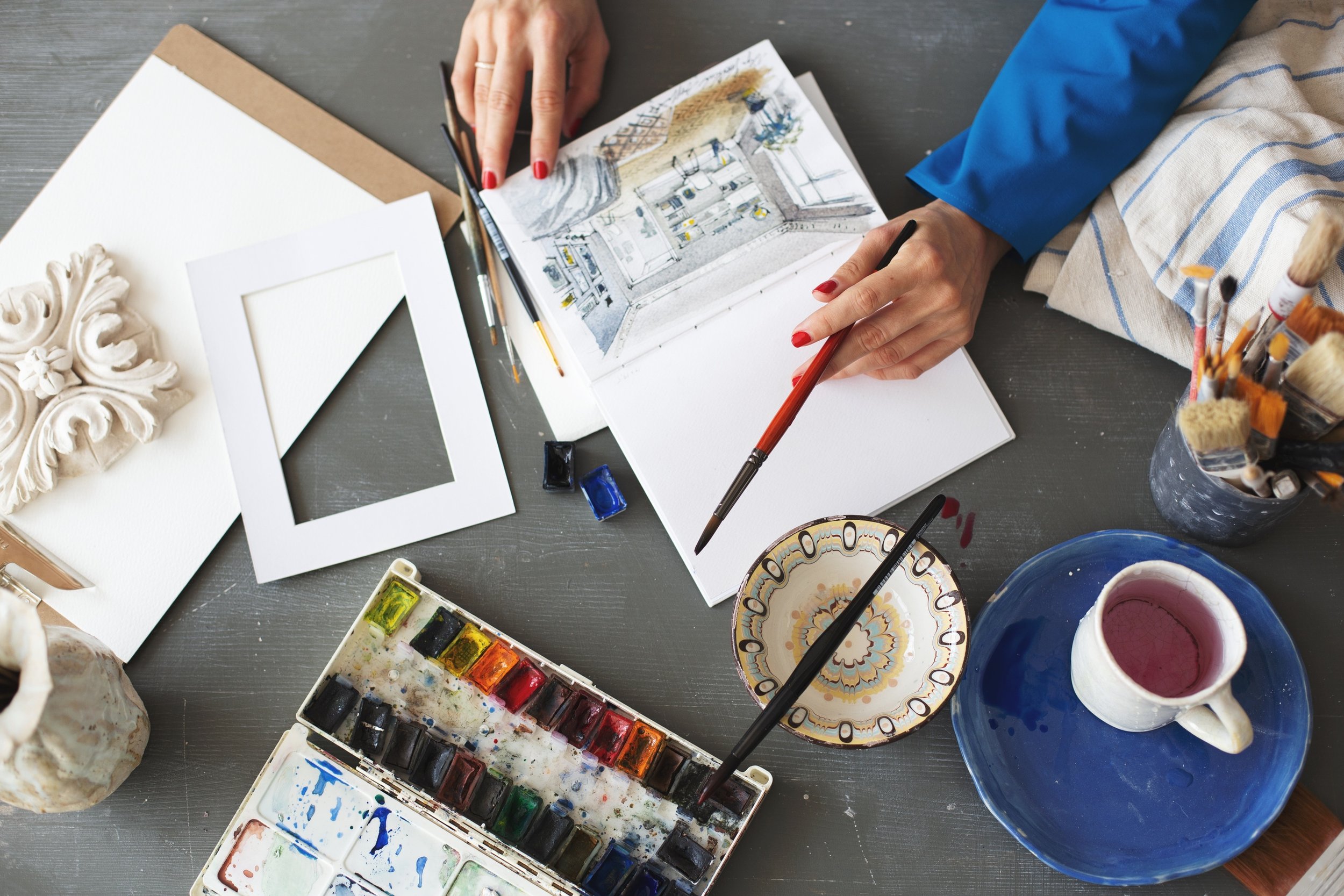Interior sketching is evolving. Learn how to merge hand-drawn expression with digital precision and AI innovation — the future of creative design communication.
Custom Interior Sketches for Clients: My 3 Case Studies in Procreate
This September, I want to talk about something very practical and exciting: how to turn your sketches into real commissions.
Procreate is an amazing tool not only for practice, but also for professional client work. Over the past few years, I’ve created a number of commissioned sketches entirely in Procreate: from concept drawings to interior design proposals.
In this post, I’d love to share three case studies with you. For each project, I’ll show the line version and the colored version, and explain how the sketches evolved into final results for clients.
Case Study 1:
Sketch for a Designer Show House (Dallas, TX)
This commission came from a U.S. client preparing for a Designer Show House. Their request was very specific: “We need the rendering of our room to be more suggestive and less detailed.”
By the time I joined the project, the client already had a fully developed concept package:
a detailed PDF with the floor plan, furniture layout, and action zones,
a separate PDF with material selections,
all furniture and textiles carefully chosen.
My task was not to design, but to translate all this information into a suggestive sketch, one that communicates the atmosphere without overwhelming detail. As always, I began with a line sketch to establish composition and proportions.
Interestingly, this project was also the first time I experimented with coloring in Midjourney. Of course, the final colored version will be fully created by me in Procreate, but I thought you might find it interesting to see some of my Midjourney experiments along the way: watch on my YouTube (3 minute tutorial)
Line version
Color version
Case Study 2:
Police Administrative Building Concept (Florida)
The second commission was for a future administrative building of a police station. Since the architecture was still conceptual, the client needed a sketch that would suggest possible solutions.
Here again, I started with a line drawing. Because the building wasn’t yet constructed, we went through several iterations to adjust forms and space. I worked closely with the lead architect, we even had Zoom calls to refine ideas together.
The final colored version provided a clear and expressive visualization of the concept, supporting the architectural vision while keeping the design flexible for further development.
Line version
Color version
Case Study 3:
Interior Redesign (Los Angeles)
The third project was especially exciting because I was both the interior designer and the sketch artist.
A client from Los Angeles wanted to completely redecorate their existing interior. I developed a proposal and presented it through sketches in Procreate. The process began with a precise line drawing, followed by a colored version that communicated the atmosphere of the redesigned space.
The client loved the result, and this project actually became a bonus lesson inside my Interior Sketching in Procreate Online Course, where I walk you through the entire process step by step.
Line version
Color version
Final Thoughts
Each of these projects demonstrates how powerful Procreate can be for professional sketch commissions. Starting with a line sketch and then moving into a colored visualization not only helps structure the creative process, but also gives clients clarity and confidence in the design.
If you’d like to learn how to create sketches like these, renderings that clients will pay for — my Interior Sketching in Procreate Online Course will guide you through every step.
Inside the course, you’ll discover:
How to build your interior sketch from scratch
Line to colour: my techniques for coloring your sketch professionally
Real client case studies and bonus lessons
Turn your interior sketches into commissions! See program and sketches from the course:
Read more from my blog:
Summer School + Drawing Modernism: Sketching the Red & Blue Chair by Gerrit Rietvild (Zoom Replay)
There are objects in design history that go far beyond their functional purpose. They embody an era, reflect its ideology, and become a language through which we understand the past. One such object is the Gerrit Rietveld’s Red and Blue Chair — a striking symbol of modernism and the focal point of our latest live Zoom session.
Watch the Replay
In this Zoom workshop, we explored the historical and cultural context behind the emergence of modernist design. The early 20th century brought radical shifts in art, architecture, and furniture, and this chair, with its clean lines, purposeful geometry, and uncompromising simplicity, reflects it all.
As I often tell my students: this chair is more than a seat, it’s architecture in miniature. A pure example of the modernist principle, “form follows function.”
We discussed how the political, social, and technological changes of the time shaped design thinking. The idea that design should serve life, not decorate it, was at the heart of the modernist movement, and it’s still deeply relevant in today’s interiors.
If you missed the live Zoom session, the full replay is now available. It includes the lecture, and the live sketching demo. Watch it today:
Note: This video is time-sensitive and will be available only for the next few weeks. After that, it will be exclusively accessible to students enrolled in:
A Book I Recommended During the Session
For those of you who love diving into the history of interiors, I mentioned a fantastic reference during the live session:
”A History of Interior Design” by John F. Pile
You can find it here: https://amzn.to/437ImBb
This is a must-have for interior designers and students who want to deepen their understanding of historical context.
Sketching Materials We Used
Here’s a list of the materials featured in the live demo:
A pencil (I love using Blackwing https://amzn.to/42ugCp5)
A ruler
A few coloured pencils (yellow, black, red & blue)
A black marker
A few sheets of paper A4 (Letter size)
Join the Summer School (Starting May 14th!)
My Interior Sketching Summer School is a 5-week immersive online journey into interior sketching, design thinking, and visual storytelling. You’ll develop the skills to sketch interiors with confidence — while drawing inspiration from design history and architecture.
Whether you’re a design student or an experienced interior designer looking to refine your hand-drawing practice, this program will support your growth with step-by-step lessons, a private WhatsApp chat, and personal feedback on your drawings from me.
Start Date: May 14, 2025
Format: Asynchronous lessons + group support
Note: If you’re already my BASE course student, Summer School is available to you at a special price.
New to my courses? You’re welcome to join too — we’d love to have you.
Learn more about Summer School 2025
Questions about Summer School or my online courses?
Simply email me at olga@schoolofsketching.com
Happy Sketching!
Olga Sorokina
These sketches below were created by my students after just one lesson.
Most of them had no prior drawing experience. Some were certain they couldn’t draw at all.
And yet — with structured instruction, a clear method, and the right guidance — they achieved results like this.
This is exactly what we do inside the Interior Sketching Summer School:
Build a strong foundation, develop clarity in perspective, and translate interior spaces into compelling hand-drawn visuals.
If you’ve been wanting to sketch — not casually, but professionally — this program is designed for you.
We start May 14, 2025. Join us.
Read more from my blog:
Blog Archive: Read Here
Interior Sketching Essentials: Tools, Paper, and Markers
Materials You Will Need for Interior Sketching
To get the most out of my online courses and achieve high-quality sketching results, you’ll need the following materials.
I’ve also included sample links from Amazon for your convenience.
1. Markers and Paper
Alcohol-based markers such as Copic, Molotow, Winsor & Newton Promarker, Zig, Chartpak, Stylefile, or TOUCH (any professional marker brand will work). More on it below.
Marker paper, size A4 or Letter (at least 70g/m2): This lightweight paper helps preserve your markers’ pigment and makes blending easier.
Example: Canson marker PAD
Tip: Regular paper will also work for practice.
2. Grey Markers
At least three shades of gray:
Light (e.g. N2 / C2). Example: Warm Grey #2 (Chartpak)
Medium (e.g. N4 / C4)
Dark (e.g. N6 / C6)
Examples:
Here is a nice Copic grey set of 5 + liner: Copic Sketch Alcohol Marker 5 Colors + Multiliner SP Set, Sketching Grays
Set of 6 from W&N: Winsor & Newton ProMarker Set, 6 Count, Neutral Tones
3. Coloured Markers
At minimum, please prepare these 5 essential colours:
Beige, Sand, or Light Brown. Example: Potato Brown (TOUCH) https://amzn.to/4iU4VPh
Dark Brown or Chocolate
Olive
Deep Red
Deep Blue
Example: Here is a nice set I like: Copic Marker 12 Piece Set - Architecture Colours
4. Highlighting Tools
White pastel pencil (e.g. Caran'd’Ache) https://amzn.to/42kv5Vp
White ink gel pen (e.g. Gelly Roll, Sakura) https://amzn.to/43uVeC3
5. Linework Tools
Black liner or waterproof fineliner (e.g. Copic Multiliner https://amzn.to/3T03Iuf, Uni Liner, Faber-Castell)
Pencil (I use Palomino Blackwing https://amzn.to/42ugCp5), eraser, and ruler
Optional: Architect’s ruler (ideal for precise measurements and drawing to scale). Example: Architect's Scale Ruler (Inches)
Happy Sketching!
Olga Sorokina
Want to Sketch Interiors Like a Pro?
Check out the Program & Sketches from My Online Course
"BASE": a Course Which Teaches All the Basic Techniques You Need to Implement Sketching in Your Interior Design Practice
Professional Interior Drawing Online Training for Designers & Interior Design Students
My Procreate Workshop at iPad for Architects and Designers Summit 2025 (IFA25)
I have a secret project that I haven’t told you about yet…
A few months ago, my friend David from Sketch Like an Architect asked me if I was interested in teaching a workshop at the iPad for Architects & Designers Summit this year. Lots of work and behind-the-scenes communications went on for months and now I’m excited to finally let you know that…
… iPad for Architects & Designers is officially open for registration!
iPad for Architects & Designers 2025 (IFA for short) is Free 6-day Online Event with 20+ Video Workshops Focused on Helping Design Professionals Make the Most of their iPad.
I’m excited to be one of the 20+ amazing instructors in the event – in my online workshop, I’ll be teaching/sharing with you my behind-the-scenes of making an interior sketch commission in Procreate.
What you’ll learn from my session:
+ My full Procreate workflow – from underpainting to final details
+ How to use the right brushes and techniques to create textures like wood, velvet, and reflections
+ Time-saving methods to optimize your process and work faster
+ How to present your sketches professionally for clients
Check All the 20+ Instructors Here
Oh, and the most important thing… this online event is totally FREE from March 25-30. That’s right, 20 workshops, one week only (March 25-30), all for free!
But, pssss, you have a secret option to enroll today wish you choose a VIP ticket during the registration.
Can’t wait to see you there!
Olga Sorokina
Want to master interior sketching in Procreate from scratch?
Check also my “Interior Drawing in Procreate“ online course:
How to Draw Interiors Fast?
If you want to speed up your sketching, here are some of my key tips to help you draw faster without losing quality:
1. Practice Gestural Drawing:
Quick, loose sketches help capture the essence of your subject. I love practicing with live model drawings—it’s a fantastic way to improve speed and fluidity.
2. Master Marker Techniques:
Learn how to use different marker widths. For example, a wide chisel nib is great for covering large areas quickly, while a thin nib is perfect for finer details. Rotate the marker in your hand to create lines with varying thicknesses.
3. Leave White Space:
Don’t feel the need to color every single detail. Leaving white space gives your drawing air and makes it feel more alive. Let your sketch breathe!
4. Use What I Call “Enlivenings” in My Book “The SKETCH. Interior Design Drawing”:
These are quick fine-tuning touches—add accents or a few design objects to bring your sketch to life in seconds.
5. Time Yourself:
Set a time limit. Often, working under pressure forces you into your creative brain, bypassing overthinking. Quick sketching is liberating!
6. Use a Limited Color Palette:
Choose a palette of 3-4 colours and stick with it. Test your colours on a scrap of paper to make sure they work well together—keeping it simple speeds up the process.
Check the bonus tip, watch my today's video on YouTube: click here to watch
In that video, you can see 3 quick sketches I teach how to draw in my brand new lesson in PRO online course.
Learn how to draw interiors like a pro, master advanced sketching techniques, and take your skills to the next level. Check out online course PRO details here: click
Check my blog archive: here
Happy Sketching!
Olga Sorokina
Interior Sketching Series: A Recap of My 1-,2-,3-Point Perspective Demos
Welcome back to the blog!
Over the past few weeks, we've embarked on an exciting journey through the world of interior sketching. Our three-part series covered essential techniques to help you create stunning interior sketches with confidence and ease.
In case you missed any of the sessions, here's a comprehensive recap of what we learned.
Day 1: Understanding 1-Point Perspective
On the first day, we dove into the basics of 1-point perspective with a practical sketching demo focused on a bathroom.
Key Takeaways:
- Vanishing Point: The concept of the vanishing point and how all lines converge towards it.
- Horizon Line: Placing the horizon line correctly to establish the viewer's eye level.
- Drawing a Bathroom: Applying 1-point perspective to sketch a bathroom, emphasizing depth and proportion.
Day 2: Mastering 2-Point Perspective
Building on our foundation, day two was dedicated to 2-point perspective with a focus on sketching a dining room.
Key Takeaways:
- Two Vanishing Points: Understanding how to use two vanishing points on the horizon line to draw objects at an angle.
- Drawing a Dining Room: Moving beyond simple shapes to sketch a dining room, capturing its dynamic angles and interior elements.
- Practical Applications: Using 2-point perspective to sketch furniture, room corners, and various interior elements from different viewpoints
Day 3: Exploring 3-Point Perspective
Our final session introduced the advanced technique of 3-point perspective with a focus on a wardrobe interior.
Key Takeaways:
- Three Vanishing Points: Adding a third vanishing point, below the horizon line, to create a sense of height and depth.
- Drawing a Wardrobe Interior: Understanding how the addition of the third point distorts the objects, making them appear more three-dimensional.
- Applications: Practical demo of using 3-point perspective to sketch tiny interiors like wardrobes, home offices, etc.
Mastering 3 points allows you to bring a new level of dynamism and drama to your sketches, making them truly stand out.
Additional Resources
Materials Used: Sketchbook, Markers and Fineliners
For all days of the series, I used markers and fineliners to create the sketches. These tools are essential for achieving clean lines and vibrant colours in your interior drawings. Here are the Amazon links to the materials I used:
- Markers: I use Sketch&Art Terracotta in the videos, but here is an Amazon set of 60 Colours https://amzn.to/4bu1aLZ
- Sketchbook: I used similar to this one, Hahnemuehle size A5 https://amzn.to/4bt1Elq
- Fineliners: I used Milan Sway fineliner on Day 1 https://amzn.to/3zrs9KZ , for Days 2 and 3 I used a waterproof fineliners from UniPin https://amzn.to/4f9YBBT
Instagram Live Stream: Perspective Drawing
Between Day 2 and Day 3, we had an insightful Instagram live stream where we delved deeper into perspective drawing. We discussed tips and tricks, I answered your questions, and provided additional information on my online course BASE. Watch the replay.
Live Q&A Session: Final Thoughts and BASE Course Introduction
To wrap up the series, we held a live Q&A session on Instagram where I answered your questions and provided further insights into interior sketching. During this session, I also introduced my online course, BASE, which offers comprehensive lessons, community support, and exclusive content designed to take your interior sketching skills to the next level. Watch the Q&A replay here.
Wrapping Up the Three-Part Series
Throughout this series, we've covered the essential perspectives that form the backbone of interior sketching. From the basics of 1-point perspective to the complexity of 3-point perspective, each session built upon the last to enhance your sketching skills.
I hope you found these sessions both informative and inspiring. Sketching interiors is not only a valuable skill for designers but also a rewarding creative outlet. Remember, practice is key! The more you sketch, the more confident and proficient you'll become.
What’s Next?
If you enjoyed this series and want to dive deeper, I invite you to join my online course, BASE. It offers structured lessons, and in-depth exclusive content to help you master interior sketching. Learn more about the course here.
Thank you for following along, and I can’t wait to see the incredible sketches you create! Use the hashtag #SorokinaStudents on Instagram and tag me @schoolofsketching so I can see your drawings.
P.S. Enjoyed the article? Please share it with your creative friend, let’s spread the word about interior sketching together.
© Olga Sorokina, 2024
"BASE": a Course Which Teaches All the Basic Techniques You Need to Implement Sketching in Your Interior Design Practice
(Perfect if you are a novice in drawing interiors, interior designer, id/architecture student)
Interested in the topic of perspective drawing?
You might like to check these articles from my blog:
Read more from my blog:
Blog archive: here
"BEFORE" and "AFTER": interior sketches made by my students (fantastic progress)
Recognizing your progress is essential. At times, it may seem like you're endlessly drawing without seeing improvement in your skill level. However, by comparing two drawings—one from now and one from a year ago—you'll immediately notice the changes. Allow me to showcase a few examples from my students where the results speak volumes. As I love to say: “Practice makes progress“.
1 Example
Take a glance at the sketches by my student, Kate, before and after enrolling in my courses. The transformation is remarkable, wouldn't you agree? We witness not only a mastery of perspective but also a skillful depiction of textures and an impressive presentation of interior design ideas. Kate successfully completed the comprehensive “BASE+PRO“ Bundle at my Online School.
2 Example
Similarly, observe the watercolor works of another student, Polina. Post-course completion, Polina's drawings exhibit enhanced detail and professional rendering. Polina diligently completed all of my interior sketching courses, including WATERCOLOR, BASE+PRO, TEXTURES.
3 Example
In the "BEFORE" photo, you'll find Anastasia's very first interior sketch from my perspective challenge. Following her completion of courses in interior sketching (BASE+PRO, TEXTURES) witness the breathtaking "AFTER" result! It's worth noting that Anastasia's professional background lies in land surveying, without any formal training in the arts. Yet, her dedication and the guidance from my courses propelled her into a successful sketch artist.
4 Example
In the "BEFORE" photo, you'll find one of Heather’s very first interior sketches she made before enrolling in my online courses. Following her completion of my online courses in interior sketching BASE, FURNITURE, TEXTURES, PERSPECTIVE, take a look at the the outstanding "AFTER" result! I’m so proud of my students!
“Practice makes progress”
In each of these instances, my students transitioned into full-time freelance sketch artists, securing interior sketch commissions. It's inspiring to note that even with completion of just the "BASE" course, many students began receiving their first sketch commissions. This demonstrates that achieving success in this field is within reach for anyone.
For further inspiration, explore more sketches crafted by my students on Instagram using the hashtag #SorokinaStudents
Join hundreds of designers who are currently taking my Interior Sketching course.
"BASE": a Course Which Teaches All the Basic Techniques You Need to Implement Sketching in Your Interior Design Practice
Related blog article: Open Day at Olga’s Online School of Sketching
DO YOU WANT TO IMPROVE YOUR SKETCHING LEVEL?
See the program of my online courses: here
HAVE A QUESTION?
Email me at olga@schoolofsketching.com
Read more from my blog:
Interior Drawing: My 3 Rules of Custom Sketches
Having honed my craft working with esteemed interior designers since 2007, I've distilled three essential rules for custom sketching.
These rules are the product of my experience, offering guidance for success in the custom sketching world.
Let’s dive deeper in this article.
Rule #1
The first rule of custom sketching is: "Never draw to order without prepayment".
It is best to draw on prepayment of 100% or 50%. With 100% it's clear, you get paid first, then you start sketching. So your nerves will remain in the most healthy state :-) Of course, the customer in this case needs some proof that you do not disappear, do not leave him and draw everything qualitatively and in time.
Rule #2
The second rule is, "Never draw for someone for free!"
If for someone this rule is not obvious, then know that drawing to order for free/for nothing/for the goodness of your heart/for a portfolio you thereby discredit yourself and other artists. It is interesting to note that when you offer to draw for free, your reputation and professionalism fall in the eyes of the customer. Incredible but true! By the way, I'll tell you in confidence that decent customers try to stay away from such sketchers-altruists, afraid that they may be let down or do not meet expectations for the quality of work and deadlines. For them it looks like just inadequacy, also it is disrespect for their labor, and often themselves from a professional point of view, plus insecurity.
Rule #3
Third rule: "Name a decent price for your sketches".
No sketches for 15 dollars. Customers, who will appear in your life for such a price, most likely, will suck all the energy out of you, you will spend a lot of time/nerves on drawings, plus, you will be constantly asked to redo something, to make new and new changes in the project and in the end, for 15 dollars you will sit for sketches for days on end, without seeing daylight, working non-stop in the equivalent of one or two working weeks of an ordinary person with an average salary. There's a very good English expression for this: "The more they pay - the less they complain”. Your clients are your mirrors, how much you value yourself, your talent and professionalism, the higher your confidence in what you do — the better and more well’ paid your clients will be. Trust me, I learnt that the hard way.
To summarise:
Rule #1: Never sketch without prepayment to secure compensation and reduce stress.
Rule #2: Avoid working for free, as it can harm your reputation and professionalism.
Rule #3: Set fair prices to maintain your energy and professionalism.
Now, if you're eager to delve deeper into the art of interior sketching, I invite you to join my online course on interior drawing. Let's unlock your creative potential and take your skills to new heights. Explore my course “BASE“ and start your journey to becoming a skilled sketch artist today!
P.S. Please share this article with your creative friend.
© Olga Sorokina, 2024
"BASE": a Course Which Teaches All the Basic Techniques You Need to Implement Sketching in Your Interior Design Practice
Blog archive: here
Perspective Drawing for Beginners: Welcome to My Perspective Series
Welcome to the culmination of our 3-Day Perspective Drawing Series, where we've delved deep into the art of creating depth and dimension on a two-dimensional surface. Over the past three days, we've explored fundamental concepts, practical techniques, and creative applications of perspective drawing.
Let's take a moment to recap the highlights from each day of this journey.
Day 1: Perspective Drawing Basics
On Day 1, we laid the foundation for our exploration by diving into Perspective Drawing Basics. We introduced the concept of perspective, the visual illusion that allows us to represent three-dimensional objects on a flat surface. Two crucial types of perspective were unveiled: the frontal view (1-point perspective) and the oblique view (2-point perspective). Through step-by-step demonstrations, we learned how to draw boxes in both 1-point and 2-point perspective, mastering the art of creating depth in our sketches.
Day 2: Mastering Circles in Perspective
Building upon our understanding from Day 1, Day 2 challenged us to tackle the intricate task of drawing circles in perspective. We learned how to overcome common challenges and avoid major mistakes when sketching ellipses, crucial elements for rendering cylindrical objects realistically. Through detailed instructions and hands-on practice, we honed our skills in drawing circles and ellipses, unlocking new possibilities for adding depth and realism to our artwork.
Day 3: Drawing Cylinders in 1-Point Perspective for Interior Design
In our final installment, we ventured into the realm of interior design, exploring how perspective drawing principles can be applied to create immersive spaces. Focusing on drawing cylinders in a 1-point perspective, we discovered techniques for rendering cylindrical objects within architectural contexts. From furniture to decorative elements, we learned how mastering perspective drawing enhances our ability to design and visualize interior spaces with precision and creativity.
Unlock Your Potential with Perspective Drawing
As we conclude our journey, I invite you to continue exploring the endless possibilities of perspective drawing. Whether you're a beginner seeking to master the basics or an experienced artist looking to refine your skills, the principles of perspective offer a gateway to boundless creativity and expression.
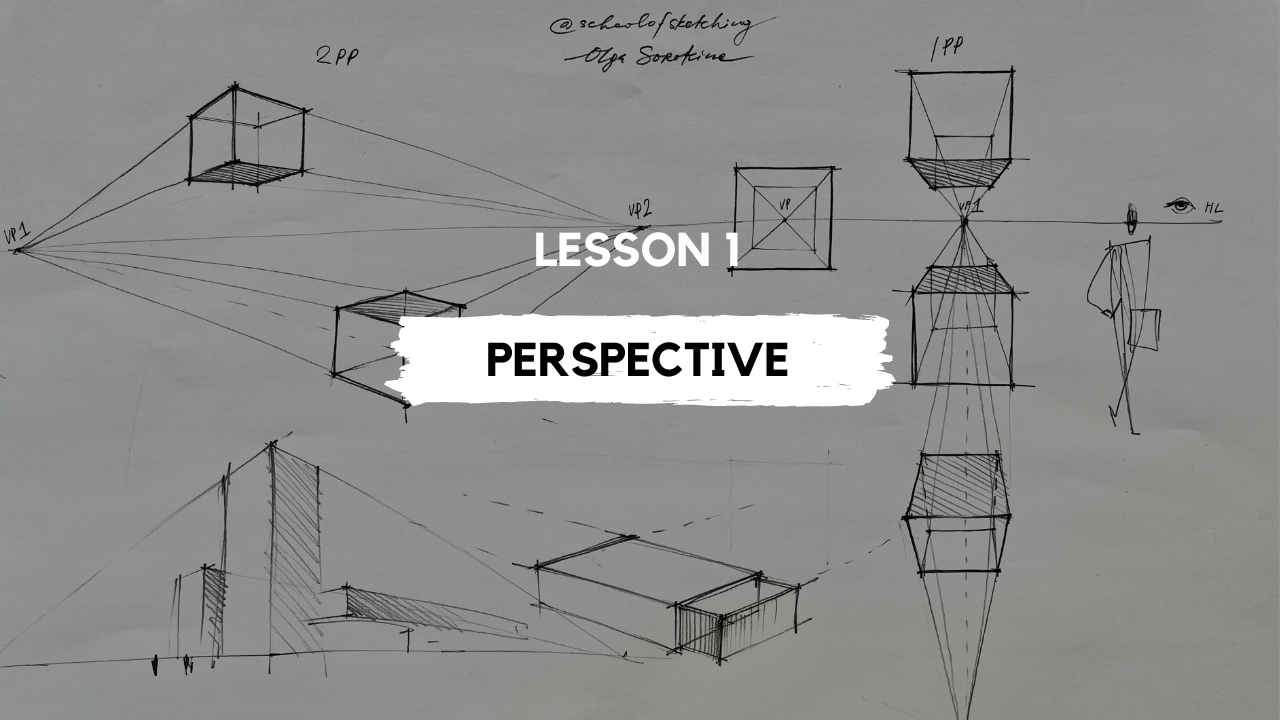


Elevate Your Skills with "Perspective Drawing for Interior Design" Course
Ready to take your perspective drawing skills to the next level? Dive deeper into the world of interior design sketching with my online course, "Perspective Drawing for Interior Design." Learn in the most efficient way from someone who has actually done it – me!
In this comprehensive course, I'll guide you through easy-to-follow, step-by-step instructions that fit your schedule. Whether you're a seasoned designer or just starting out, you'll gain the skills and confidence to win better projects, charge more than your competitors, and elevate your interior design game.
Don't just take my word for it – check out the rave reviews from students who have already enrolled in this course. Join us and unlock your potential with "Perspective Drawing for Interior Design" today!
One of the sketches from the course “Perspective Drawing for Interior Design“
Happy sketching!
P.S. Please share this article with your creative friend who might be interested in perspective drawing.
© Olga Sorokina, 2024
Read more from my blog
Check My Blog Archive: here
The Best Fineliners for Interior Sketching: A Comprehensive Overview with Sketch Examples
When it comes to interior sketching, the right tools can make all the difference. As a sketch artist deeply involved in the world of interior design, I've put together a comprehensive overview of the fineliners I swear by.
In this article, we'll delve into the world of fineliners, comparing their performance on different papers, showcasing my interior sketches, and providing a detailed analysis to help you choose the best liner for your artistic endeavors.
Why fineliners?
Fineliners are an essential tool for any sketch artist, providing precision and control that can elevate your sketches to a new level. They are ideal for interior sketching – from line precision to ink quality and durability.
For those who prefer visual demonstrations, I've created a video where I compare the fineliners in action. This video will give you a firsthand look at how these artist pens perform and help you make an informed decision. Explore the unique qualities each liner brings to the table and how they contribute to the overall aesthetic of the sketches.
In this video, I'll show how the liners fare on different types of paper – regular paper, marker pad, and thick sketchbook paper. You will see how the choice of paper can significantly impact the outcome of your line. Understanding their performance on various surfaces will help you choose the right artist pen for your preferred sketching environment.
In this video, I also mentioned my 16-Day Instagram 5-Minute Sketch Challenge, here is a quick overview of the sketches I did there: watch
Amazon links
Artistic tools come in various price ranges, and it's essential to find a balance between quality and cost. Here are the Amazon links for your convenience. As an Amazon Associate I earn from qualifying purchases.
Liners that I show in the video (or similar):
(1) Copic Multiliner 0.5:
(2) Copic Multiliner SP 0.3 (refillable):
(3) Sharpie Pen:
(4) Pentel 0.5 Liner:
(5) Touch Liners (I had this a a set):
(6) Micron (set in black):
(7) Faber-Castell Artist Pen (raw umber) B:
(8) Faber-Castell Artist Pen (a good set):
(9) STAEDTLER set (even though I don’t show this liner in the video, I love it and used to use it quite a lot and plan to buy it again):
Are you ready to make your own choice?
In conclusion, the world of fineliners offers a myriad of choices, each with its own strengths. Based on my experiences, I recommend those mentioned above as the best fineliners for interior sketching. However, personal preferences play a significant role, so feel free to explore and find the one that resonates with your artistic style.
As you embark on your artistic journey, keep in mind that the right fineliner can be a game-changer. Experiment with different options, share your thoughts, and let the creative process unfold. I hope this overview helps you find the perfect fineliner.
Resources
Download my PDF-list of all the materials I use for interior sketching (markers, paper, etc): here
Read also related articles on my blog:
“Which Brands and Colours of Markers are the Best Choice for Interior Sketching?”
“Top 10 factors that affect the cost of an interior sketch” (blog article+link to my live stream)
Please let me know in the comments which liners do you use and if you are happy with them.
Happy sketching!
P.S. Please share this article with your creative friend.
© Olga Sorokina, 2024
"BASE": a Course Which Teaches All the Basic Techniques You Need to Implement Sketching in Your Interior Design Practice
Read more from my blog
Blog Archive: here
Understanding Positive and Negative Space: Elevate Your Interior Design Drawings
In the dynamic world of interior design, the principles of positive and negative space are akin to the artist's brushstrokes on a canvas, shaping the aesthetic and functional essence of a space. As we delve into the realm of interior design drawing, these fundamental concepts take center stage, serving as the blueprint for creating spaces that are not only visually stunning but also harmoniously functional. Let’s dive deeper in this article.
Positive Space: Where Design Comes to Life
In the realm of interior design drawing, positive space constitutes the tangible elements that define and fill a room. Imagine the furniture, fixtures, and decor items—the elements that breathe life into the design. When sketching an interior space, positive space is the canvas upon which the designer articulates their vision, carefully placing each item to create a cohesive and purposeful environment.
Negative Space: The Unspoken Elegance
As the unsung hero of interior design, negative space plays a pivotal role in enhancing the overall aesthetic. It's the open floor space, the unoccupied walls, and the areas around and between furniture. In the realm of drawing, it's the blank canvas that allows for the articulation of design, contributing to the sense of openness, flow, and balance within a room.
Strategic Applications in Interior Design Drawing:
1. Furniture Choreography:
- The arrangement of furniture is a dance between positive and negative space. In your drawings, consider how each piece contributes to both functionality and visual appeal, creating a symphony of form and function.
2. Navigating Traffic:
- Intelligently managing negative space ensures smooth traffic flow within a room. It's about creating paths that are free from obstruction, fostering a sense of ease and practicality in the design.
3. Harmonious Balance:
- Achieving the perfect equilibrium between positive and negative space is the key to a visually stunning interior. Striking this balance prevents a space from feeling cluttered or sparse, fostering a sense of visual delight.
4. Artistic Framing:
- Negative space acts as a framing device, directing attention to architectural features, artwork, or designated focal points. It's the whitespace that enhances the significance of design elements within your interior composition.
5. Visual Comfort:
- A well-considered distribution of negative space contributes to visual comfort. It ensures that a space is inviting, providing individuals with the freedom to relax and engage with the environment.
6. Spatial Symphony:
- Mastering the interplay between positive and negative space is the art of spatial planning. It involves not just meeting functional requirements but doing so in a way that captivates the eye and evokes a sense of balance.
In the realm of interior design drawing, understanding the dance between positive and negative space is the hallmark of a skilled designer. Just as a maestro conducts an orchestra, an adept designer orchestrates a symphony of elements on paper, setting the stage for a beautifully realised interior. As you embark on your design journey, let positive and negative space be your guiding notes, creating spaces that are as functional as they are visually captivating.
(Quick note) Elevate Your Gallery Experience:
As you embark on your design journey, consider applying the principles of positive and negative space to your appreciation of art. The next time you visit an art gallery, focus on the negative space in the paintings. Notice how the deliberate use of empty space enhances the impact of the artwork, guiding your gaze and influencing your emotional response. You'll find that this heightened awareness transforms your gallery experience, allowing you to see and appreciate art in a new and enriching light.
Happy sketching!
Olga Sorokina
Master drawing furniture with my online course for beginners:
Shadows and Light: The Interior Artist's Guide to Mastering Value Study Techniques
In this article, I'd like to underscore the significance of incorporating a value study into your interior drawings.
It's quite common to observe beginners using a pleasing colour palette for their sketches. However, a key aspect often overlooked is the variation in tones. Without a thoughtful value study, the sketch tends to appear flat and lacks the dynamic contrast that brings it to life.
The secret to enhancing your interior sketches lies in mastering the art of value study.
“Sketching teaches us to become very observant, to see nuances.”
A “value study" in drawing refers to the exploration and representation of different shades of light and dark within an artwork.
When it comes to interior drawing, understanding and effectively depicting values are crucial for creating a sense of depth, lighting, and atmosphere.
Here is a quick guide on how to approach a value study for interior drawing:
Identify Light Sources:
Determine the primary light sources within the interior space. This could be sunlight streaming through windows, artificial lighting from lamps, or a combination of both.
Note how the direction and intensity of light affect different surfaces and objects in the room.
Define Major Forms:
Identify the major forms and shapes within the interior, such as furniture, architectural elements, and decorative items.
Use values to accentuate the three-dimensional qualities of these forms. Consider how light and shadow play across surfaces.
Establish a Focal Point:
Decide on a focal point within the interior. This could be a specific area, object, or piece of furniture that you want to draw attention to.
Use a higher contrast around the focal points or key elements in the foreground, making it stand out within the composition. This not only directs attention but also adds to the perception of depth by making those elements visually prominent.
Consider Material and Texture:
Different materials and textures within an interior space will reflect light differently. Pay attention to how values can convey the characteristics of materials, such as the shine of polished surfaces or the softness of fabrics.
Experiment with variations in shading to depict a variety of textures realistically.
Balance Light and Shadow:
Achieve a balance between light and shadow to create a visually appealing composition. Avoid overly bright or dark areas unless intentional for artistic purposes.
Use mid-tones to connect light and shadow, allowing for smooth transitions and a cohesive overall look.
Utilize Reflections:
If there are reflective surfaces like mirrors or glossy furniture, consider how they interact with light sources and surrounding elements. Reflections can enrich your value study.
Experiment with Different Times of Day:
If possible, explore how the lighting changes throughout the day. Different times of day can significantly impact the mood and atmosphere of an interior space (think here “Haystacks” by Claude Monet).
Morning and evening light, for example, may create long shadows and warm tones, while midday light can be brighter and more direct.
Create Atmosphere:
Use values to establish the overall atmosphere of the interior. A well-executed value study can convey the mood of the space, whether it's cozy and intimate or spacious and airy.
Practice Depth and Perspective:
Use values to emphasize the sense of depth and perspective in the room. As objects or surfaces recede into the background, gradually decrease the intensity of values. Darker values in the foreground will contrast with lighter values in the distance, creating a sense of depth. Emphasize the contrast between light and shadow in the foreground. Remember that objects in the distance often have softer, less defined edges due to atmospheric effects.
Refine Details:
Pay attention to details in your interior drawing. Use values to highlight intricate details in furniture, patterns on surfaces, and other elements that contribute to the overall realism of the scene.
Remember that achieving depth and perspective in a value study requires a balance between accurate observation and artistic interpretation. Experimenting with these techniques will help you create interior drawings that not only capture the spatial relationships but also convey a convincing sense of depth through the effective use of values. Observe real interior spaces, study how light interacts with various elements, and practice consistently to enhance your skills in depicting values in interior drawings.
P.S. Hope you enjoyed this article, please share it on your social media so more Creatives can learn about the importance of value study and interior sketching.
© Olga Sorokina, 2024
Drawings from my online course on watercolour techniques in interior sketching. Learn more here
Transform your interior drawings with depth and perspective in my online course “Interior Sketching in Watercolour“
See my blog archive: click here
Perspective Drawing Explained: 7 Types of Perspective in Interior Sketching
In this article, I'll introduce you to seven exciting perspective techniques that I employ in my interior drawings. From the fundamentals of 1-point and 2-point perspectives to the fusion of 1+2, "distorted" perspectives, and more, discover how each technique can bring depth and uniqueness to your sketches. Join me on this creative journey to the art of perspective drawing.
In the world of interior sketching, perspective is the key to bringing your designs to life on paper. Whether you're a budding artist or an experienced designer, mastering different perspective techniques is essential. In this article, we'll explore seven intriguing types of perspective that can add depth, dynamism, and uniqueness to your interior sketches.
(1) One-Point Perspective (Frontal Perspective):
The fundamental technique for interior sketching, that forms the backbone of interior sketching. Here, we have only one vanishing point on the horizon line, but it forms everything.
Read also related article on my blog for a more in-depth exploration of 1-point perspective:
“The 9 principles of one-point perspective in interior sketching”
(2) Two-Point Perspective (Oblique View):
Here we can see two vanishing points on the horizon line, adding an extra dimension of dynamism to your drawings compared to the more static nature of 1-point perspective.
Read also related article on my blog:
“The 6 principles of two-point perspective in interior sketching”.
(3) Combined Perspective (1+2):
A fusion of 1-point and 2-point perspectives, with some furniture objects having their own 2-point perspective. In this sketch, you can see a blend of 1-point perspective for the room and 2-point perspective for the objects, in this case, two classic bergere armchairs. What makes this perspective truly captivating is that each chair has its own set of 2 vanishing points. Here, things get intriguing with a total of 5 vanishing points!
In my online course BASE, I'll guide you step-by-step in drawing this French interior.
(4) "Distorted" Perspective:
Some love it for the dynamism it brings, while others find it challenging. It's a unique fusion of one-point and two-point perspective. I find it really profound as it brings a lot of dynamic to the sketch. With "Distorted" Perspective, the back wall (also referred to as the frontal wall at times) takes on a trapezium shape, in contrast to the rectangular form of the back wall in our 1-point perspective (please take a look at my drawing below). This transformation adds an intriguing element of dynamism to your sketches, making it a captivating technique to explore.
You can learn how to create this captivating effect in my online course PRO.
(5) "Elevated" Perspective with Two Vanishing Points:
Ideal for small spaces like bathrooms and home offices, this technique can add a new dimension to your designs.
Join me in THE CLUB and explore how to create interiors with this perspective.
(6) "Elevated" Perspective with Three Vanishing Points:
Take your perspective skills to the next level with three vanishing points, offering even more depth and complexity to your sketches.
Let’s draw this interior together in my online course PRO.
(7) Four-Point Perspective:
Think about it as two sets of 2-point perspective.
You can draw this classic oval bench with me in my online course “FURNITURE“.
In my practice, I most often utilise the fundamental 1-point and 2-point perspectives, which form the backbone of interior sketching. Remember, the best way to make good interior sketches by hand is to make a lot of them, quickly and spontaneously, until it becomes natural for you.
To further dive into the art of interior sketching and discover the nuances of these perspective techniques, be sure to check out my 35-minute Instagram live stream where I explore this topic in greater detail: watch here.
DEMYSTIFY PERSPECTIVE DRAWING
Perspective drawing might seem complicated or intimidating, but with my Perspective Drawing for Interior Design course, it becomes fun and easy.
My step-by-step approach ensures you'll finally understand perspective, transforming your sketches and boosting your confidence.
Do you want to master perspective drawing for interior design from scratch?
Welcome to my online course
“Perspective Drawing for Interior Design“
P.S. Hope you enjoyed this article, please share it on your social media so more people can learn about perspective drawing and interior sketching.
© Olga Sorokina, 2023
See my blog archive: click here
Marker choice: my favourite marker sets for interior/architecture sketching from Amazon
This article will help you realize and select what exact materials you will need to start sketching, which brands of markers would be the best choice for you, I will share what I use in my sketching routine, you will get direct links here to my absolute favourites. You can use this list as a guide while shopping on the Internet. Also, you will learn which marker brands can be potentially damaging to your health.
Please note, links I provided here are affiliate; if you buy, I make a commission (at no extra cost for you!). As an Amazon Associate I earn from qualifying purchases.
Here I will recommend a variety of brands to choose from, but If I were to pick my absolute favourite marker brands, it would be Copic and Touch. They both have a vast array not only of colors but also of marker tips. In Copic, for example, these include ‘Classic’ markers, ‘Extra Wide’ ones, the thin ‘Ciao’ markers, and remarkable ‘Sketch’ (the last two have brush points). Copics are more pricy; Touch markers are more affordable. Here I also share Stylefile and Chartpak brands, which are quality and quite affordable.
I don’t recommend you use Touchfive, Touchnew, and Vista Artista markers since their quality not as good as their price (yes, they are cheap), not to mention that they can be damaging for your health, especially for the lungs. My students and I tried these markers, and unfortunately, we didn’t enjoy drawing with them.
Professional markers usually have two nibs: a wide one (chisel, wedge-shaped) on the one side and a thin one on the other (fine liner tip), or it can be a brush nib with the thin one.
Side note: I’m a big fan of brush nibs; they are my absolute favourites.
Some markers are refillable (like Copic, for instance); some are not (like Promarker or Stylefile, for example).
YOU CAN DOWNLOAD MY PDF "MATERIALS FOR INTERIOR SKETCHING".
ENTER YOUR NAME AND EMAIL HERE:
Gray marker sets:
Grays go first. I purchase grays more often than any other colour. Why? Grays are the most important in interior drawing since they create tone and value, background and shadows in your sketch. A set of grays might be your first purchase when you get serious about interior sketching.
1. COPIC 5 grays at least are essential, but «the more grays – the better».
Take a look at this 5 Sketching Grays Copic Sketch Set of Markers (5 markers + multiliner). Refillable markers and replaceable nibs:
2. COPIC 12 grays is my favourite set of grays; it’s great if you’re serious about interior sketching or consider to draw sketch commissions in future, then check this Copic Classic set:
3. TOUCH 6 grays. It is an excellent alternative to Copic, Touch markers are really good, plus they are cheaper than famous Copic:
4. TOUCH 12 grays. Here is a nice set of warm grays, ShinHan Touch Twin Brush Marker Set 12WG Warm Grey:
5. STYLEFILE 12 grays. Stylefiles are also perfect quality markers for interior sketching. Double-ended with fine and broad nibs, but they are not refillable as Copic, for example. Look at this Brush Marker-Neutral Grey Set:
6. STYLEFILE 12 grays. The same set but with wedge and fineliner tip, if you prefer wedge nibs instead of brush ones:
7. CHARTPAK Gray Set. There are 22 greys+3 blacks. They are not refillable, one-nibbed, but excellent quality. Chartpak is markedly different from the markers mentioned above. These markers have one very wide tip, that is highly convenient for interior sketching. The only disadvantage is that these markers have a rather strong smell of solvent. This 25 colours set contains 22 grays (warm, cool and neutral), plus three blacks:
8. LETRASET/ WINSOR & NEWTON I like 6 Neutral Tones Set from Letraset (as I mentioned, grays are the most usable markers in interior sketching). These markers are not refillable. Recently Letraset ProMarker brand was renamed to Winsor & Newton ProMarker, but the marker quality stays the same:
Coloured marker sets:
When purchasing colored markers, focus on earthy, wooden tones. Yes, you will need some basic bright colors like red, yellow, green, etc., but you will not need five reds or seven violets, which are usually included in marker sets for manga drawing, for example. Our aim is an interior design and architectural drawing.
Here are some sets where grey colors are already provided, so you can purchase any of them and have it all: grays and colored markers all in one. Or maybe you prefer to buy gray and color sets separately. Here is the list of my favorites:
1. CHARTPAK Architecture Set, (25 colours):
2. TOUCH Twin Brush Marker Set B (48 colours). NB: Grays are included here!
3. TOUCH If you want more bright colours check Touch Twin markers (60 colours) with fine tip nib on one end and a medium-wide chisel nib on the other:
4. COPIC ciao Set B. It was my very first Copic marker set. I remember at the time how pricy it was for me but at the same time how happy I was when I got it! This set was an excellent investment for my business. Copic Ciao is more affordable in comparison with Copic Classic or Copic Sketch.
5. COPIC INK REFILLS They are available in all 358 colours of Copic palette, but I need only my top-frequently-used Copic colours such as grays, for example, this one:
6. STYLEFILE markers (24 colours, grays are included here). If you are looking for your first and relatively affordable set, I would have started with them:
7. STYLEFILE markers (24 colours), these are double-ended but with brush tip:
Side note: you can purchase markers one at a time to get familiar with a new brand, for instance, with Letraset:
P.S. Please share this blog article with your friends, thank you in advance.
© Olga Sorokina
Read other articles on my blog:
Top 5 books on perspective drawing: my personal choice
In this article, I will share with you my absolute favourite books on such a hot topic as perspective drawing for interior designers, architects, and urban sketchers.
Please note, links I provided here are affiliate; if you buy, I make a commission (at no extra cost for you!). As an Amazon Associate I earn from qualifying purchases.
P.S. Find your special gift at the end of the article.
“The artist’s business is to be able to draw an object so that it will look solid and not flat like the surface of the paper on which it is drawn. In so doing that artist employs a method that we call perspective.”
"The SKETCH. Interior Design Drawing"
Olga Sorokina (click for a direct link on Amazon)
I'm happy to include my book on this list. I wrote it specifically for interior designers as well as interior design students who want to master perspective drawing and interior sketching with markers from scratch.
This is a very actionable and quick-read book that, if you would work with, will change your interior design project presentation and, possibly, even your whole creative life. I share my story in the book and how sketching transformed my life. I designed "The SKETCH "particularly for beginners in freehand sketching and for those who want to master a fantastic skill of hand rendering for better performance on the interior design scene. In case you want to make drawing commissions your new job (often called "sketch artist"), you will find inspiration here.
Here you will find a lot of tools, tips, and tricks for freehand sketching, examples of some of the masters of the craft, recommendations for materials. Students need to practice from the book with the step-by-step exercises. Richly illustrated, this little black and white book can serve as a source of great inspiration, and for some of you, it is going to become an excellent small table book.
My book is available in PDF version here
Paper-based from Amazon here.
“Drawing Perspective. How to See It and How to Apply It”
Matthew Brehm (click for a direct link on Amazon)
One of the recent coloured books on perspective, your hands-on guide to this tricky topic (big bonus: it's excellent polygraphy quality). It will be particularly valuable for urban sketchers and artists who love to do outdoor sketching since the majority of the examples featured are those drawn from location. No dry theory, but it does explain in a playful way how perspective works. Probably, one of the most straightforward books to read as it explains every type of perspective drawing so clearly.
I believe it will also be essential for beginners in general, actually, all levels will benefit from this book with its fun image quizzes (yes, you can draw right inside the book!), step-by-step schemes and diagrams, not to mention its «Perspective Chambers», which is really something special that I haven't seen in any other books on this topic. Definitely, those workbook exercises, in the end, are such a practical bonus for the reader (these worksheets for each task can be done in the book or downloaded).
This book gives you heaps of fun, practical exercises, and encourages you to play with them while demystifying such a complex topic for the majority of artists as perspective. The book will help you develop a working knowledge of how perspective appears in the world, why it seems the way it does, and how to apply these understandings in your sketches, accordingly, the perspective concept is broken down into "seeing it", "understanding it" and "applying it», a great explanation! After reading it, you will see the world around differently, and you will actually understand perspective so that learning how to draw it becomes effortless and fun.
“Perspective Made Easy”
Ernest R. Norling (click for a direct link on Amazon)
This tiny black and white print is a perspective classic, a great introduction quick-read book and foundation to perspective for beginners. Just look at its stats from Amazon Best Sellers Rank (for the day of publishing this article):
#4 in Architectural Materials
#46 in Pencil Drawing
#22 in Arts & Photography Study & Teaching
This book is simple, short, quite easy to understand, and really helpful. A concept of perspective that confuses almost every interior design/architecture student is demystified here, it starts very basic and builds on each idea. In my opinion, it is one of the best books I have found for teaching perspective, but, if you are hoping for something advanced, «heavy», with innovative ideas for teaching, clear instructions and step-by-step drawings with good quality coloured images then this book is probably NOT for you, plus there's not that much in terms of interior design.
This small-format book is a light reading, even though some parts of it may seem too advanced, but most of it is very simple and easy to understand. It covers so many essential topics: vanishing points, ellipses, cylinders and cones, shadows, and shades. Also, at the end of every chapter, there are highlights to note and assignments to apply the newly learned information. You can finish this book quite quickly, but the book is designed so that the concepts may stay with you as you read and practice the exercises. I believe for beginners studying from this lovely little book before going into something advanced can make learning perspective more enjoyable, and later it will be easier to learn the more complicated perspective concepts.
While I was reading Norling’s book, I had a feeling that a mature architect sits in front of me and explains perspective principles in simple words and with fun examples. I like the statement which opens the book: "The artist's business is to be able to draw an object so that it will look solid and not flat like the surface of the paper on which it is drawn. In so doing, that artist employs a method that we call perspective."
It was written originally in the 1940s, the language might seem outdated, but the rules of perspective don't change. Just to give you an antiquated example of wording from the book: "Imagine your wearing a diving helmet." What?! A diving helmet? Why it’s not a snorkel and mask? I see this old-fashioned language as an added entertainment feature, so have fun.
This book is a useful reference for drawing in perspective, and it's a good deskbook for anyone who has learned basic perspective techniques, most of this information has been taught in art classes, but it is a solid reference/reminder-book to go back to whenever someone needs to refresh on the concept.
Finally, I will add that this is a timeless classic that I would recommend to anyone interested in learning perspective drawing. Definitely, this book is an excellent tool for learning the basic intricacies of perspective; small, clear, and concise, it will be an essential addition to any Creative’s bookshelf.
“Perspective for Interior Designers: Simplified Techniques for Geometric and Freehand Drawing”
John Pile (click for a direct link on Amazon)
A prominent author of numerous books on interior design and such topics as the history of the interior, color in the interior (a list of John Pile’s books is here) did not leave behind such a hot topic as perspective in interior sketching. I believe that this book will benefit any interior designer who wants to master perspective and draw in front of their clients.
The book starts with a section on the fundamental technique of a 2-point perspective, which is presented through 14 sequential steps. This black and white, quite small, and straight forward edition offers the most important types of perspective for interior designers (1- and 2-point) in a simplified, clear, and concise way. The book is quite extensive in content with clear visual instructions, and you can read it in just a couple of days, yay!
The author covers special situations like reflections, views from above, case studies, furniture. You will learn how to draw to scale, how to place floor plan in relation to drawing, how to draw circles in perspective, as well as ellipses and stairs (oooh, a tricky topic, right?) from Pile’s book as well. Perspective for Interior Designers offers an easily accessible and quickly learned method that will serve every interior designer’s drawing needs.
Also, here you will find some specific techniques for drawing interiors, step-by-step demonstrations, analysis of floor plans, and a simple and accurate method to make perspective drawings from them. I can say that this volume is a complete and specific guidebook, which is easy to understand. I wish I would have it when I was a student at the St Petersburg Art Academy.
By reading it, you will get the joy of being able to make accurate, technical, and professional-looking perspective interior drawings to scale. This book will help you stop struggling with perspective, so I highly recommend John Pile’s work for all interior designers, interior design students as well as architects (for others, it might seem to be very comprehensive or too technical).
“Sketching for Architecture + Interior Design”
Stephanie Travis (click for a direct link on Amazon)
This beautifully done book is broken up into three chapters (furniture + lighting, interiors, architecture) with multiple drawing techniques in each section that emphasize the process. Each chapter provides in-depth steps and examples to follow. Forty-five step-by-step drawing exercises take you from the simple forms of furniture to interiors, to more sophisticated building exteriors and cityscapes. Stephanie provides excellent "how-to" steps, which makes it easy to follow and try out yourself. With its simple approach, easy to follow instructions and plenty of drawing examples, I believe this book should be available in all the Art Schools and Design Universities’ libraries. Interestingly enough, this book explains and outlines sketching in a way that works both for non-professional and industry professionals like architects and designers.
Having grown up with computers, today's interior design and architecture students are extremely adept at creating computer imagery, but often lack confidence in their freehand sketching skills, or even do not know how to sketch at all. Sketching has almost become a "lost art”, and this book is perfect not only for students but also for design professionals, as well as for those who just want to learn to sketch and see things in a new light. Sketching, and the careful observation that it entails is essential for the successful development of the next generation of designers. We can’t underestimate the importance of being able to sketch out an idea on the fly and learning to see in a new way, especially for a visual industry.
You can perceive this book as an excellent masterclass in free sketching. The instructions are insightful and pointed, and the freehand sketching adds so much texture and intimacy to the book, its compactness is beneficial for travel and is comfortable to review. This book might potentially give you “new eyes” and to draw what you see instead of what you think you see. The playful exploration of line, form, shadow, pattern, perspective, and composition is broken into manageable steps that build upon each other without a lot of overwhelming technical jargon. Through simple, beautifully hand-drawn examples, you will learn how to capture and portray the unique qualities of a subject rather than just reproduce a copy.
Technical topics covered include tools, line weights, perspective, proportion, composition, shading, serial views, and context. Exercises are illustrated with beautiful sketches, specially created by the author. Sketching for Architecture and Interior Design is the number one practical guide for design students wishing to master the art of looking and drawing. Interior designers and architects might find themselves using this book on studio projects, especially in the schematic design stage, since the book helps with diagramming and processing conceptual ideas, which then translate into the architectural concept.
In terms of proportions and standard dimensions for interior design and architecture, check out classic Peter Neufurt book: https://amzn.to/31CUGZC
Links here are Amazon Affiliates, so if you buy any of these books, I get a commission at no extra cost to you.
What are your favourite books on perspective, and have you already read any of these books?
Let me know in the comments below.
P.S. Please share this article on your social media so more people can learn about perspective drawing and freehand sketching. Thanks in advance, and good luck with your sketches!
© Olga Sorokina
Here is your special gift!
Master 1- and 2-point perspective in 7 days or less:
Subscribe to my channel for weekly educational videos on interior drawing:
Read other articles on my blog:
11 Reasons Why Interior Designers and Architects Should Sketch
“When architects draw, they experience architecture, they are walking through the space in their minds.”
Interior design and architecture begins with an idea, and drawing is a fantastic tool to define it, to give form to this abstract concept that exists only in the designer's head for a while. Based on my experience, I can ensure you that sketching is the fastest way to design, yes, even though you've mastered all the design soft like 3DS Max, AutoCAD, ArchiCAD, Revit, and all other programs. Sketching is natural for designers.
11 reasons why we do it:
to think,
to discover,
to express & manifest
to understand ideas in our heads,
to give form to something,
to structure thinking,
to communicate ideas and examine them,
to present,
to record and document,
to understand the world,
to understand oneself (yes, I know it sounds quite philosophical, but that's true)
“Sketching is the process of discovery; it is like breathing, meditating, or exercising, just let it flow”
Most important, in my opinion, we do it to think, to evolve ideas during that process of freehand sketching. You transfer and translate your ideas into our world through the visuals. An experienced architect or interior designer make a drawing first thing almost automatically, instinctively. Well-made drawing establishes credibility with clients from the first meeting.
A professional dancer thinks through the act of dancing. His/her body literally «thinks» during that beautiful process, and creates choreography. It's thinking in motion. That can't be more true, that we, as designers, and architects think through the act of drawing to uncover and reveal and to draw something out that sits inside of our brains.
“A good idea will generate a good drawing.”
What is the best drawing form for you?
Drawing may take many forms, and it's important you find your favourite, the most comfortable for you. It can be a freehand sketch on a piece of paper or digital drawing on the iPad in Procreate. Maybe it's a quick Photoshop concept sketch or a mixed technique that suits you best. For example, I noticed that very often interior design students create a hand drawing, then scan it and colour on a computer later. As one architect said: “Drawing is the first visible thing of the form of the thought, the changing point from the invisible powers to the visible thing. It's a special kind of thought, brought down onto a surface”.
“Drawing is the first visible thing of the form of the thought, the changing point from the invisible powers to the visible thing. It is a special kind of thought, brought down onto a surface”
Different stages in the interior design process require different kinds of drawing: expressive and quick early sketches are followed by more precise perspective views, layouts, and sections to scale. It all starts with a sketch first, even though very often these early, nearly abstract, exploratory drawings hold meaning only for its maker. It's the beginning of everything.
Remember, the best way to make good interior sketches by hand is to make a lot of them, quickly and spontaneously, until it becomes natural for you. Do you want to master interior drawing from scratch? Welcome to my Online School of Sketching.
P.S. Hope you enjoyed this article, please share it on your social media so more people can learn about perspective drawing and freehand sketching. Thanks in advance and good luck with your sketches!
© Olga Sorokina, 2023
"BASE": a Course Which Teaches All the Basic Techniques You Need to Implement Sketching in Your Interior Design Practice
(For Interior Designers & Architects)
Featured in:
Check out the recent Redfin article we were featured in:
Read other articles on my blog:
How to Gain Admission to Your Dream Design University, Elevate Your ID Diploma or Become a Sketch Artist?
Exciting news awaits you at my Online School of Sketching today!
As a sketch artist and experienced educator in sketching since 2015, I am thrilled to offer you my personalized coaching sessions to unlock your design potential and achieve unparalleled success.
In a nutshell, with my 1-1 coaching, you could gain admission to your dream Design University, elevate your interior design diploma project or become a professional sketch artist.
Here are the benefits:
Gain Admission to Your Dream Design University: With my personalized guidance and refined interior sketching and perspective drawing skills you'll acquire through the coaching, you can confidently apply to prestigious design universities and secure admission to the institution of your dreams. Let's turn your aspirations into reality!
Elevate Your Diploma Project: Enrich your interior design diploma project with breathtaking sketches that captivate and impress. With this one-on-one coaching, you'll master the art of hand rendering, enabling you to create outstanding presentations and set yourself apart from your peers.
Enhance Professional Opportunities: As you refine your sketching skills under my tutelage, you'll be equipped to pursue exciting career paths. Imagine becoming a professional sketch artist, collaborating with renowned brands, or even sharing your expertise by teaching interior sketching to others in your community.
Boost Confidence and Express Your Ideas: My coaching sessions will nurture your sketching abilities, allowing you to confidently express your design concepts and ideas. Develop a unique artistic voice that resonates with clients, colleagues, and collaborators, making your mark in the interior design and architecture world.
Unleash Your Creativity: Through personalized coaching, you'll gain the tools, techniques, and inspiration to unleash your full creative potential. Break free from limitations and explore new horizons in sketching, enabling you to craft even more beautiful, sustainable, and aesthetically pleasing environments for people to live in.
What people say:
Here's what you will get from my 1-1 coaching:
1. Confidence and Guidance: Gain the confidence to express your creative vision and receive expert guidance tailored to your needs. I will provide personalized feedback on your sketches or design projects, allowing you to showcase your design concepts with clarity and artistic flair.
2. Insights from a Pro: Benefit from my extensive professional experience in interior design and architecture. I have collaborated with renowned brands, worked on award-winning projects, and shared my expertise at international events. With my guidance, you'll gain invaluable insights and industry-relevant techniques.
3. Accelerated Skill Development: Experience rapid interior sketching skill development with practical exercises and personalized recommendations. Refine your sketching abilities and elevate the quality of your work.
4. Professional Perspectives and Tips: Tap into my wealth of professional perspectives and insider tips. Learn sketching techniques, presentation strategies, and industry best practices to impress clients and colleagues.
Pricing
Secure your spot in my coaching program today:
- Single Zoom Session: For those enrolled in my online courses ("BASE," "PRO," "Watercolour," or "Procreate"), a one-hour Zoom coaching session is $190 USD. For non-enrolled individuals, the price is $290 USD.
- Five Sessions Package: Dive deeper with a comprehensive package of five one-hour Zoom coaching sessions for $760 USD. The fifth session is complimentary. Receive continuous support to achieve your design goals. For those enrolled in the online courses I’ve mentioned above, a one-hour Zoom coaching session is $760 USD. For non-enrolled individuals, the price is $1160 USD.
Spots are limited, so please complete this form to secure your spot asap.
Wishing you boundless inspiration and, as always... Happy sketching!
Olga Sorokina
Founder, Online School of Sketching Ltd
Author of "The SKETCH. Interior Design Drawing"
Artificial Intelligence and Interior Design: Good or Bad? What is the future of sketch artists and interior designers as AI rapidly advances?
AI and ID: good or bad?
OK, let’s address today that “elephant in the room”.
Recently, a question came up from one of my students enrolled in my online course “BASE”:
“Olga, what is the future of sketch artists and interior designers as AI rapidly advances?"
Since this question concerns many people, I'll share my point of view here.
You are very welcome to share your ideas and insights on AI in the comments below. What are your thoughts? Please share them below. I’m really excited to read your comments.
Alright… Typically, professional interior designers study design for 4-6 years (in my case it was 6 years, year 6 was entirely dedicated to the diploma project).
Historically, the profession of an interior designer requires:
Stage 1. Copying
Almost all art education starts with copying the works of masters: we learn by attempting to replicate what is already known. This is our nature. The initial stage is learning the history of interior design and architecture, and providing “recipes” for popular canonical styles, like classicism, modernism, minimalism, etc., allowing us to assemble them piece by piece.
Stage 2. Blending
After mastering the history and understanding the basics, future interior designers can blend the knowledge they have acquired and mix it with other known elements to create new, more complex, and contrasting solutions that maintain a coherent and harmonious appearance. This is for instant, how some of the styles in interior design have emerged: fusion, boho, and contemporary classic, to name a few. You can break the rules when you know them, right? In other words, the educational system significantly expands on the range of interior designs that can be created.
Stage 3. Creativity
After mastering both canonical styles and the ability to break the rules of their formation, resulting in more intriguing visual outcomes, can we explore creativity. This means completely freeing up from the restrictive rules of specific styles and creating without being bound by existing conventions, while still adhering to the fundamental principles of design. This approach pushes the boundaries in every way.
Alongside with all that, there is a 1-1 work with clients, work with real three-dimensional spaces, sketching, considering dimensions, proportions, technical nuances, ergonomics, etc. By the way, clients in the majority of cases do not know exactly what they want. They see a picture on Pinterest — they want that feeling, ambiance, and emotion, they can imagine how they live in that interior. But they don’t know “How To”, this is our job as an interior designer.
In terms of visual work, AI learns from what is already known and created before 2021, specifically from publicly available images. However, it cannot distinguish between a good and a bad interior design or identify mistakes. You should give it very precise commands and prompts to receive proper feedback.
Interior design involves too many variables that exist in different planes. For AI to progress further, extensive training would be required. Moreover, the person responsible for training it would need to possess impeccable knowledge and understanding of these concepts. Therefore, achieving even the first stage is certainly not something that can be accomplished in just a few years.
However, even if we imagine a scenario where AI perfectly masters the first stage, not to mention the extensive work needed to go beyond standardised solutions, it would not pose a threat to skilled designers.
The initial stage where AI enters the life of an interior designer is as a tool that can handle certain routine technical tasks to enhance efficiency. In my opinion, AI speeders things up, it saves time, it gives you more options and you can accomplish more in less time.
Even if we hypothetically consider the perspective of complete substitution, we can draw parallels with the fact that all work was initially done manually. However, the mechanization of labor and the subsequent industrial revolution with the transition to assembly line production led to the term 'handmade' being used as an advantage even after two centuries.
Therefore, it is unwise to rely on AI 100%.
However, my online course “BASE” can help you gain a deeper understanding of interior sketching and perspective drawing.
“BASE": a Course Which Teaches All the Basic Techniques You Need to Implement Sketching in Your Interior Design Practice.
(Perfect if you are a novice in drawing interiors, interior designer, id/architecture student)
The Limitations of AI in Interior Design:
AI has made significant advancements in various industries, but it also has inherent limitations when it comes to interior design. Let's explore these limitations:
1. Lack of Subjective Judgment:
While AI excels at analyzing patterns and replicating existing designs, it struggles to grasp the human touch in design decisions. Interior design often involves subjective judgment, cultural context, and individual preferences, which can be challenging for AI to comprehend.
2. Inability to Identify Mistakes:
AI's training is based on existing designs, making it difficult for it to differentiate between good and bad design choices or identify potential errors. The keen eye of an experienced interior designer is crucial in ensuring functional and aesthetically pleasing spaces.
3. Complexities of Three-Dimensional Space:
Designing interior spaces requires a deep understanding of spatial relationships, proportions, and technical nuances. AI's current capabilities fall short when it comes to working with real three-dimensional spaces, considering dimensions, and addressing ergonomic considerations.
The Synergy Between AI and Interior Designers:
Rather than viewing AI as a threat, interior designers can embrace it as a powerful tool that enhances their creative process and efficiency. Here's how AI can be beneficial:
1. Time-saving Efficiency:
AI can handle routine technical tasks, freeing up designers to focus on ideation, conceptualization, and personal interactions with clients. It expedites the design process, giving designers more time to delve into their creativity.
2. Enhanced Inspiration:
AI-generated design inspirations can serve as valuable references, helping designers explore new ideas and expand their creative horizons. By incorporating AI-powered tools, designers can access an extensive database of design elements and styles, enriching their design process.
The evolution of interior designers is a testament to their artistic growth and creative problem-solving skills acquired throughout their education and careers. While AI offers powerful tools and possibilities, it cannot replace the nuanced judgment, creativity, and expertise that interior designers bring to the table. By embracing AI as a collaborative tool, designers can harness its benefits while preserving the irreplaceable human touch in their craft.
So, if you're passionate about interior design or aspiring to be an interior designer, remember that your artistic intuition, ability to blend styles, and capacity for creative thinking make you an indispensable force in shaping remarkable spaces that resonate with people's lives.
You are very welcome to share your ideas and insights on AI in the comments below. What are your thoughts? Please share them below. I’m really excited to read your comments.
P.S. Hope you’ve enjoyed reading please share this article with your friend.
Watercolour Interior Drawing: Overcoming 3 Common Mistakes Beginners Make
Mastering Watercolor Interior Drawing:
Conquering 3 Common Beginner Mistakes
In this blog article, we will explore three common mistakes that beginner artists often make in watercolour, with a focus on interior sketching. By understanding these mistakes, you will gain valuable insights and learn how to avoid them. Additionally, we'll address the main fear beginners face and provide guidance on overcoming it. So, get ready for an enjoyable and inspiring read!
Watercolour - A Captivating Medium
The allure of watercolour lies in its ethereal qualities, its lightness, and the semi-transparency of colours. It can evoke various moods, from introspection and melancholy to vibrancy and joy. Watercolour resides on the boundary between drawing and painting, combining the best of both worlds. Even Leonardo da Vinci recognized its unique attributes and utilized it for his sketches.
Watercolour can be likened to an actress – spontaneous, free-flowing, and light, yet also capable of achieving balance and realism through techniques like glazing. It has captivated me and I consider it superior to other mediums such as oil, acrylic, tempera, pastel, and even markers.
“Watercolor, a captivating actress, dances between chaos and serenity, embodying both untamed spontaneity and balanced realism.”
Choosing Between Watercolour and Markers
A common question I receive is whether I prefer watercolour or markers. The answer depends on the purpose. Markers are excellent for quick interior sketches and are beginner-friendly due to their ease of use and control. They offer transparency and layering capabilities, similar to watercolours.
For travel and convenience, markers are my go-to choice. I always carry a couple in my bag for sketching on the go, whether in cafes, parks or during dance classes. However, when it comes to plein-air painting and more extensive academic drawings, watercolour excels. It is my preferred medium for courses like "Watercolour in Interior Sketching."
It is worth noting that my journey with watercolour began in childhood, whereas markers gained popularity relatively recently. So, consider your purpose and experience when selecting between these mediums.
Conquering the Fear of Water
One of the main fears beginners face in watercolour is the fear of water itself. The uncertainty of how to control water and achieve the right paint-water ratio can lead to frustration. However, it is essential not to let this fear discourage you. Let me share a valuable tip to help you befriend watercolour.
Embrace water and approach it with curiosity and openness. Fall in love with water! Often, beginners set high expectations for their initial watercolour attempts, and any setbacks can lead them to abandon the technique. Remember, nobody expects to effortlessly ride a bicycle without practice. Similarly, watercolour requires patience and practice.
Mistakes are not something to be avoided; they are gifts from the divine. Instead of striving for perfection, seek to understand your mistakes, learn from them, and grow. As Salvador Dali wisely said, "Mistake - a gift from the divine. Therefore, do not strive to correct your mistakes. Instead, try to understand them, delve into their meaning, endure them. And liberation shall follow."
“Mistake is a gift from the divine. Therefore, do not strive to correct your mistakes. Instead, try to understand them, delve into their meaning, endure them. And liberation shall follow”
Drawing from my online course “Interior Sketching in Watercolour“
Let's Explore the Three Common Mistakes
Now, let's delve into the three common mistakes that often arise. By recognizing and addressing these mistakes, you can enhance your artistic abilities and improve your watercolour interior drawings.
Mistake #1: Fear of Water and Embracing Mistakes
This mistake stems precisely from the fear of water that I mentioned earlier. Let me emphasize that mistakes are wonderful! The more mistakes you make, the faster your growth and progress will be! It sounds strange, doesn't it? But consider this: the best way to learn something is to actually do it, isn't it? The same applies to watercolor. You just need to engage in regular practice without giving up at the first sign of failure. Embrace the process, let the colors flow if they wish to, and experiment fearlessly. Be open to making mistakes because you are learning! Find joy in the process, for you have embarked on watercolor to explore something new and infuse more creativity and happiness into your life. The most important thing is that through regular practice, you will reach a level where you can smile at your early works and see those mistakes, understanding that without them, you wouldn't have grown creatively. Art is a process, so enjoy it and stop judging yourself or constantly comparing yourself to others.
Mistake #2: The Colour Conundrum - Embracing the Artistic Sweet Spot
When it comes to colour, novice painters often find themselves caught in two extremes: oversimplification or overcomplication. The former group tends to rely on bright, unadulterated hues straight from the tube or palette, while the latter muddle their creations with an excessive mix of colours, resulting in muddy tones. These polar opposites can hinder your watercolour journey. But fear not, for there lies a glorious middle ground, a harmonious balance to be discovered.
In watercolour, finding the "golden mean" is paramount. It can be achieved by following two essential rules:
"Don't settle for colours straight from the tube; instead, mix them on the palette" - this rule applies to those who tend to oversimplify, helping you infuse depth and nuance into your artwork.
"Limit your palette to three or four colours at most" - this rule guides those who tend to overcomplicate, allowing you to maintain clarity and coherence in your creations.
By embracing this delicate equilibrium of colour, you unlock the true potential of watercolour and set your imagination free.
Mistake #3: The Power of Water - Embrace Its Essence
One common mistake arises from a fear of embracing water in watercolour. This fear can lead to artworks that resemble gouache or tempera paintings, lacking the translucency and vitality that watercolour is renowned for. When the paint is applied too heavily, the paper loses its breath, resulting in a lifeless piece that yearns for the touch of water's magic. Remember, watercolour is the embodiment of its name, a celebration of water's fluidity and grace.
Let go of your inhibitions and allow the water to dance upon your canvas. Embrace its essence and infuse your artwork with life, air, and vibrancy. Grant yourself the freedom to explore the boundless possibilities that watercolour offers.
Now I'm eager to hear your thoughts: Have you encountered these mistakes and fears in your artistic journey? Do you recognize them in your own work? How does working with watercolour make you feel? Have you ventured into its captivating realm before? Share your experiences and insights in the comments below!
P.S. If this blog post has ignited your creative spirit and provided valuable insights, please spread the inspiration by sharing it with your fellow artists and friends on social media. Let's embark on this artistic adventure together! Thank you!
© Olga Sorokina, 2023
